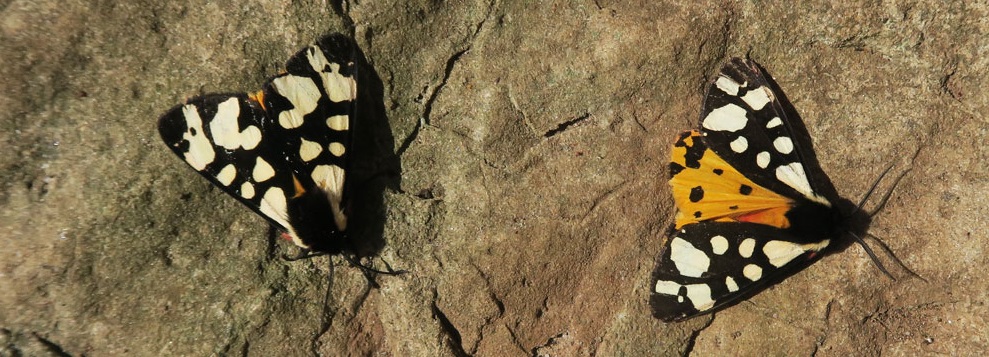 Cream-spot Tigers (photo Stephen Locke)
Cream-spot Tigers (photo Stephen Locke)
MOTH TRAPPING
We were back trapping at the Community Woodland in 2021 and Stephen continues to trap in his own garden and sends us reports of moths caught there. Details of these various mothings are given below. For our equipment and cumulative list of moths, please scroll to the foot of the page.
Thanks to Stephen Locke for the text and all photos (unless otherwise credited).
For the blog post ‘Rearing Puss Moth Larvae’ by Stephen Locke, please click on this link: http://northcurrywildlife.blogspot.com/2020/07/rearing-puss-moth-larvae.html
LATEST POSTS 2024
Moth Trapping, North Curry Garden, 21 March 2024
I put the trap out on Thursday 21 March, with very low expectations as it was quite chilly and rather windy, but it turned out to be quite worthwhile.
Just 10 moths, but 5 species and one of them, Small Eggar, entirely new to me. Not really surprising as its flight season is said to be January–March, and I’ve never actually trapped in March before. But it is nationally scarce, so I’m pleased to have had it. The other interesting one was Dark Sword-grass – an immigrant.
The list was Common Quaker (x2), Dark Sword-grass, Early Grey, Hebrew Character (x5) and Small Eggar.
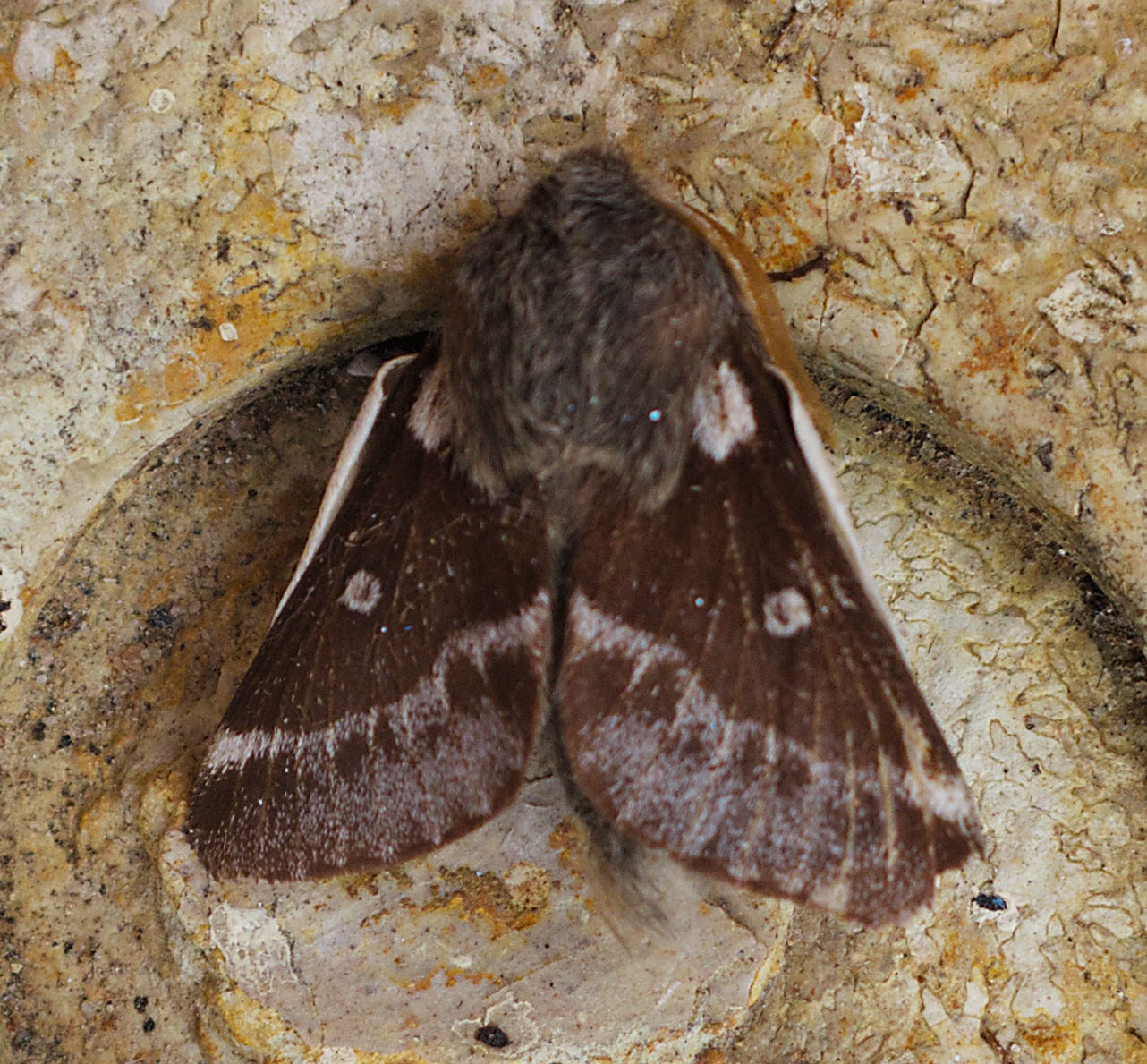 Small Eggar
Small Eggar
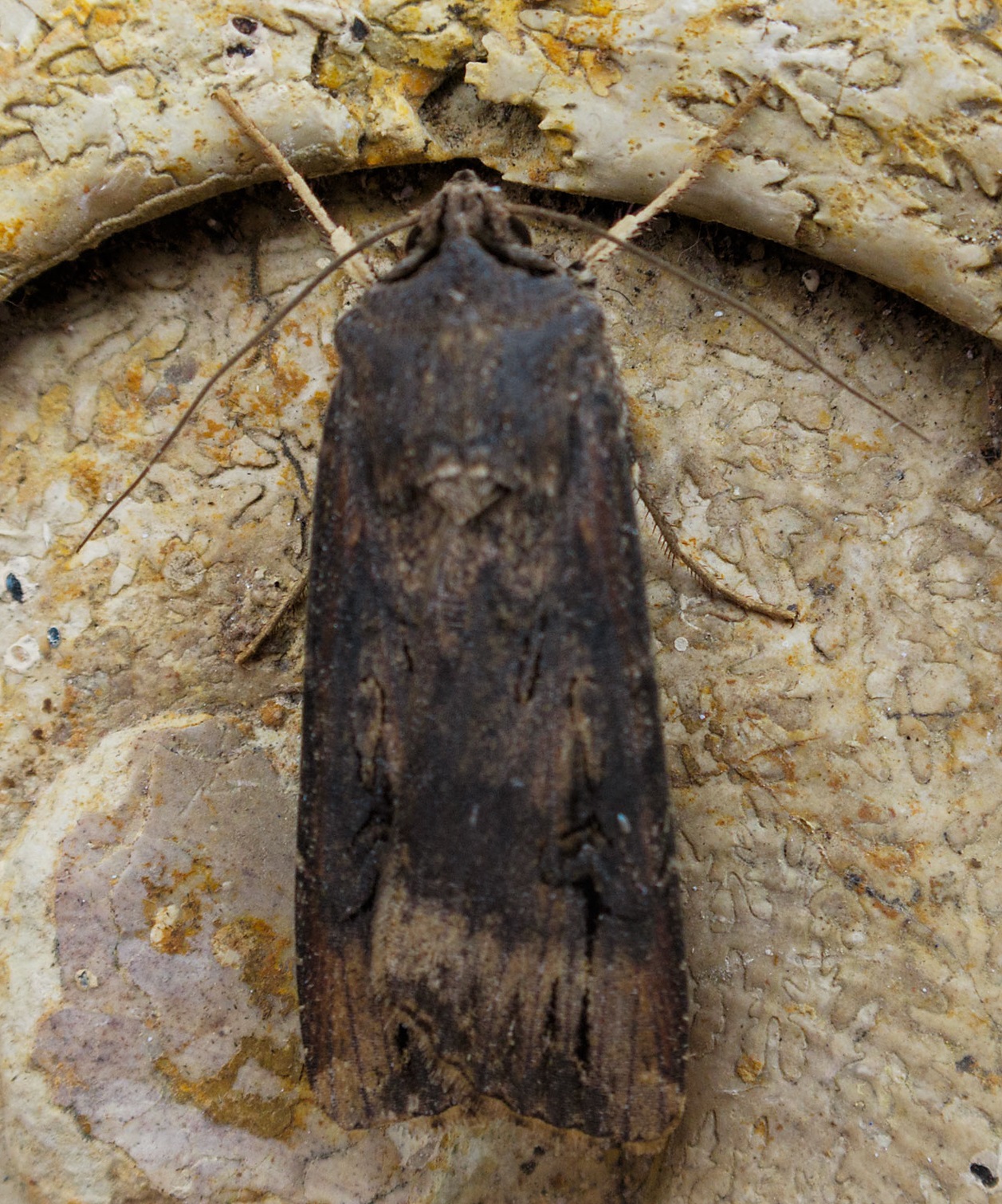
Dark Sword-grass
POSTS 2023
Moth Trapping, North Curry Garden, 13 June 2023
Another couple of Hawkmoths turned up in the trap on 13 June, following the two pristine Eyed Hawkmoths that I had caught on 23 May. This time they were Privet Hawkmoths, one of the largest of our native Hawkmoths, and therefore of our moths overall. It is a splendid moth, with an equally magnificent caterpillar, which I was always hoping to find as a child but rarely did, though they were not uncommon in the privet hedges which surrounded houses in those days!
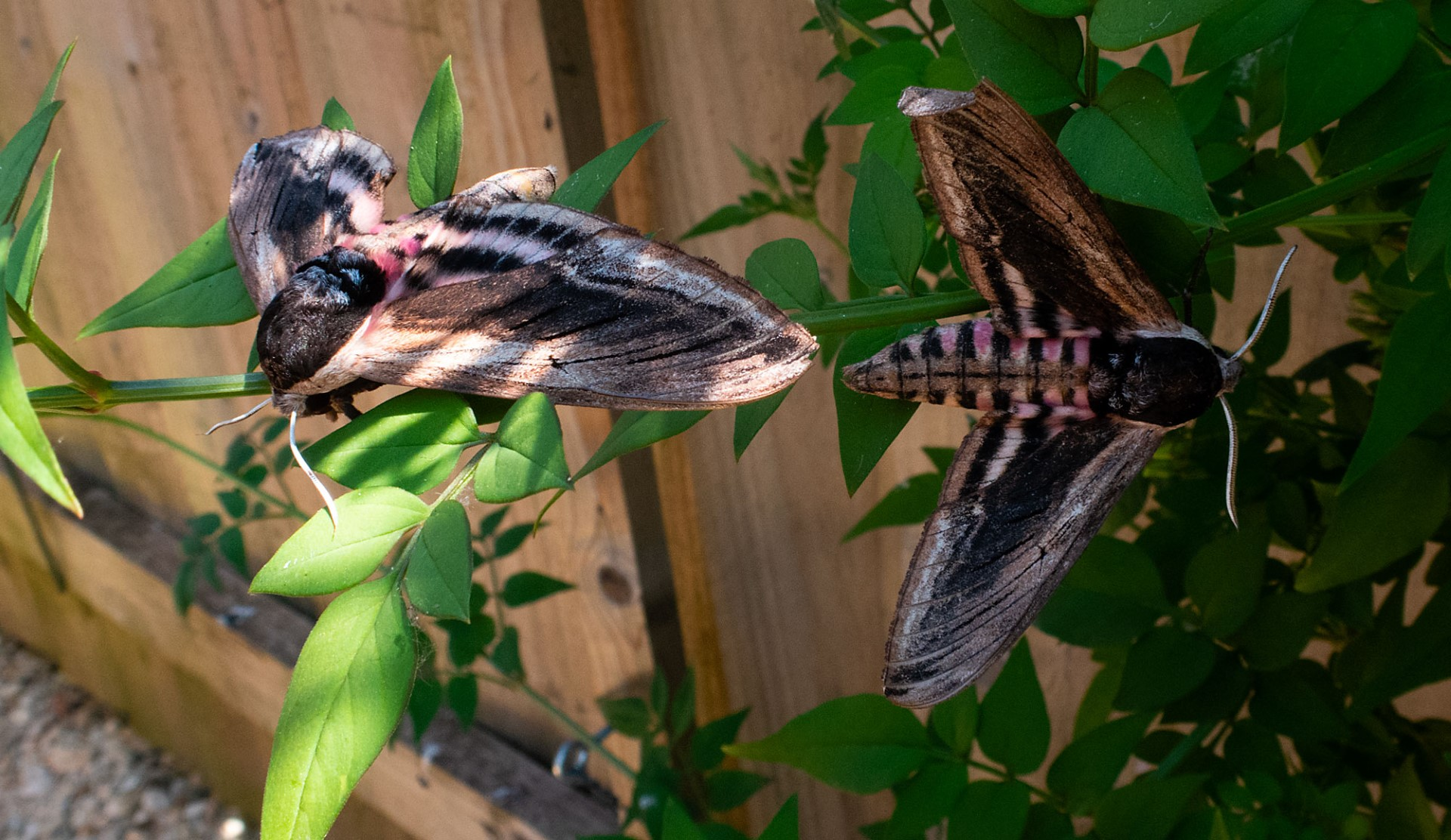 Two Privet Hawkmoths caught on 13 June
Two Privet Hawkmoths caught on 13 June
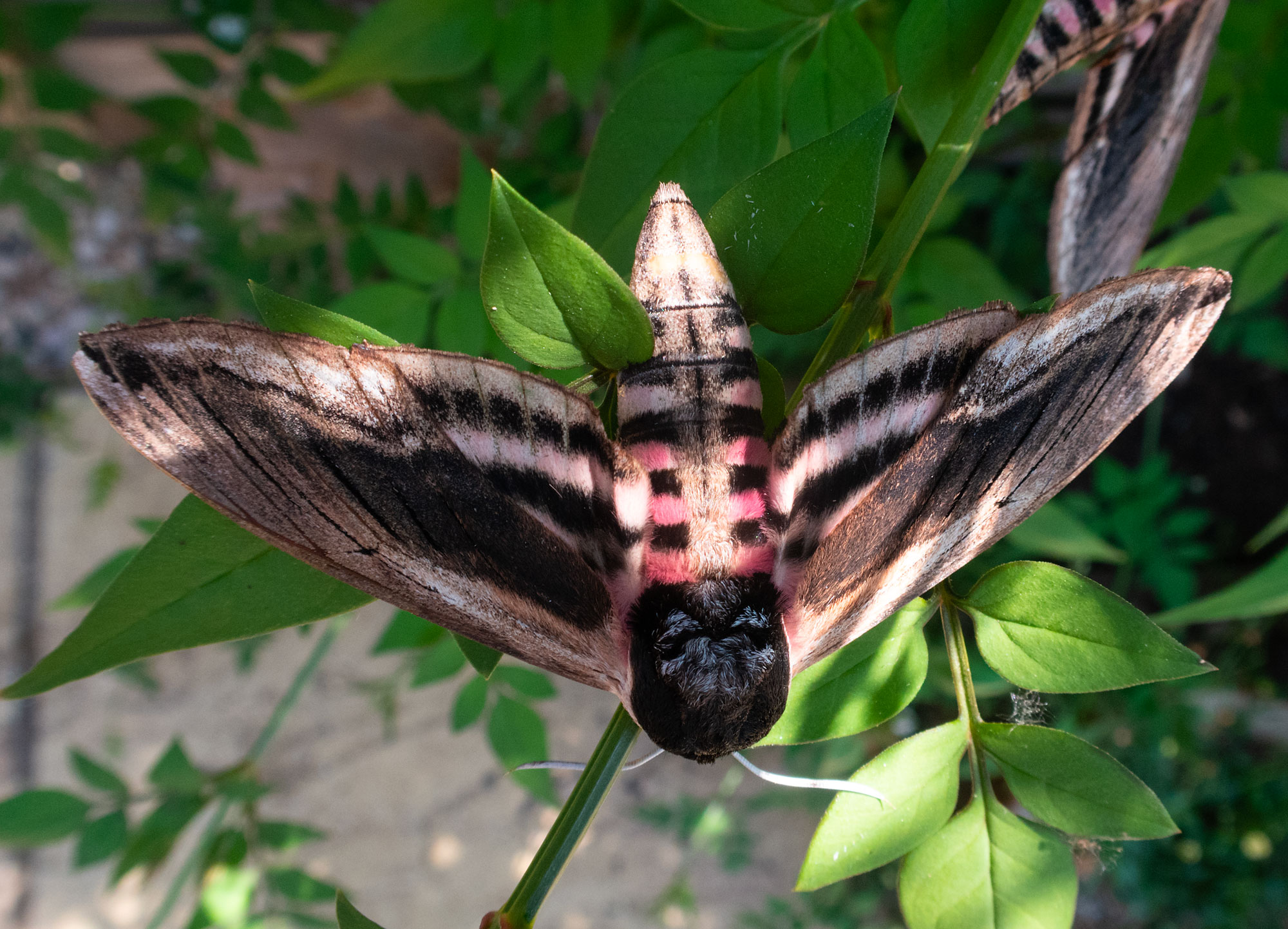
Size is not everything of course, and this warm weather has brought out a variety of moths. There were 105 moths of 35 species on the night the Privet Hawkmoths appeared. This will be an under-counting, as a number will have escaped in the light early morning.
This list was: Beautiful Hook-tip (2), Blue-bordered Carpet, Buff Ermine, Cloaked Minor, Clouded Silver, Common Emerald, Common Marbled Carpet, Common Wainscot (20), Common White Wave, Coronet, Dark Arches, Elephant Hawkmoth, Figure of Eighty, Flame (4), Green Pug, Gold Spot, Heart and Club, Heart and Dart (10), Large Yellow Underwing (10), Marbled Minor (5), Middle-barred Minor, Miller, Mocha (2), Privet Hawkmoth (2), Riband Wave, Rustic, Pale Tussock (2), Scarlet Tiger, Setaceous Hebrew Character (10), Silver Y, Small Yellow Wave, Treble Lines, Treble Brown Spot, Willow Beauty (15).
But most remarkable was not any moth, but hundreds, literally hundreds, of small beetles which I think were probably some species of small water beetle. There were also crowds of micro-moths and assorted ‘gnats’ as well, so something for the House Martins which are now back and nesting again.
Moth Trapping, North Curry Garden, 27 May 2023
I put the moth trap out again on Saturday 27 May but the result was a quiet and slightly dull mothing with 17 moths of 10 species caught, as follows: Broken-barred Carpet, Common Wainscot, Flame Shoulder, Heart and Dart, Lime-speck Pug, Marbled Minor (2), Setaceous Hebrew Character, Shuttle-shaped Dart, Treble Lines (5) and Willow Beauty (3). Treble Lines was again the most numerous, but with fewer trapped than last time.
There can be so many unknown reasons for the numbers of moths trapped – it’s all rather a mystery, I think. The number of escapees, and those moths attracted to the light but which never get into the trap, can be a factor. I had one Common Wainscot – but there must have been more – and it was surprising not to have a Brimstone!
Moth Trapping, North Curry Garden, 23 May 2023
The recent spell of fine weather prompted me to put out the trap on Tuesday 23 May, and two fine Eyed Hawkmoths appeared – by no means exceptional and one would hope for both Eyed and Poplar Hawkmoths at this time of year – but these two moths were in pristine condition.
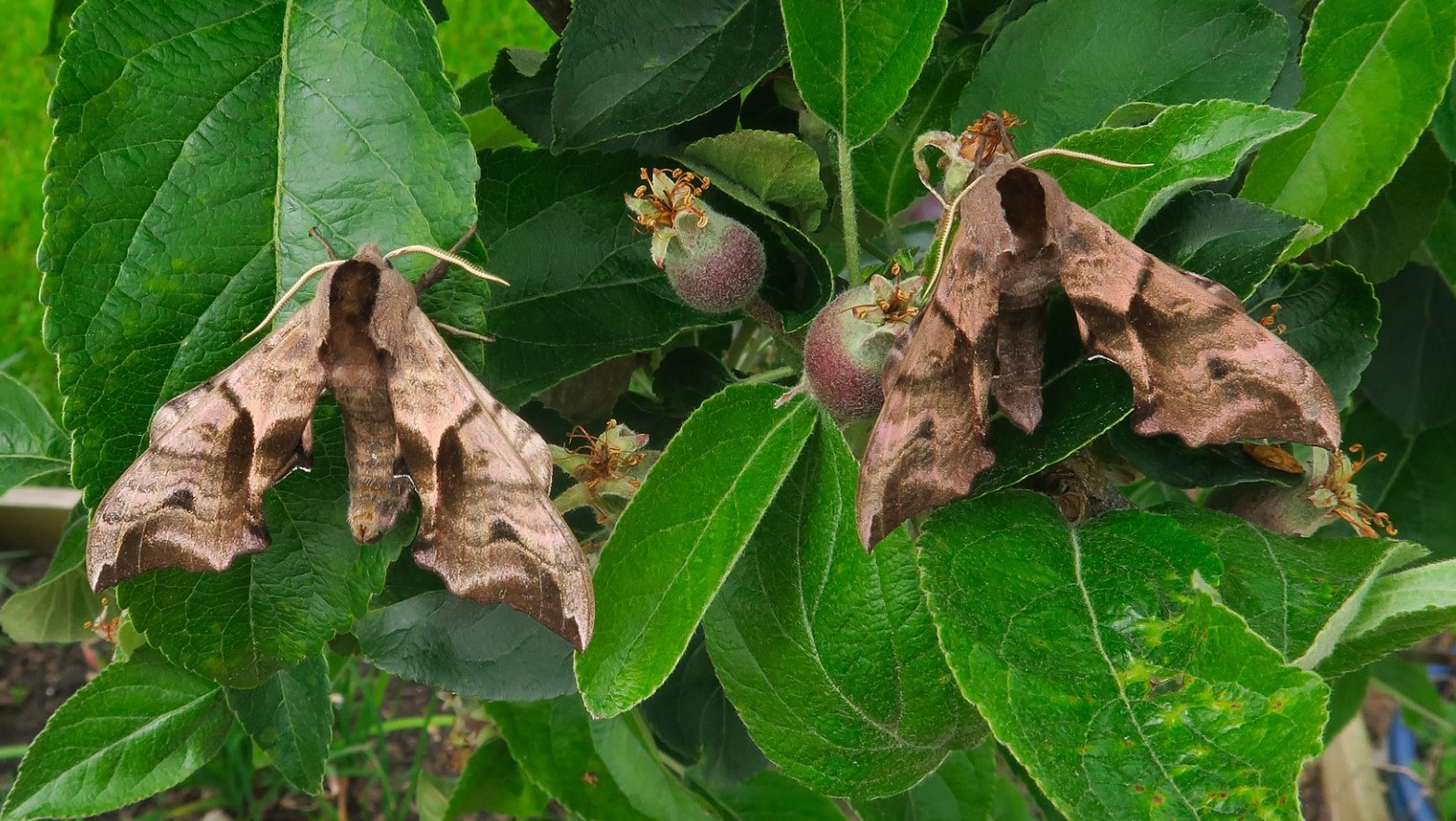 Eyed Hawkmoths
Eyed Hawkmoths
Judging by their behaviour, I think they were both newly emerged females, for when I released them on an apple tree (one of their larval food plants, another being Willow and Sallow, so plenty of food in our neighbourhood), they both curved up their abdomens in a posture characteristic of emitting pheromones to attract a male. They were so engrossed and placid that they barely revealed the ‘eye’ on the underwing that gives them their name, though you can just see one part of the eye in the picture below.
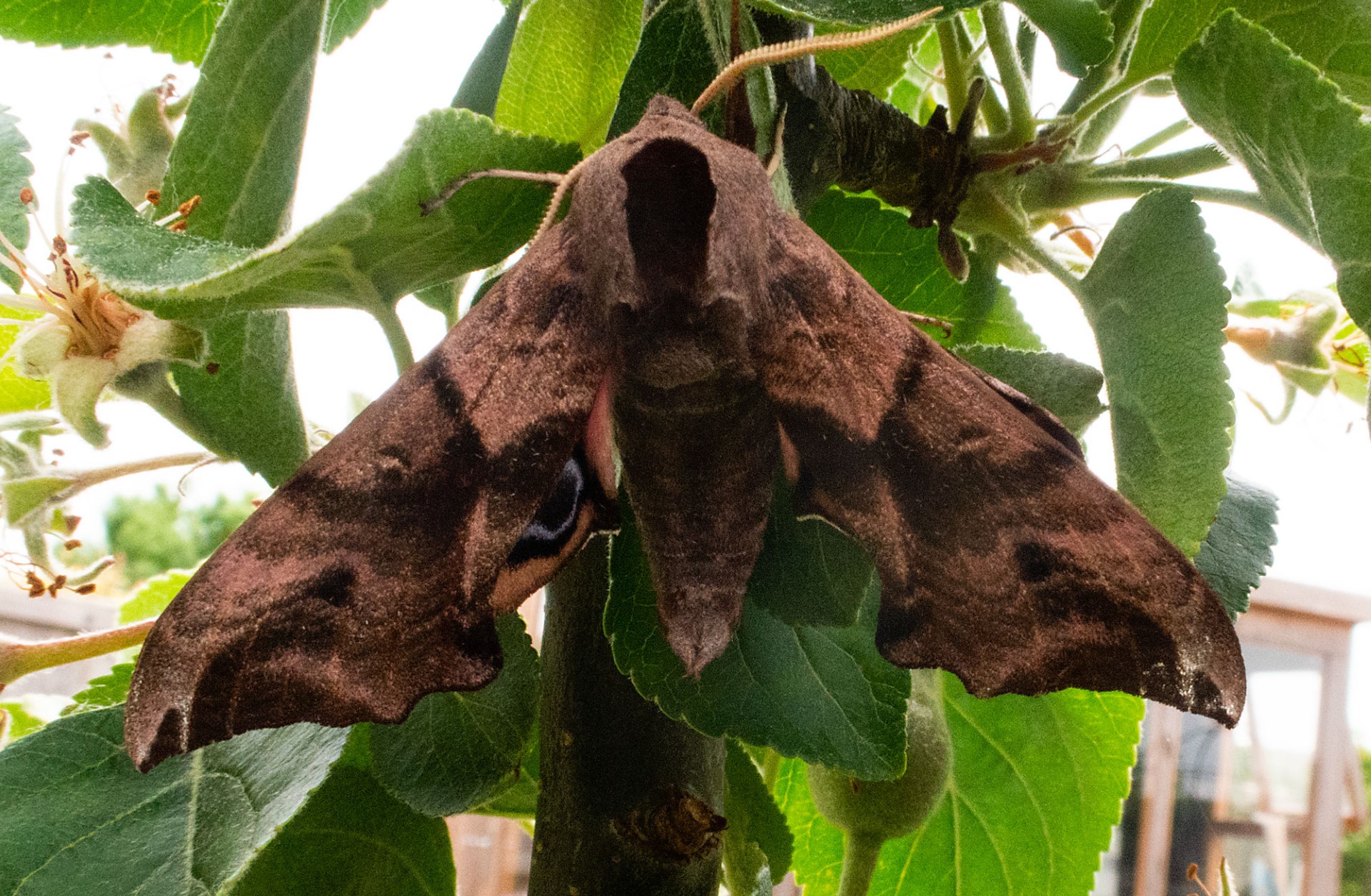 Eyed Hawkmoth revealing part of the eye spot on the underwing that gives it its name
Eyed Hawkmoth revealing part of the eye spot on the underwing that gives it its name
All in all, there were 31 moths of 15 species, with Treble Lines the most numerous. The list was: Brimstone, Buff Ermine, Clouded Silver, Currant Pug, Eyed Hawkmoth (x2), Foxglove Pug, Garden Carpet, Green Carpet (x4), Lime-speck Pug (x2), Pale Tussock (x2), Purple Bar, Shuttle-shaped Dart, Treble Lines (x11), Waved Umber and Willow Beauty. So a productive session.
It is quite usual to find various beetles in a moth trap, which like moths, are attracted to light. At this time of year, Cockchafers (Maybugs) are common, but also this time a Great Silver Water Beetle (Hydrophilus piceus) turned up – one of the largest (if not the largest) British beetles. The beetle in the trap is by no means as large as they can be. Somerset is one of its strongholds as it likes slow-moving, very vegetated water – e.g. rhynes. The adult feeds on vegetation and its larvae predate mainly water snails. It is known to come to light, but I have never had it before.
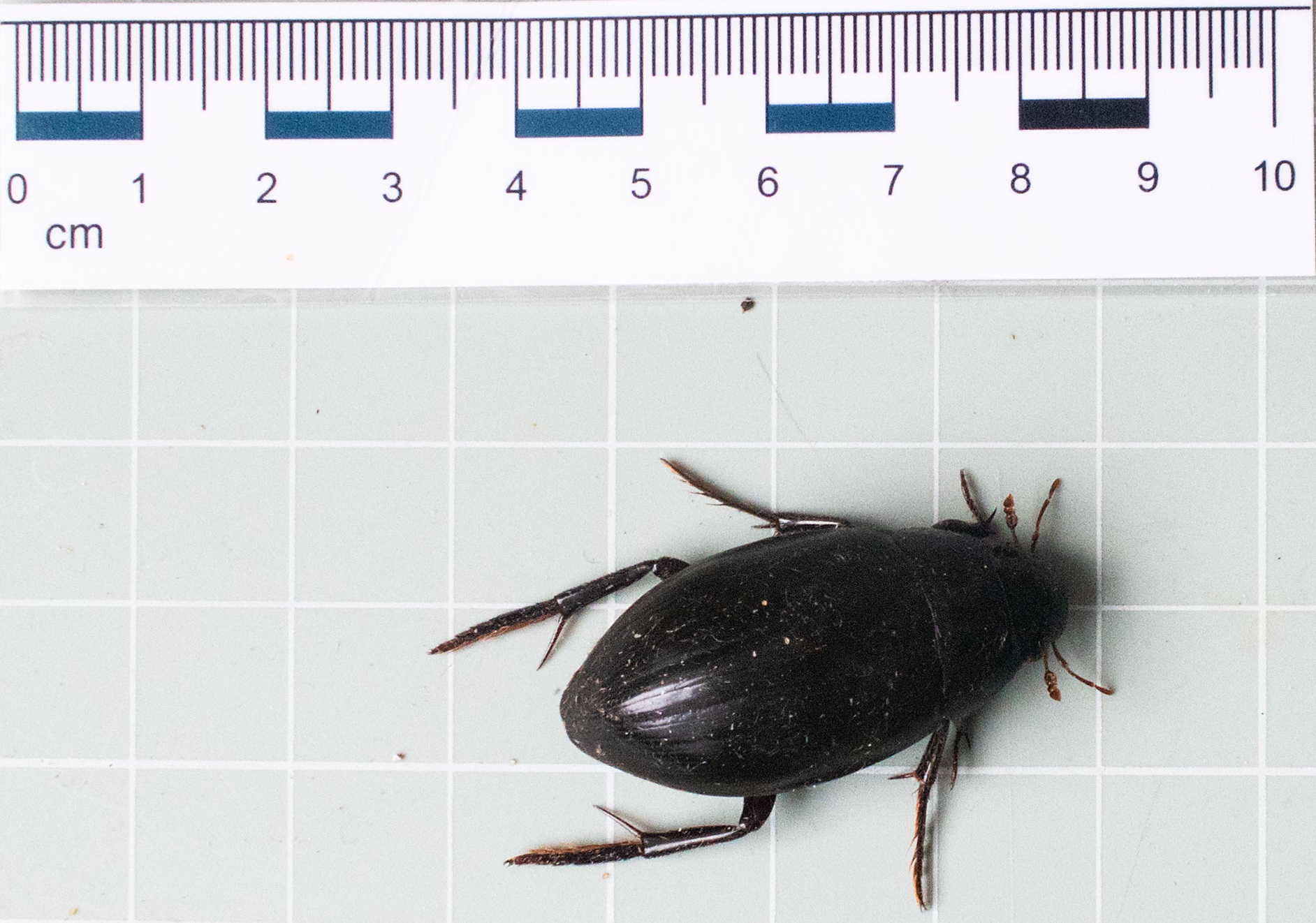 Great Silver Water Beetle (Hydrophilus piceus)
Great Silver Water Beetle (Hydrophilus piceus)
MOTHING 2022
Moth Trapping, North Curry Garden, 21 May 2022
The results of trapping on the night of 21 May 2022 were 18 moths of the following 14 species: Brimstone, Buff Ermine, Campion, Common Marbled Carpet, Common Quaker, Dog’s Tooth, Light Emerald, Maiden’s Blush, Pale Tussock, Peppered Moth, Shuttle-shaped Dart, Spruce Carpet, Treble Lines, Willow Beauty.
Nothing remarkable, but respectable diversity, I think, especially as there were a number of different species from only a few nights ago on 16 May (see report below).
There was another Campion (as illustrated below), and Maiden’s Blush and Spruce Carpet are new for me at North Curry (although I had them in Otterton in Devon), so a worthwhile trapping.
Moth Trapping, North Curry Garden, 16 May 2022
After a slow start to the mothing year, the recent spell of warmer nights prompted me to get going and the night of 16 May produced a nice suite of moths. There was nothing out of the ordinary but, although not numerous, there was a high rate of diversity – 13 species among 17 moths.
The full list was: Buff Ermine, Burnished Brass (x3), Campion, Common Quaker (x2), Coronet, Cream-spot Tiger, Garden Carpet, Green Carpet, Grey Dagger, Hebrew Character, Pebble Prominent, Silver Y, Treble Lines (x2).
Many of them were fresh and in good condition. The Green Carpet fades as it ages, but is a proper green, an unusual colour for a moth, earlier on.
Green Carpet
Likewise, the Campion shows its pinkish/purple mottling when fresh, which helps distinguish it from the very similar Lychnis, but this apparently fades on older specimens. Although a common moth, I have not had a Campion since trapping in North Curry, although I have had several Lychnis.
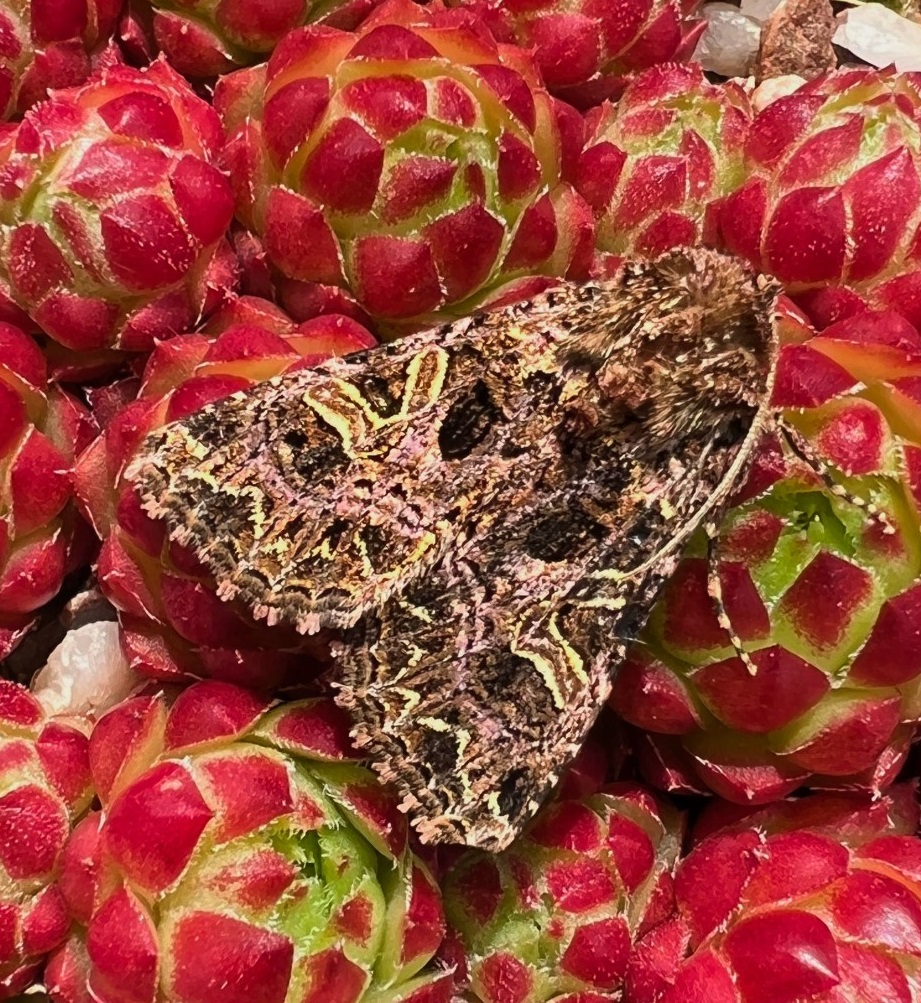 Campion
Campion
The Cream-spot Tiger is a local moth, but seems well established in North Curry (as with other Tigers) and appeared in some numbers last year.
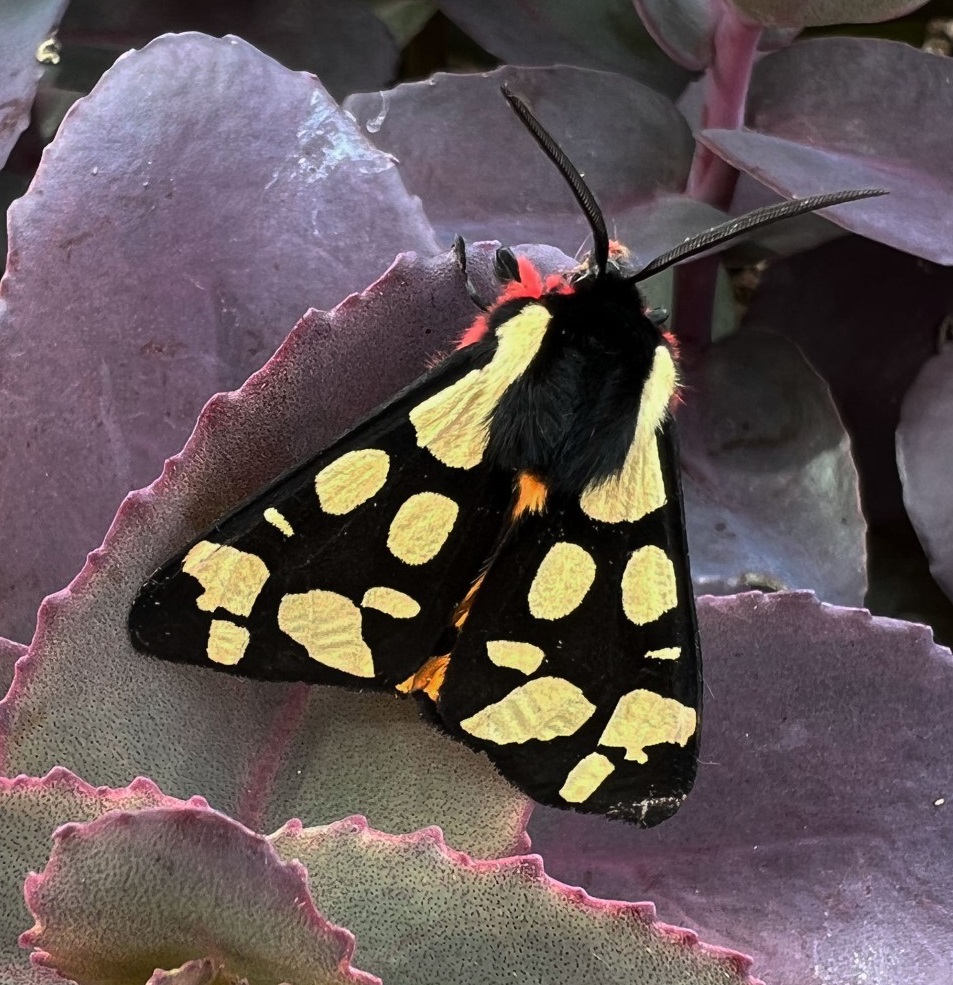 Cream-spot Tiger
Cream-spot Tiger
There were three Burnished Brass, all of them of the form tutti. There is another form, aurea, where the brass patch is fully divided, and when we were in East Devon, aurea was the only form I saw. So it was nice to see the other variety, given that both are pretty spectacular.
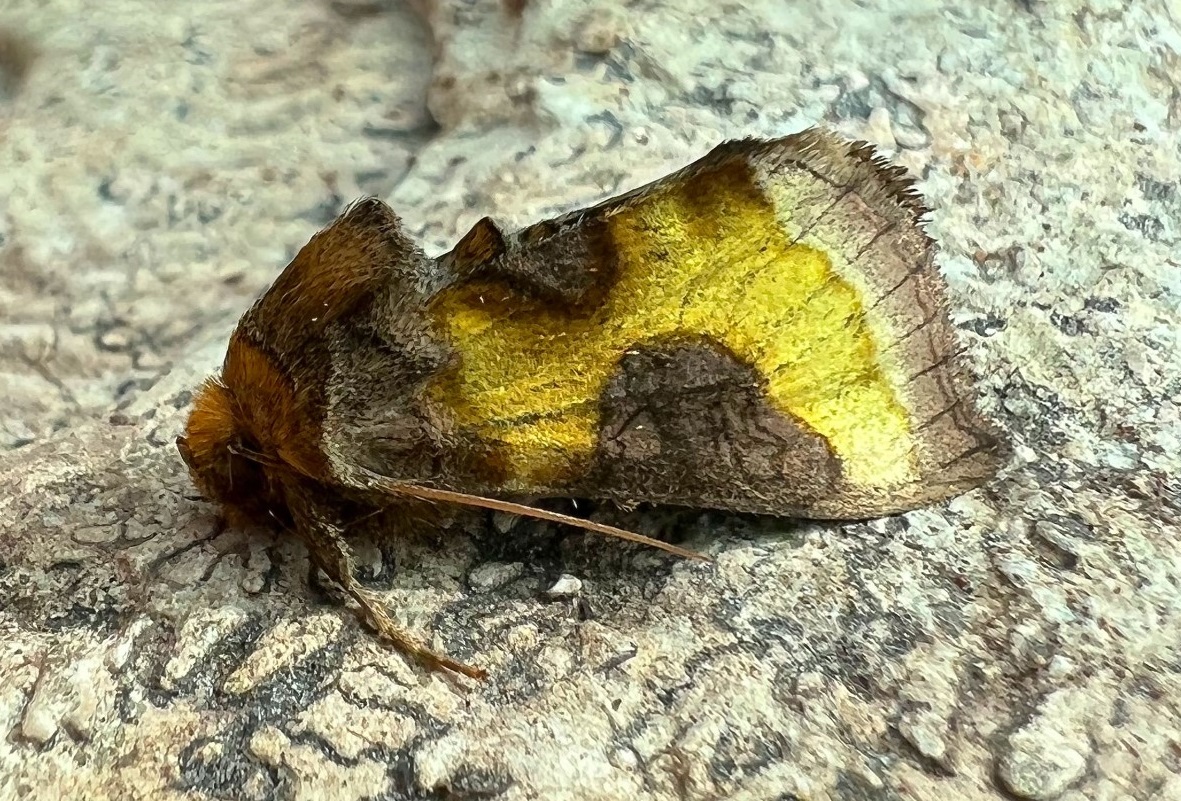 Burnished Brass
Burnished Brass
I was a bit surprised to find a Silver Y this early.
MOTH TRAPPING 2021
Moth Trapping, Community Woodland, 24 August 2021
On Tuesday 24 August, Sarah and I set up two moth traps at the Community Woodland and ran them from 9 to 11.30 pm. Our original intention had been to run the traps in sight of each other, but in the end we put the wildlife group’s trap at the top of the orchard area, and Sarah’s by the butterfly bank – so one at each end of the Community Woodland.
Although the traps are different designs, their lights are similar and because neither was left unattended and both closed down at the same time, the differences in the moths trapped probably relate to the moths present in the immediate neighbourhood rather than the nature of the trap and how it was operated. Received wisdom is that the effective ‘reach' of a moth trap is a max. of 100m, and ours probably less than that, being relatively low-powered. Anyway, the consolidated list of species of macro-moths in both traps was:
Found in both traps:
- Brimstone 5
- Common Carpet 5
- Common Wainscot 2
- Dingy Footman 6
- Flame Shoulder 4
- Grey/Dark Dagger 2
- Jersey Tiger 2
- Lesser Broad-bordered Yellow Underwing 5
- Orange Swift 2
- Six-striped Rustic 2
- Square-spot Rustic 2
- Straw Dot 2
Found only in butterfly bank trap (Robinson actinic):
- Barred Hook-tip 1
- Bright-line Brown-eye 1
- Copper Underwing 1
- Green Carpet 1
- Knot Grass 1
- Large Yellow Underwing 1
- September Thorn 1
- Shaded Broad-bar 1
Found only in orchard trap (Skinner actinic)
- Marbled Green 1
- Purple Bar 1
- Setaceous Hebrew Character 1
- Willow Beauty 2
(52)
Total species counting both traps: 24
Total species butterfly bank: 20
Total species orchard: 16
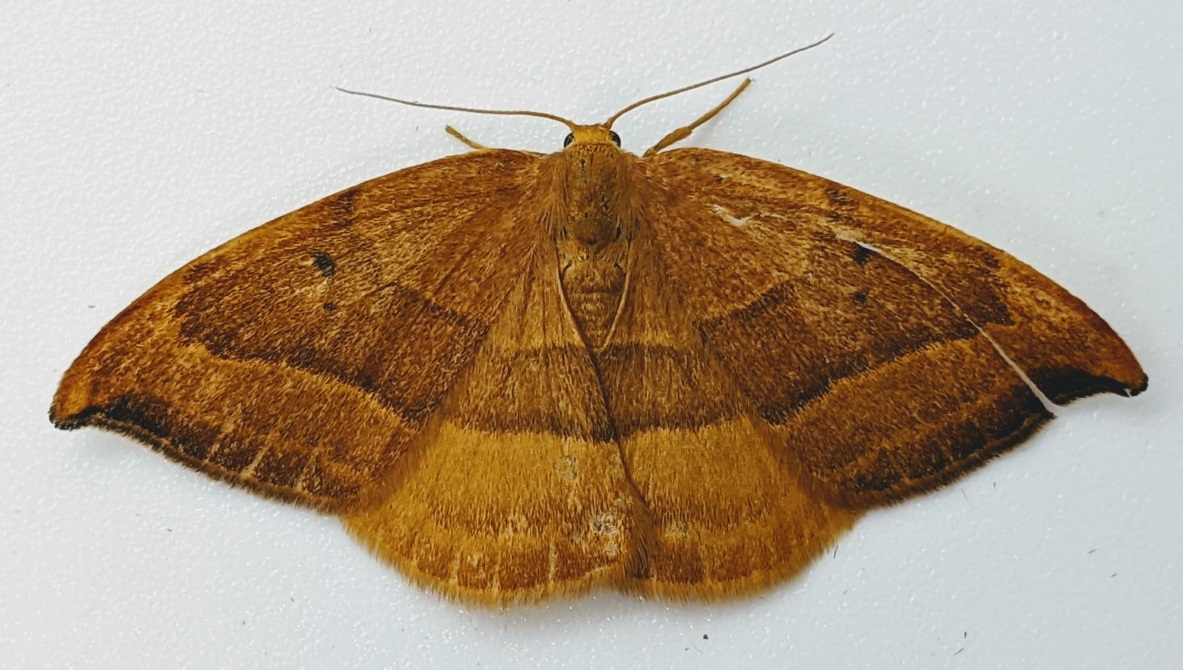 Barred Hook-tip (photo Sarah Shuttleworth)
Barred Hook-tip (photo Sarah Shuttleworth)
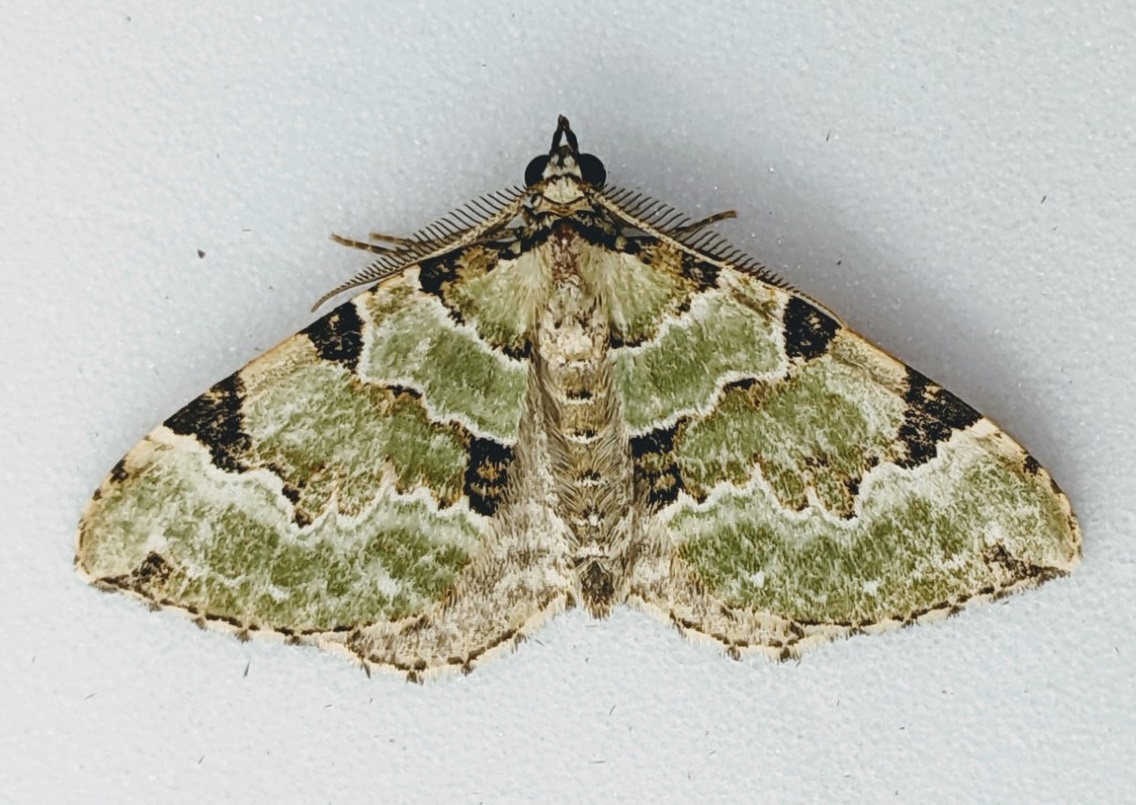 Green Carpet, one of the relatively few green moths (photo Sarah Shuttleworth)
Green Carpet, one of the relatively few green moths (photo Sarah Shuttleworth)
Micro-moths (butterfly bank)
In addition, Sarah recorded 4 species of micro-moths:
- Apple Ermine 1
- Mother of Pearl 1
- Light Brown Apple Moth 1
- Water Veneer 10
(13)
The number of individuals (macro and micro) should not be taken too precisely – neither of us was counting all of the moths that came and went – but generally the numbers could be described as ‘quiet’.
There were differences at each end of the site. The butterfly bank trap had 8 species not trapped at the orchard end. Equally, the orchard trap had 4 species not found at the butterfly bank end.
So only half of all species recorded were present in both traps – the other 50 per cent were divided between one or the other. This suggests that the location of the trap, even in a relatively small area such as the Community Woodland, is significant and should be varied in order to measure the diversity of moths present better.
This is nicely illustrated by Sarah’s record of 10 individuals of the micro-moth Water Veneer. This is one of only a handful (four, I think) of British moths which are aquatic. The larvae feed on pond weed (including the much-maligned Canadian pondweed) up to 2m deep and hibernate and pupate under water. The females are wingless and when they hatch stay on the surface of the water until mated by the winged males before laying eggs to continue the cycle.
Extraordinary – but a common moth in ponds and still or slowly moving water. Males may emerge in large numbers and are attracted to light, and I suppose those Sarah recorded had recently emerged from the pond. A trap in just the orchard might well have failed to attract them. Also yet another example of the wildlife value of ponds.
Water Veneer are widespread and one wonders how they spread between water bodies if the females are wingless? One reference I have seen says that some winged females are produced, and may be larger than the males, which would make sense if their purpose was to fly to new water bodies? Regrettably for such an interesting moth, its appearance is dull as well as small.
Orange Swift, found in both traps, seem much around at the moment, in several colour forms. Their larvae live underground for two years, feeding on the roots of perennial plants – yet another example of the wide range of feeding strategies demonstrated by moths.
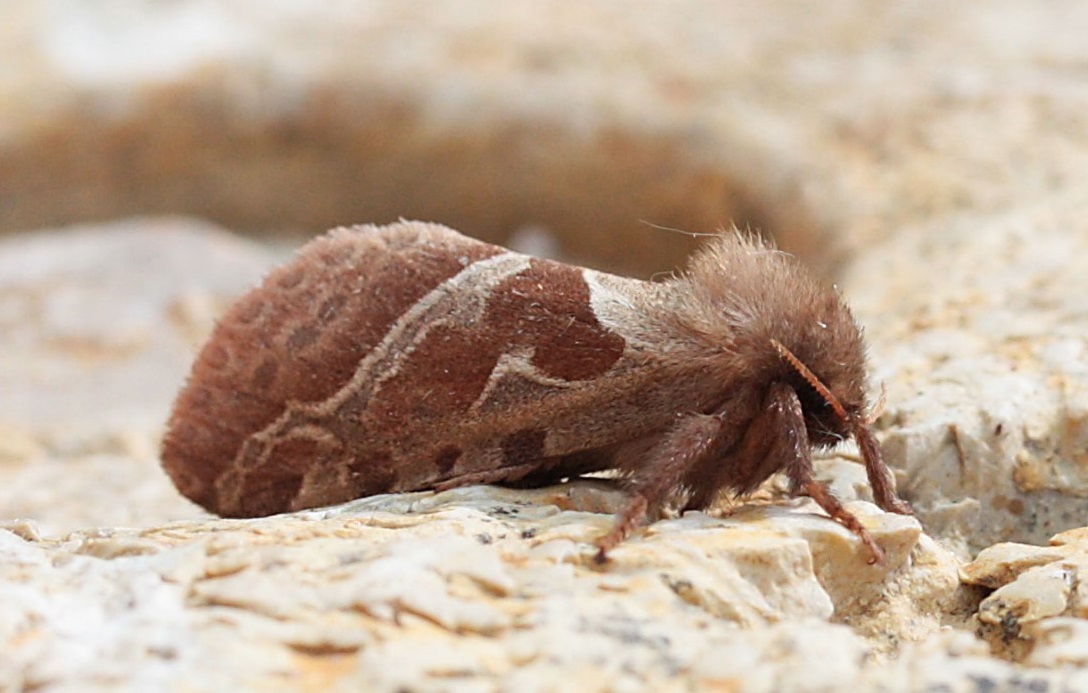 Orange Swift
Orange Swift
Moth trapping returns to the Community Woodland:
Moth Trapping, Community Woodland, 4 August 2021
On an impulse, and just before the weather turned, I thought it was high time I set the trap in the Community Woodland. The nearest anniversary of previous trapping at the Woodland to this date was 3 August 2019, such has been the distraction of Covid.
Anyway, the result on Wednesday night, between 9 and 11.30 pm, was 31 species of moth and no less than 132 individuals. This compares to 18 species in 2019, but this kind of comparison is pretty meaningless for a single occasion – conditions were pretty much ideal on Wednesday.
The full list was: August Thorn, Brimstone (5), Common Carpet (3), Common Emerald (2), Common Footman (>50), Common Wainscot (3), Coronet (2), Dark Arches, Dark Brocade, Drinker (5), Elephant Hawkmoth, Garden Carpet, Gold Spot, Grey Dagger, July Belle, Large Yellow Underwing (2), Lesser Broad-bordered Yellow Underwing (>30), Lesser Cream Wave, Lime-speck Pug, Magpie, Mocha, Nut-tree Tussock, Oak Eggar, Rosy Footman (3), Ruby Tiger (4), Scorched Carpet (2), Shuttle-shaped Dart, Silver Y, Square-spot Rustic, Willow Beauty (2), Yellow Tail (2) (>132 moths of 31 species).
The numbers of by far the most numerous moths – Common Footman and Lesser Broad-bordered Yellow Underwing – are very approximate and just given to indicate something like their relative abundance. Probably all the moths are, if anything, undercounted, as the vast majority were counted on the sheet and not in the trap itself. I will have missed quite a few, and have not attempted the micro-moths or ‘difficult’ pugs! I think this is a very respectable and encouraging record: nothing special (although the Mocha is nationally scarce), but with a wide diversity of moth families represented and good numbers.
I was observed throughout by a Magpie moth, which is more often seen by day (when it is sometimes mistaken for a butterfly) which is, however, sometimes attracted to light.
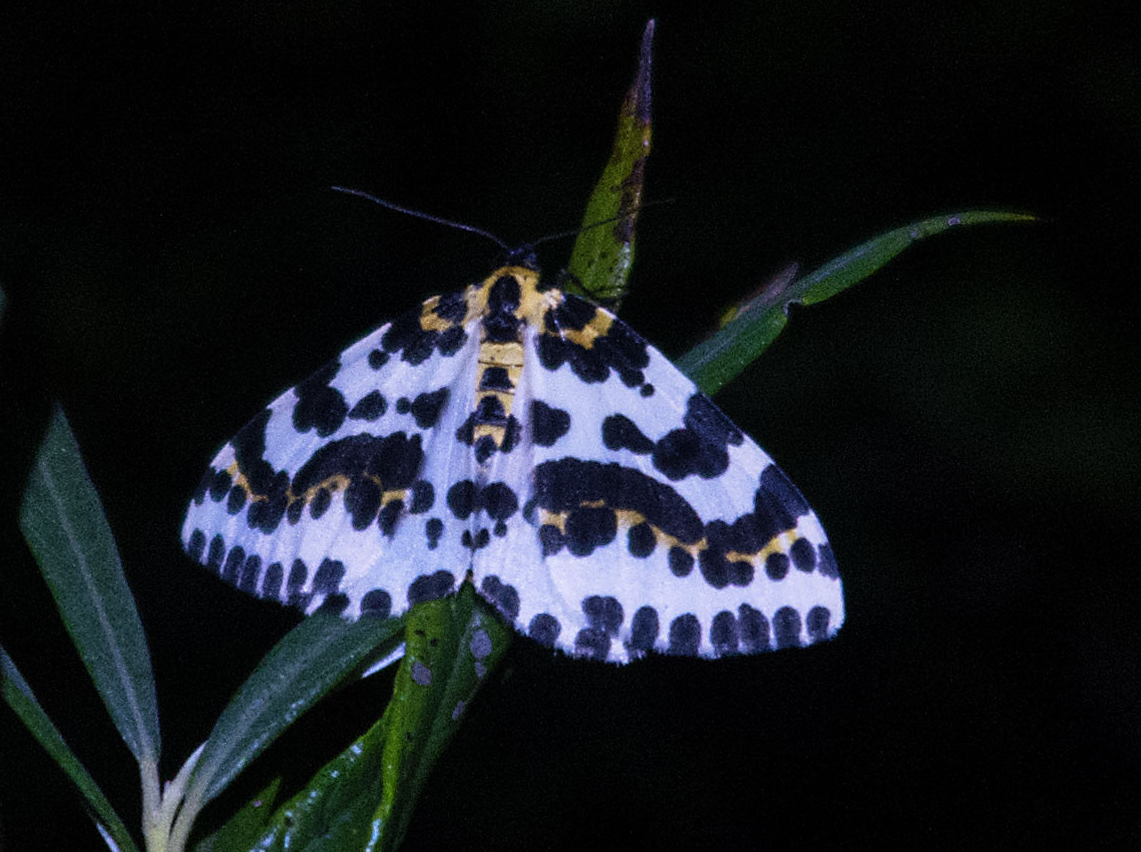 Magpie
Magpie
During the restrictions of the coronavirus pandemic, Stephen set the moth trap in his own garden and sent us regular reports:
Moth Trapping, North Curry Garden, 12 July 2021
I have mentioned moth colouration previously, especially warning colouration, but a couple of moths I have seen recently show this so well, I thought it worth sharing some pictures.
The first is a Six-spot Burnet, a day-flying moth which can be seen at the Community Woodland and is common enough in the right place at the right time, in this case Burton Cliff, Dorset, on 16 July, when there were scores nectaring on Ragwort.
.jpg?timestamp=1627212286858) Six-spot Burnet nectaring on Ragwort
Six-spot Burnet nectaring on Ragwort
The other is Garden Tiger, one of two individuals which came to my trap on 12 July. I know every other moth-er in the neighbourhood has had Garden Tiger, but this is a first for me in North Curry, so I am very pleased now to have had the full suite of Tigers that one could reasonably expect.
.jpg?timestamp=1627212382931) Garden Tiger showing both warning colouration on hind wings and distraction colouration on upper wings
Garden Tiger showing both warning colouration on hind wings and distraction colouration on upper wings
Both moths, although with different colours in detail, are displaying striking examples of characteristic warning colouration (black/yellow/red = I taste nasty) and in the case of the Garden Tiger, distraction camouflage on the upper wings.
The full list of moths caught on Monday 12 July in a central North Curry garden is as follows: Barred Straw, Bright-line Brown-eye, Brimstone, Buff-tip, Chinese Character, Common Footman, Common Wainscot, Coronet, Dark Arches, Dot Moth, Early Thorn, Elephant Hawkmoth, Flame, Garden Tiger, Grey Dagger, Heart and Club, Heart and Dart, Large Yellow Underwing, Lesser Yellow Underwing, Minor, Nutmeg, Orange Moth, Riband Wave, Rustic/Uncertain, Setaceous Hebrew Character, Shoulder-striped Wainscot, Small Dusty Wave, Swallow-tailed Moth, Willow Beauty (96 moths of 30 species).
Moth Trapping, North Curry Garden, 10 June 2021
The continuing warmer and quieter weather is improving the number of moths coming to my trap. On the night of 10 June, there were 40 moths of 16 species. In reality, significantly more will have been attracted to the light, since many moths never enter the trap and quite a few make their escape before they can be counted. It is always important to check resting places nearby for moths which settle without entering the trap.
One such on 10 June was a Peppered Moth. Not at all a rarity but a notable moth as probably the most referred-to moth because it demonstrates visible and rapid evolution by natural selection. You may well be familiar with this, but if not, the basic story goes as follows.
The Peppered Moth exists in two colour forms, a lighter and darker, controlled by a single mutation. The darker (melanic) form rapidly increased in numbers during the industrial revolution in industrial areas, while the lighter (typical) form became much rarer. This was due to selective predation by birds of the lighter colour form which became increasingly conspicuous against polluted (smoke-blackened) surfaces, relative to the darker form, in the nineteenth century. This change in frequency applied only in industrial areas and the situation has been reversed since the 1950s and the clean air acts, and the melanic form is now rare.
This is the simplest of summaries of what is actually a highly complex situation, but it remains a textbook example of evolution by natural selection. As such, it is the target of creationists, careless or devious journalists, and others of similar ilk, who have selectively exploited the scientific research and debate about the complex mechanisms involved in this evolution to cast doubt on its reality and by extension, Darwinian evolution generally.
Anybody interested, and with enough time to spare (so perhaps nobody!), will find a whole chapter on this in the New Naturalist Moths by Michael Majerus (2002). Majerus’ final comment is worth quoting: ‘The critics of work in this case and those who have cast doubt on its validity are, without exception, persons who have, as far as I know, never bred the moth and never conducted an experiment on it. In most cases they have probably never seen a live Peppered moth in the wild. Perhaps those who have the most intimate knowledge of the moth are the scientists who have bred it, watched it, studied it, in both the laboratory and the wild [the names of ten eminent entomologists are given]. I believe that, without exception, it is our view that the case of melanism in the Peppered moth still stands as one of the best examples of evolution, by natural selection, in action.’
So, after all that, here is a picture of a North Curry rural, typical Peppered Moth. I have never seen the melanic form outside of a museum collection.
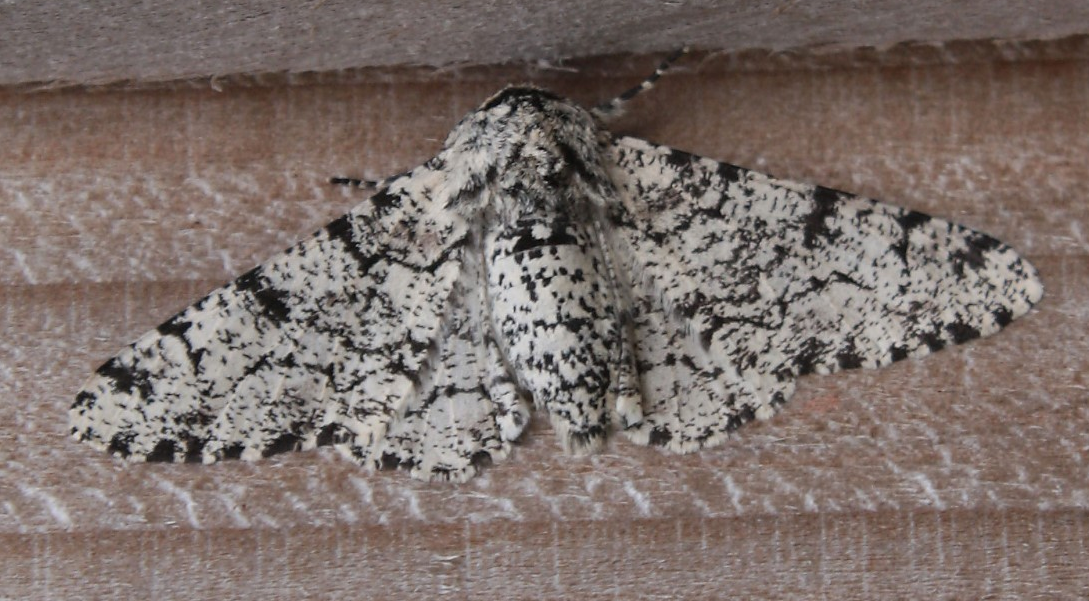 Peppered Moth
Peppered Moth
The full list of moths for 10 June was: Alder Moth, Common Swift, Common Wainscot, Cream-spot Tiger, Flame, Flame Shoulder, Green Carpet, Grey Dagger, Heart and Dart (the most numerous), Marbled Minor, Peppered Moth, Shuttle-shaped Dart, Small Square-spot, Treble Brown Spot, White Ermine, Willow Beauty (40 moths of 16 spp).
Alder Moth is not a common moth and was a new species for me.
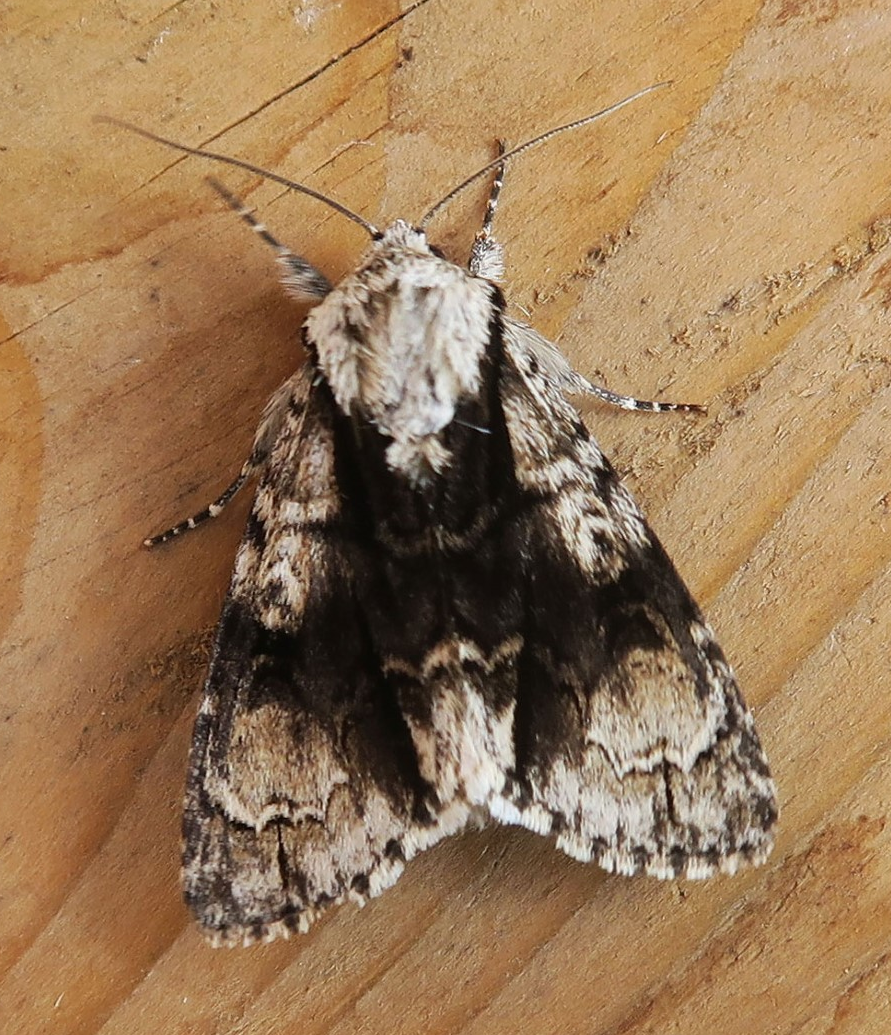 Alder Moth
Alder Moth
Moth Trapping, North Curry Garden, 30 May 2021
It has been a long time since I last put the trap out. It has been such discouraging weather and moth counts everywhere have been reported as low. But this warmer weather has improved things and Sunday night 30 May produced 25 moths of 14 species, albeit nothing specially notable.
The most numerous were Treble Lines, a distinctive and aptly named moth, but quite variable as the two pictures below show.
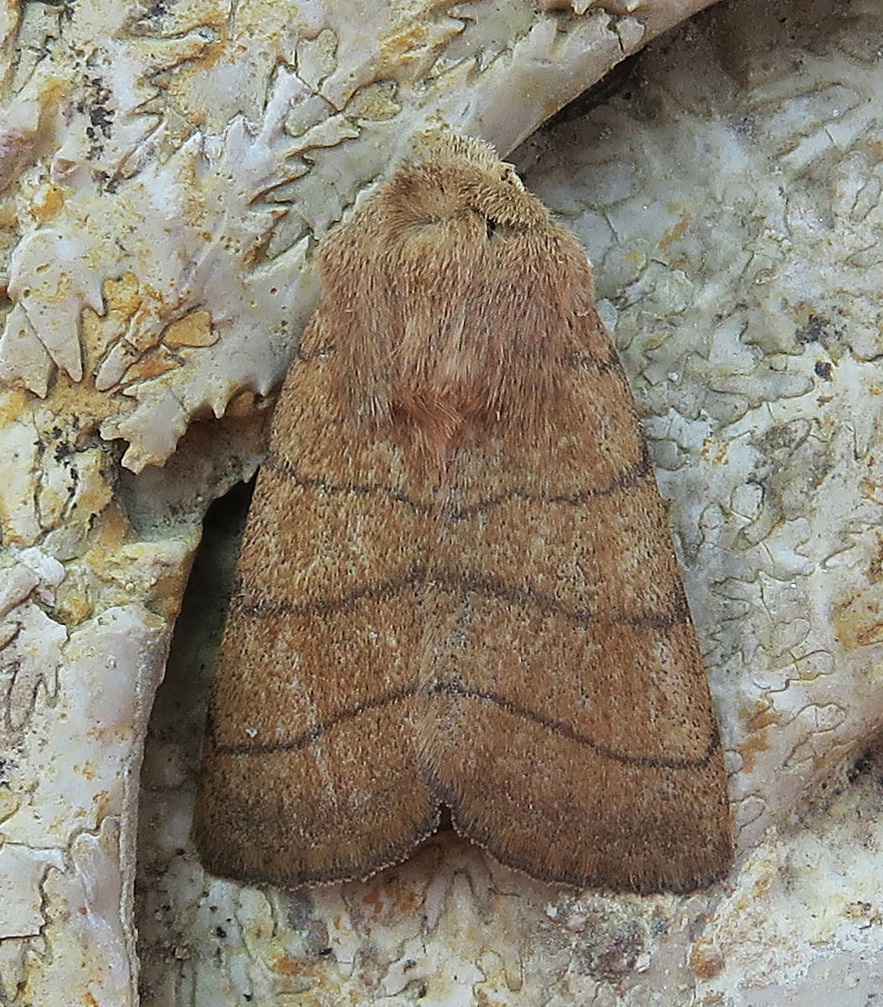
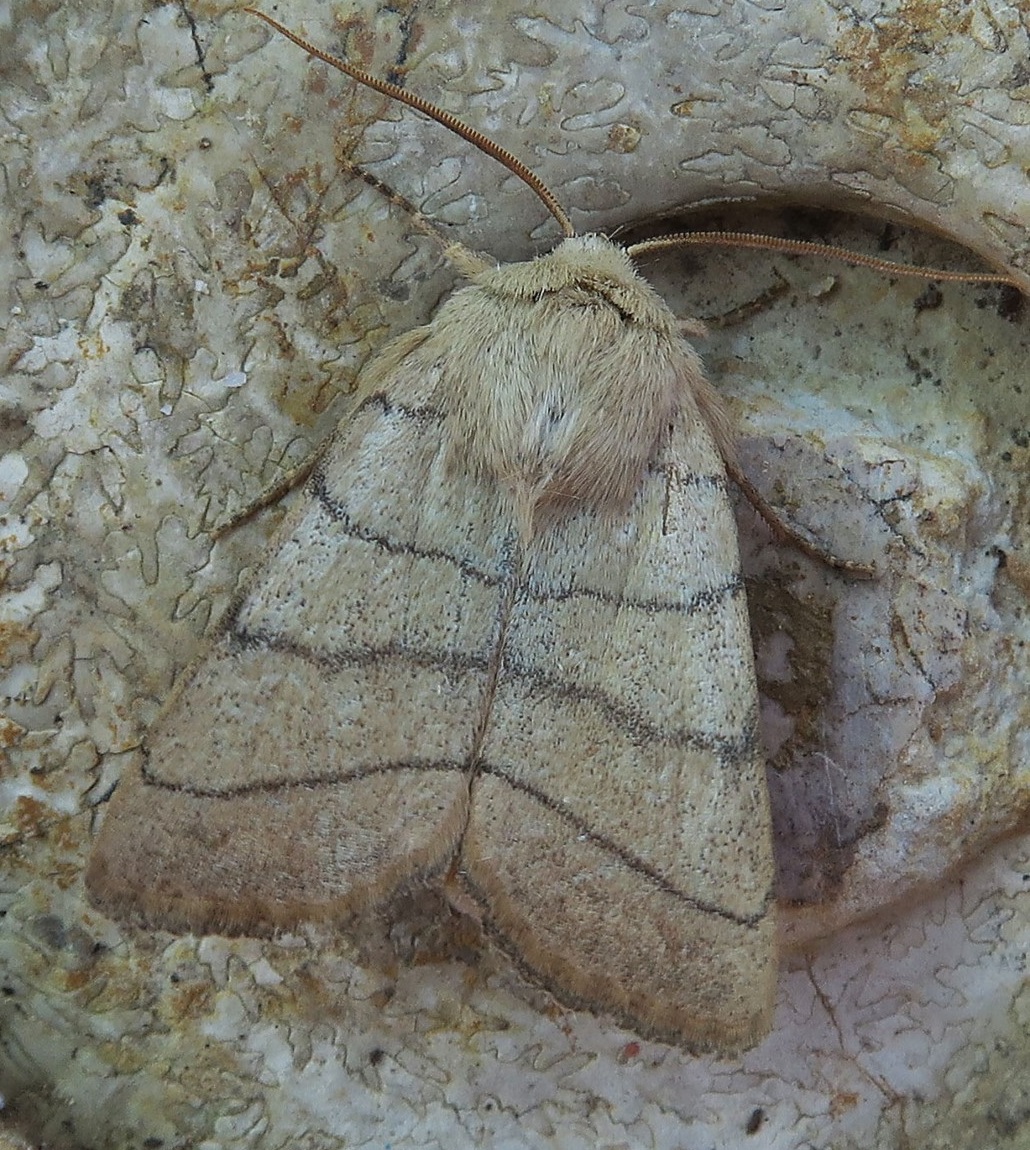 Treble Lines colour variations
Treble Lines colour variations
Angle Shades is an attractive species which I thought was worth a picture.
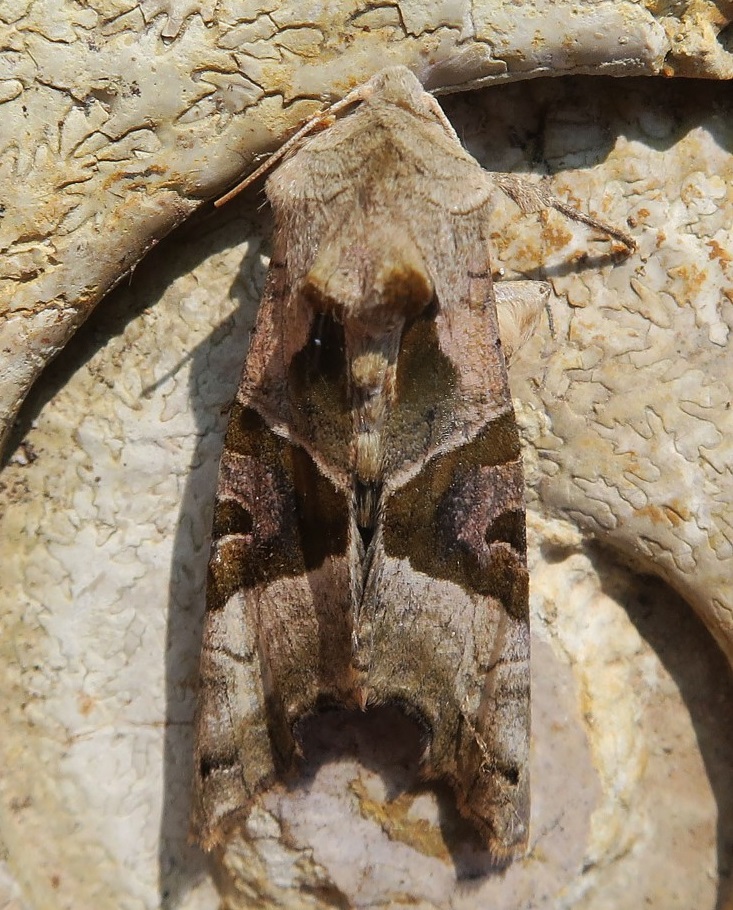
Angle Shades
The full list was: Angle Shades, Beautiful Brocade, Buff-tip, Common Marbled Carpet, Common Quaker, Flame Shoulder, Knot Grass, Lychnis, Muslin Moth, Shuttle-shaped Dart, Silver-ground Carpet, Small Square-spot, Treble Lines and Willow Beauty.
The Puss Moth pupae continue to hatch – three of six to date. I won’t include a picture of each one, but I thought this one justified its name.
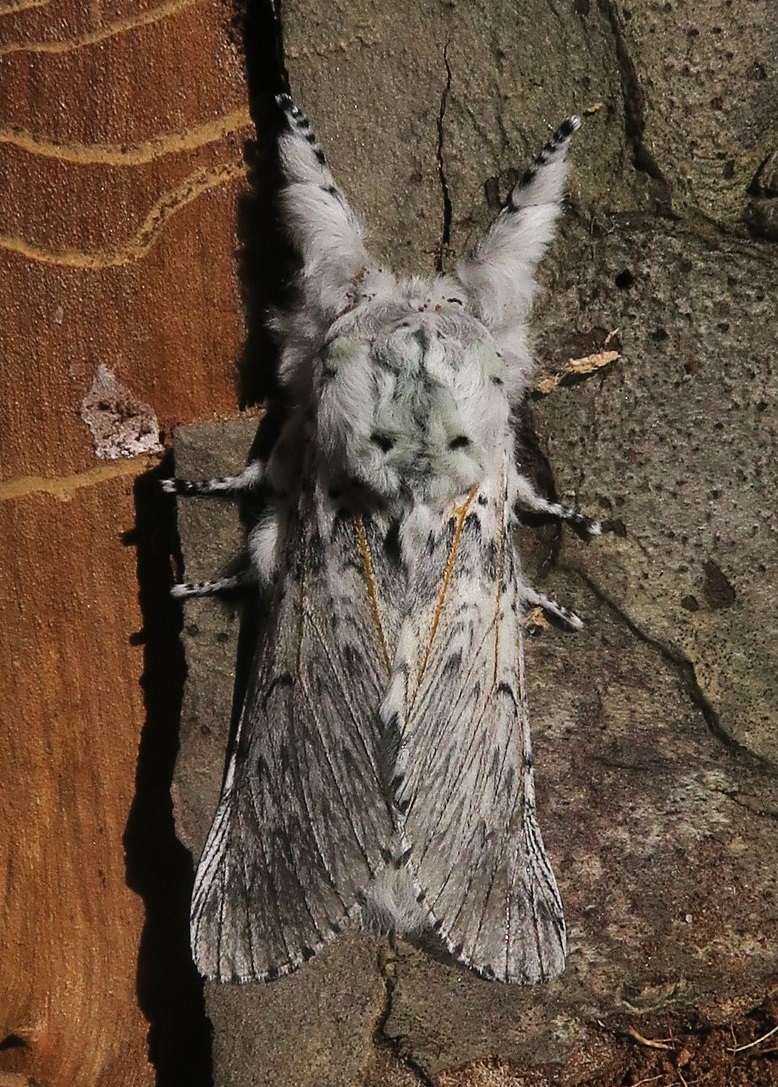 Puss Moth: one of three to hatch so far from six pupae
Puss Moth: one of three to hatch so far from six pupae
Moth Trapping, North Curry Garden, 30 March 2021
With the rather warmer weather, moths are becoming more active and numerous, so I thought a selection of Spring moths which came to my trap in Lockyers Field on Tuesday 30 March would be good to start the mothing year.
Chief among them was Dotted Chestnut, which is designated Nationally Scarce (recorded from 31–100 10km squares across the country since 1980) so, unsurprisingly, it is a new moth for me. The County Moth Recorder does say it is more frequent in Somerset than elsewhere, but a good record for a garden – especially, I think, a new garden in a new housing estate.
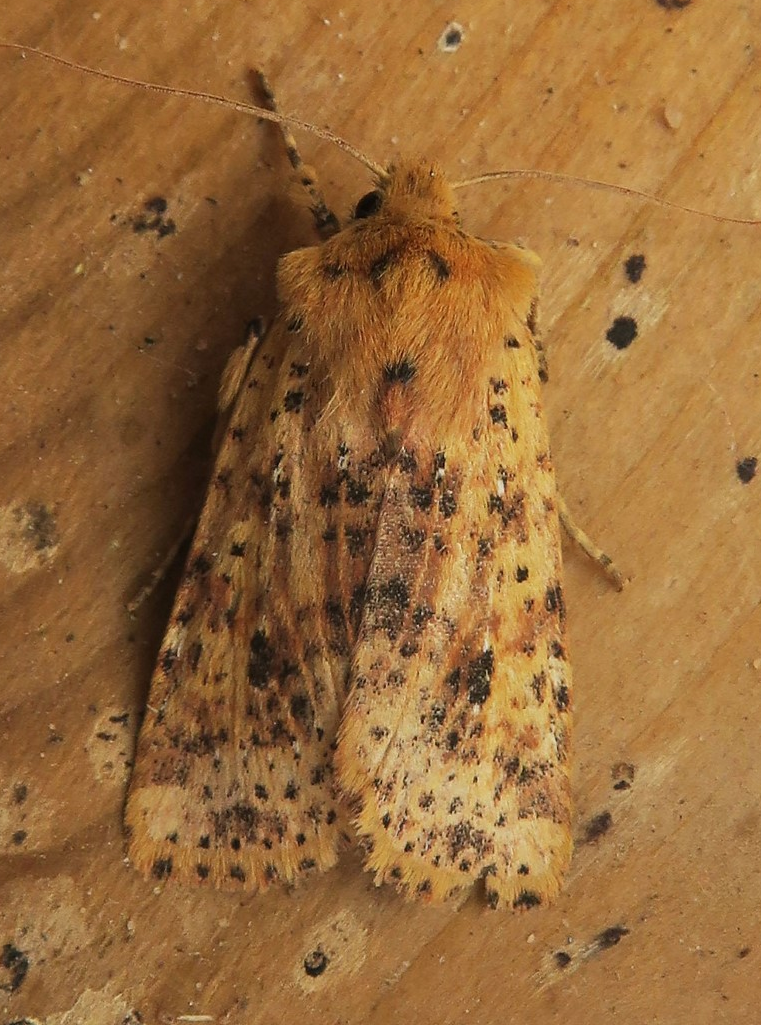 Dotted Chestnut
Dotted Chestnut
The Chestnuts as a group are characteristically autumn and early winter moths, but the Dotted Chestnut reappears in the Spring.
The pictures below show some more common moths that came to the trap: Early Grey, Brindled Beauty and Early Thorn.
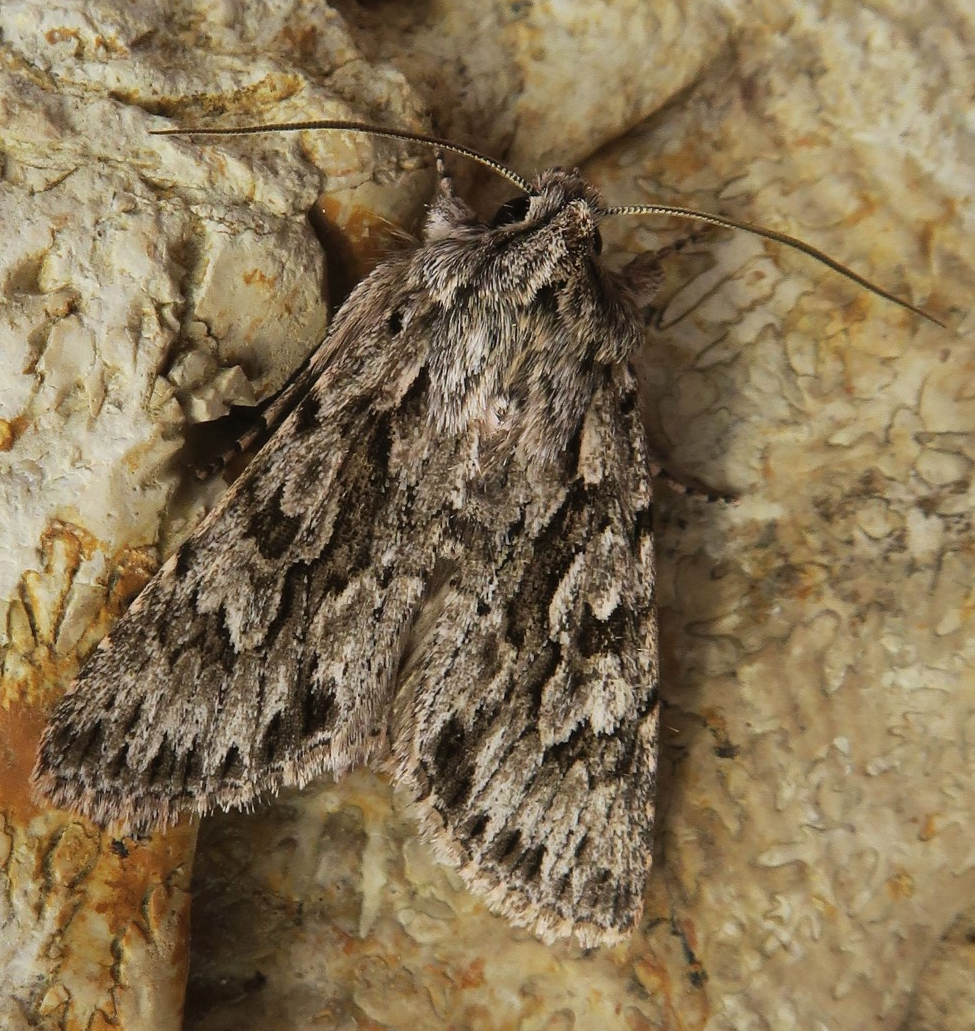 Early Grey
Early Grey
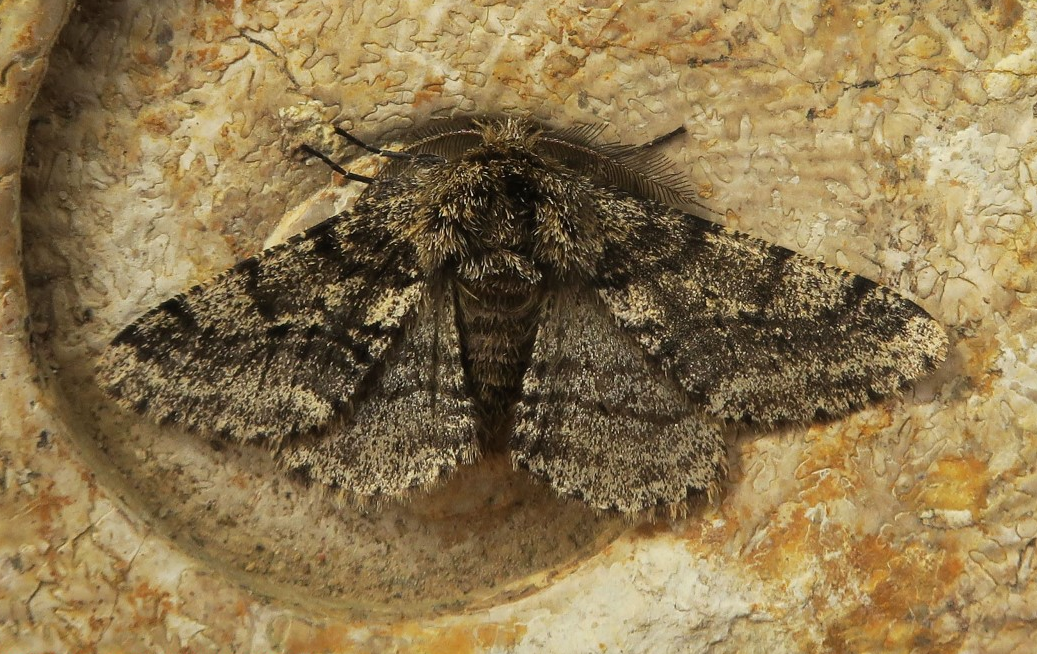 Brindled Beauty
Brindled Beauty
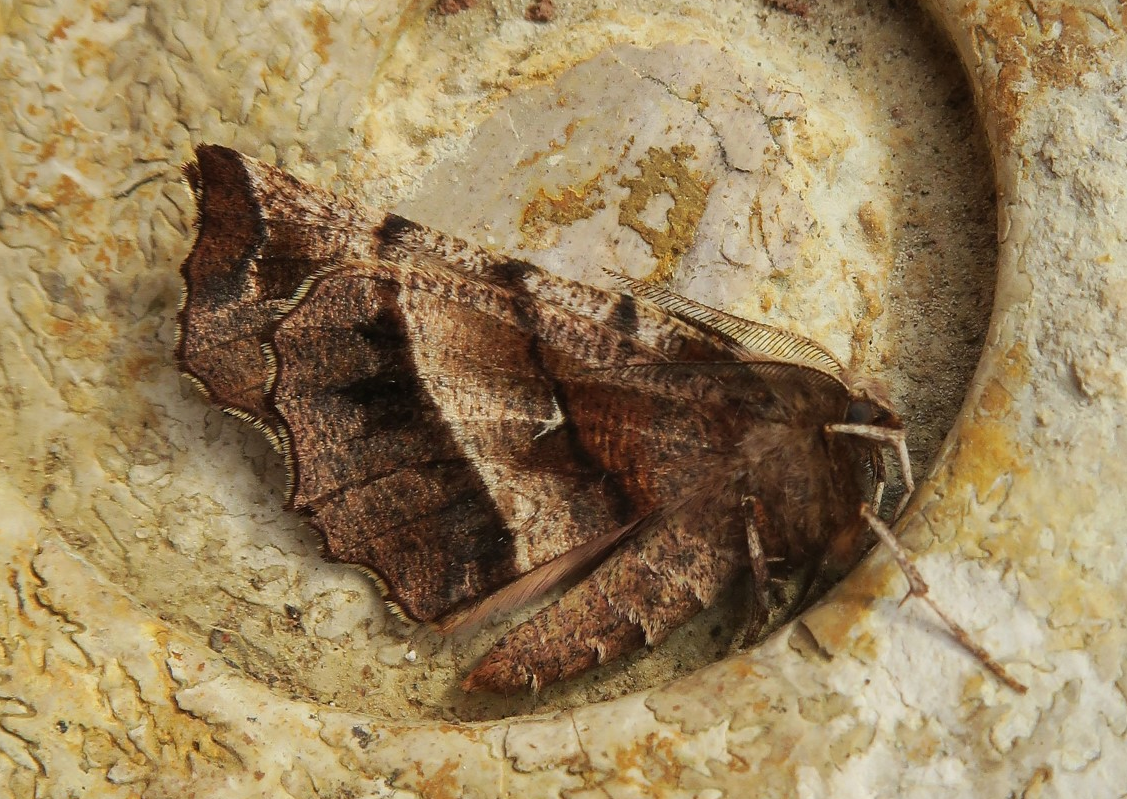 Early Thorn
Early Thorn
Early Thorn is the first of the Thorns – of which we get all the species in North Curry – and is characterised by always resting with its wings tightly closed – as it is pictured here clinging to the inner wall of an ammonite (also local!).
The full list was (16 moths of 9 species): Brindled Beauty (x2), Chinese Character, Common Quaker (x3), Dotted Chestnut , Early Grey (x2), Early Thorn (x2), Hebrew Character (x3), Knot Grass, Nut-tree Tussock.
MOTH TRAPPING 2020
Moth Trapping, North Curry Garden, 10 November 2020
I put the trap out last night on the spur of the moment, perhaps with a view to attracting a November Moth in mind, and had just three moths (interestingly, two of them on the sheet). It turned wet and windy during the night which wouldn’t have helped. Among the three were December Moth, which is new for me, although common, but I have rarely trapped this late in the year previously.
 December Moth
December Moth
The December Moth is a rather smart moth which I was pleased to see. It belongs to the same family as the Lappets and Eggars (we had Lappet and Oak Eggar last year in the Community Woodland), furry, thickset moths. None of this family is able to feed as adults. Despite its name, the December Moth hasn’t really appeared early – its flight season is late October to January.
Another Mottled Umber turned up and I have put its photo alongside the one which came to the light a few days ago, just to show the great variation which this species demonstrates. The recent moth (on the left), with clear wing markings, is perhaps the more typical.
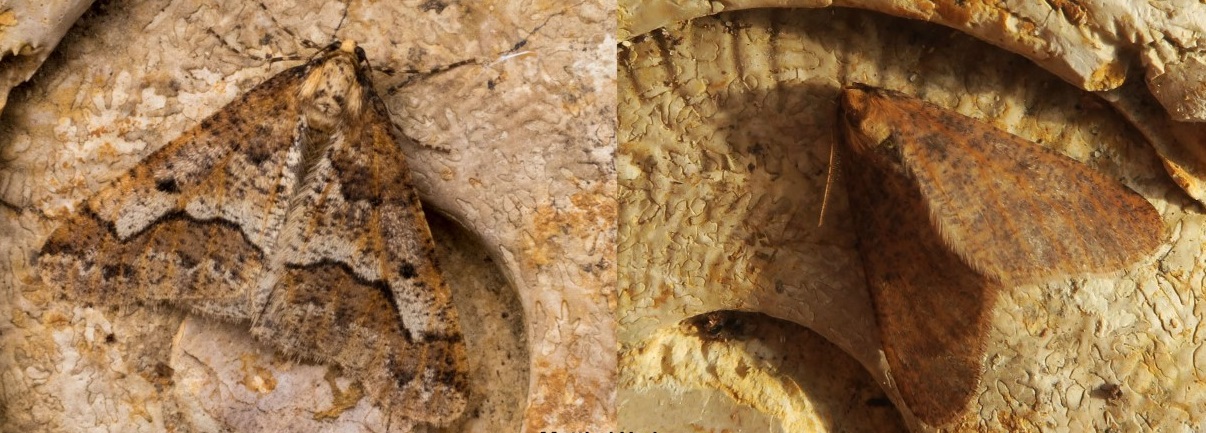 Mottled Umber showing variation
Mottled Umber showing variation
The third moth was Red-line Quaker, which I am learning to respect as a moth not to be defeated by British weather!
Moth Trapping, North Curry Garden, 7 November 2020
This spell of quiet and relatively mild weather has provided an opportunity to see what moths may be flying this late in the year. Obviously, numbers will be fewer, as moths hunker down for the winter or, more commonly, overwinter as eggs, caterpillars or pupae, but there are some around, and suitably enough, in autumn colours. So here are some pictures of three species which came to my trap on Saturday night.
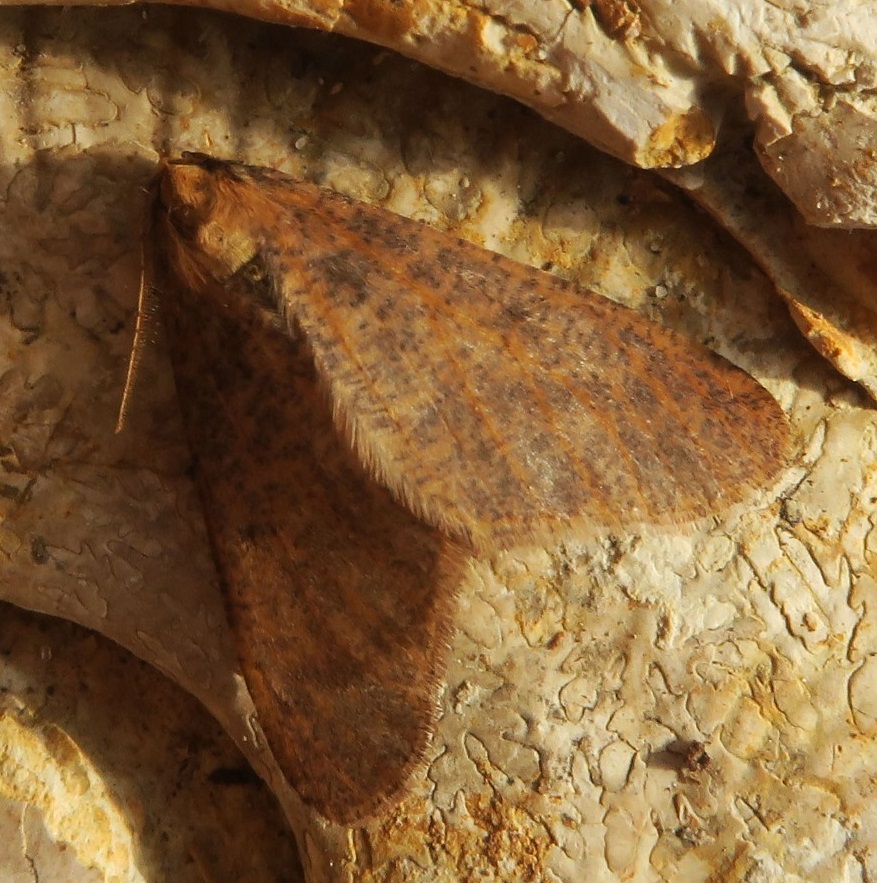 Mottled Umber (male)
Mottled Umber (male)
Mottled Umber is a highly variable moth, so don’t be surprised if you see illustrations in moth guidebooks very differently marked. This individual is a rather plain form – others have much more noticeable wing markings. All of them that come to light are males. The females are wingless and wait for a male to find them – a not uncommon strategy which must be effective because it is shared by a number of the commonest moths.
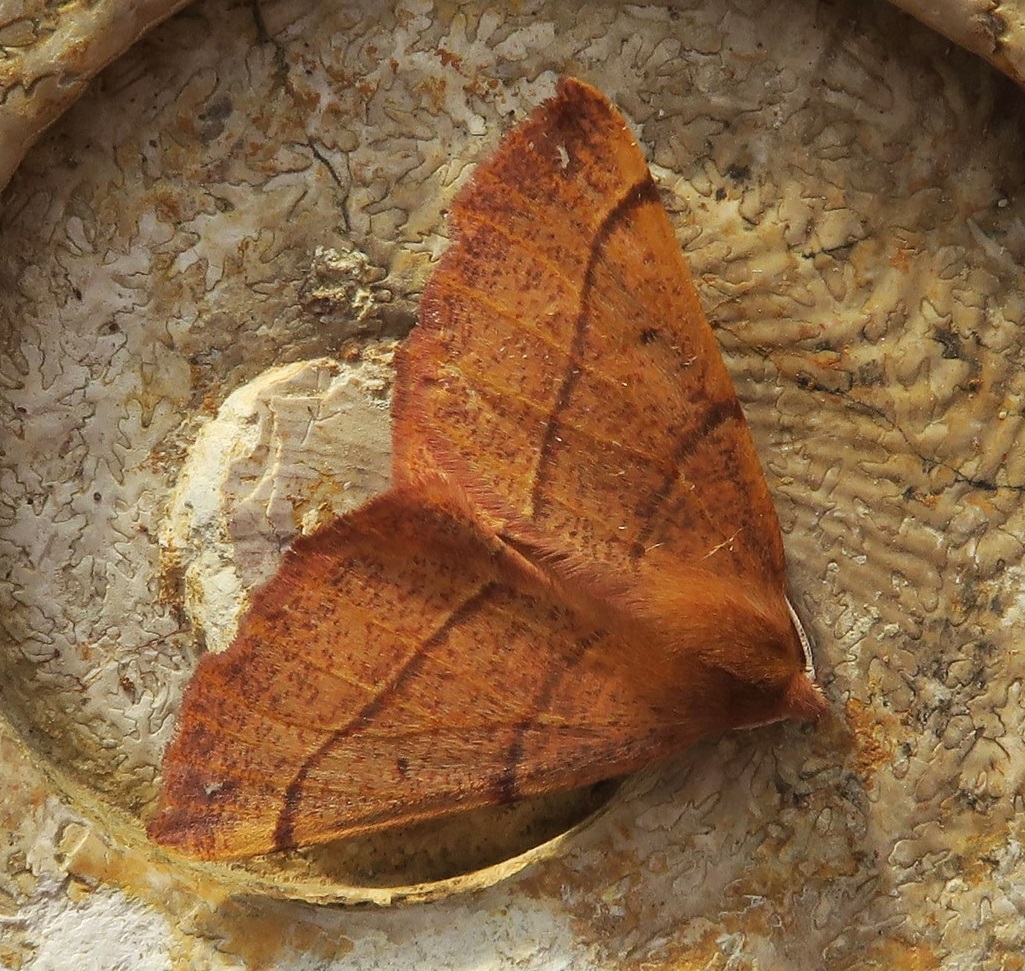
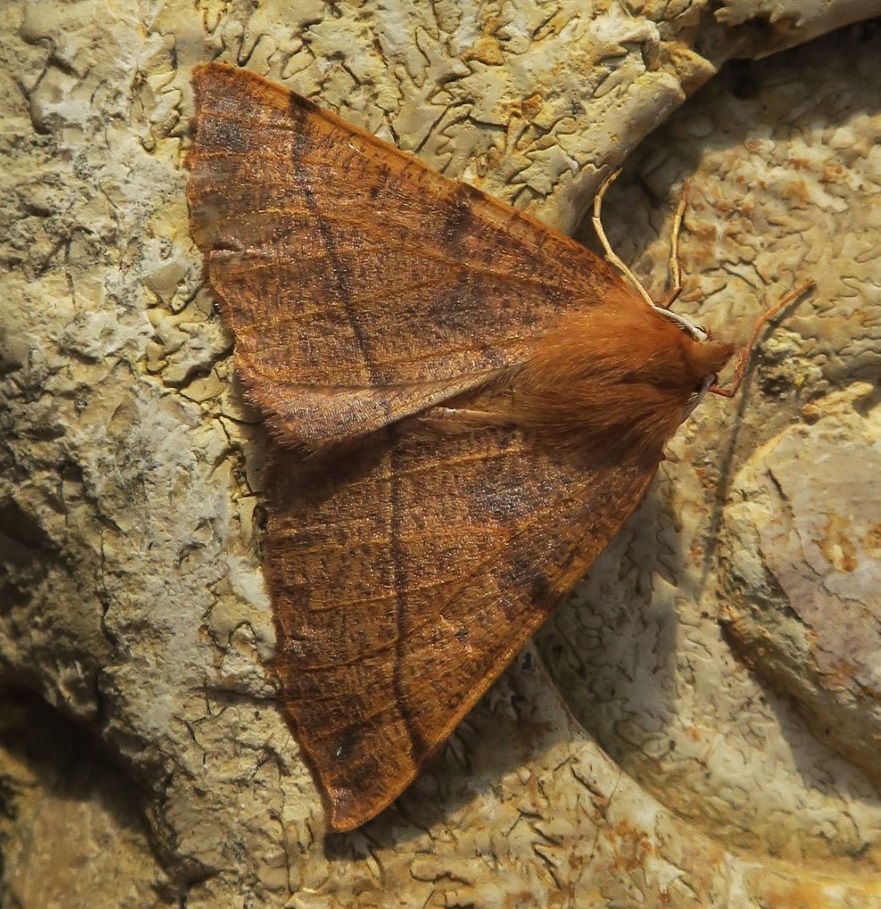 Feathered Thorn
Feathered Thorn
Feathered Thorn can join the other Thorns we have seen this year. Before the lockdown, we saw all the Thorns you could reasonably expect to see (August/September, Canary-shouldered, Dusky, Early) in the Community Woodland. Four individuals came to the trap, I have pictured two of them to show a degree of variation.
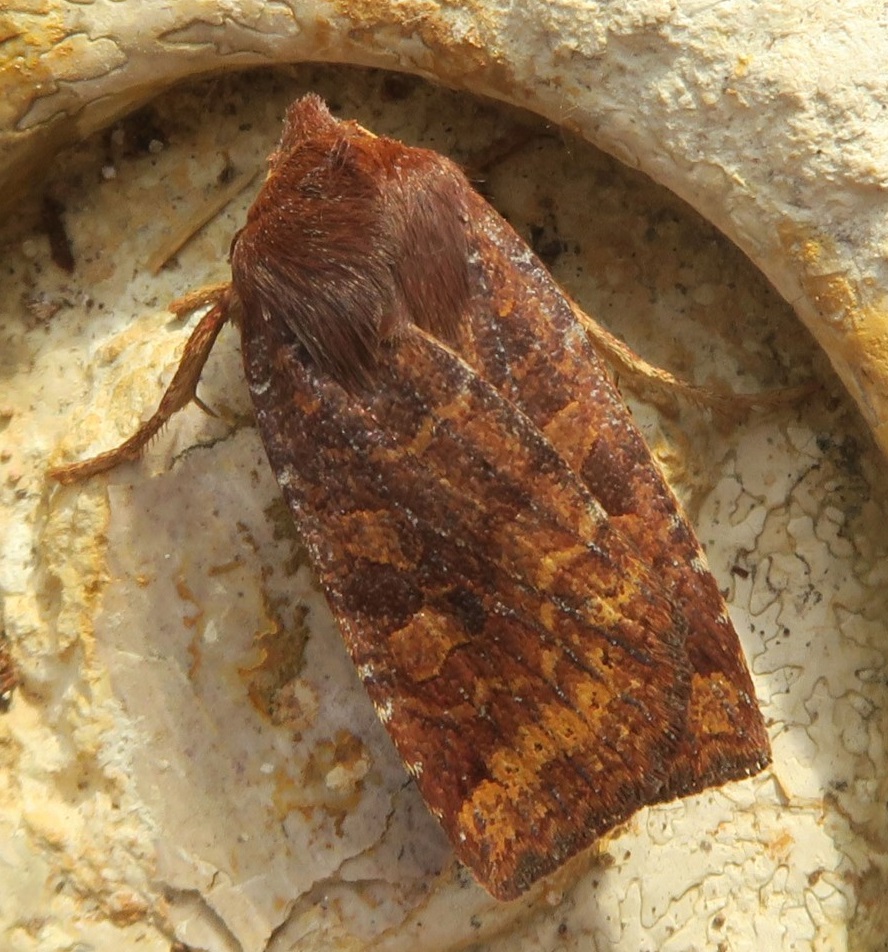
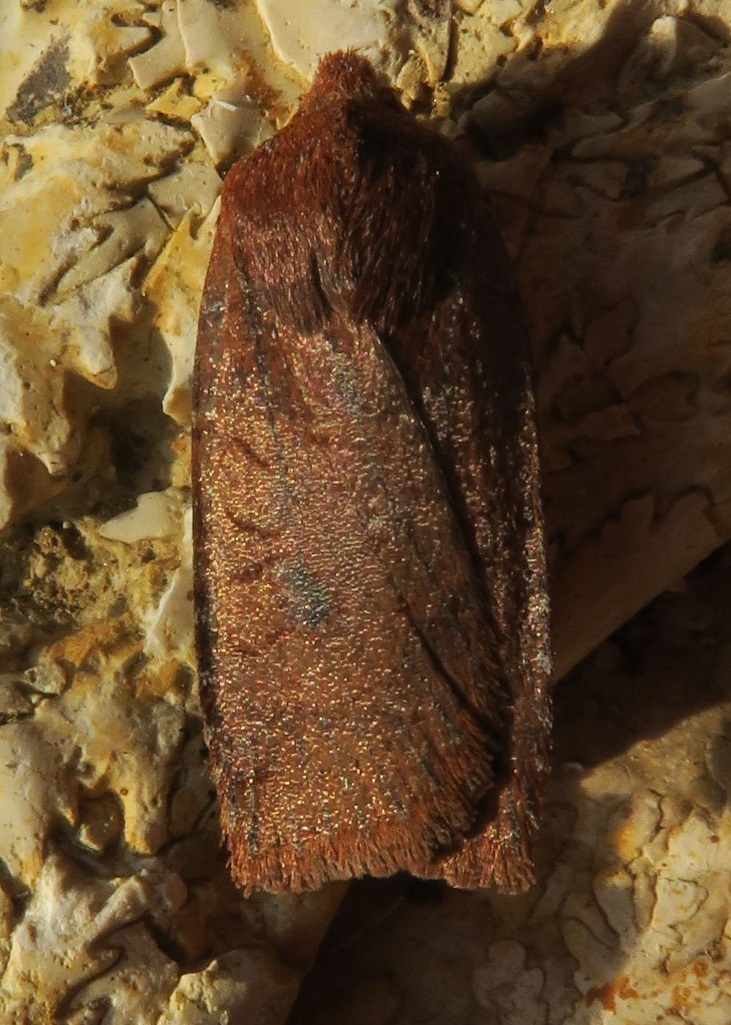 Dark Chestnut (probably)
Dark Chestnut (probably)
The Chestnuts are appropriately named characteristic autumn moths. These two individuals are, I think, Dark Chestnut, but the Chestnut is very similar and so the ‘probable’ appellation is a get-out. But they are one or the other (and have a rather fine head of hair!).
I was hoping to attract the ‘moth of the month’ – the November Moth – though without success. But, along with the Autumnal Moth, Winter Moth and a number of related moths – all very similar and all flying late in the year as their names suggest – there is still scope to see at least one or two of this group of moths.
The full list (11 moths of 7 species) is: Common Marbled Carpet, Dark Chestnut (prob. x2), Feathered Thorn (x4), Lesser Yellow Underwing, Mottled Umber (male), Red-line Quaker and Silver Y.
Moth Trapping, North Curry Garden, 18 October 2020
The mothing season is tailing off now, so I put the trap out on Sunday night more in hope than expectation, especially as it was quite chilly, although not windy. Nevertheless, I was pleased with the selection of autumn moths that resulted. Nothing rare, but some handsome moths.
Chief among them was a Merveille du Jour, a beautiful green moth – an unusual colour for a moth. Its striking colour and pattern is in fact an excellent camouflage against the powdery green algae or lichen on the bark of an oak tree, its larval food plant.
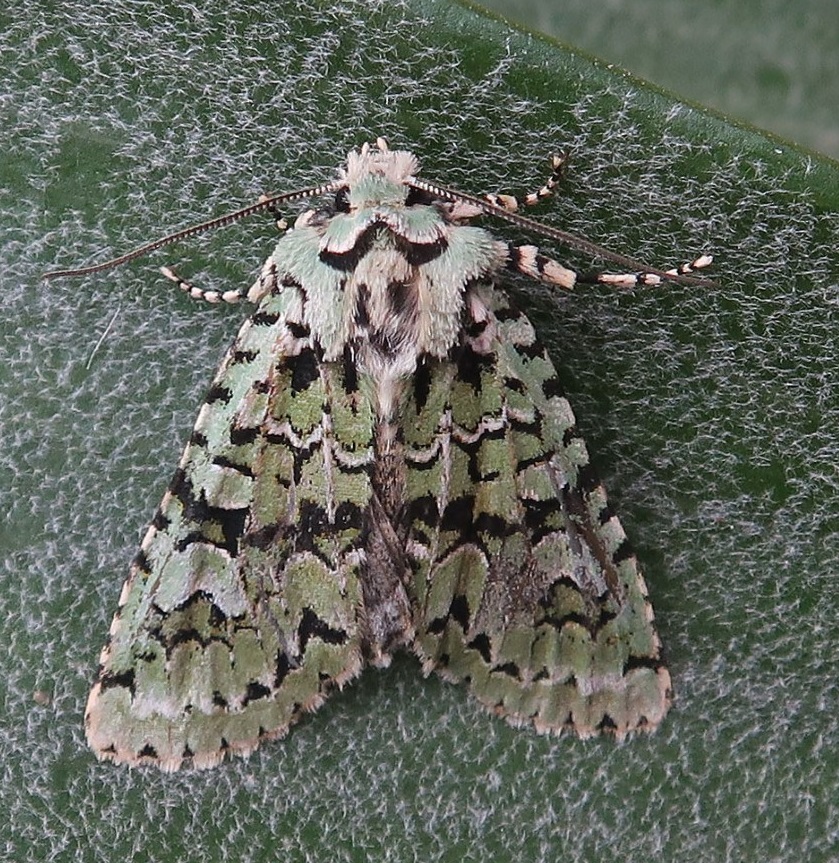 Merveille du Jour
Merveille du Jour
Another green(ish) moth is the Green-brindled Crescent. It is beautifully marked with a dusting of brilliant ‘metallic’ green scales. Seen ‘in the flesh’ in a good light, it is really quite spectacular. With larval food plants which include hawthorn and blackthorn, as well as many other woody hedgerow and garden trees and shrubs, it is not uncommon, although apparently much declined in recent decades.
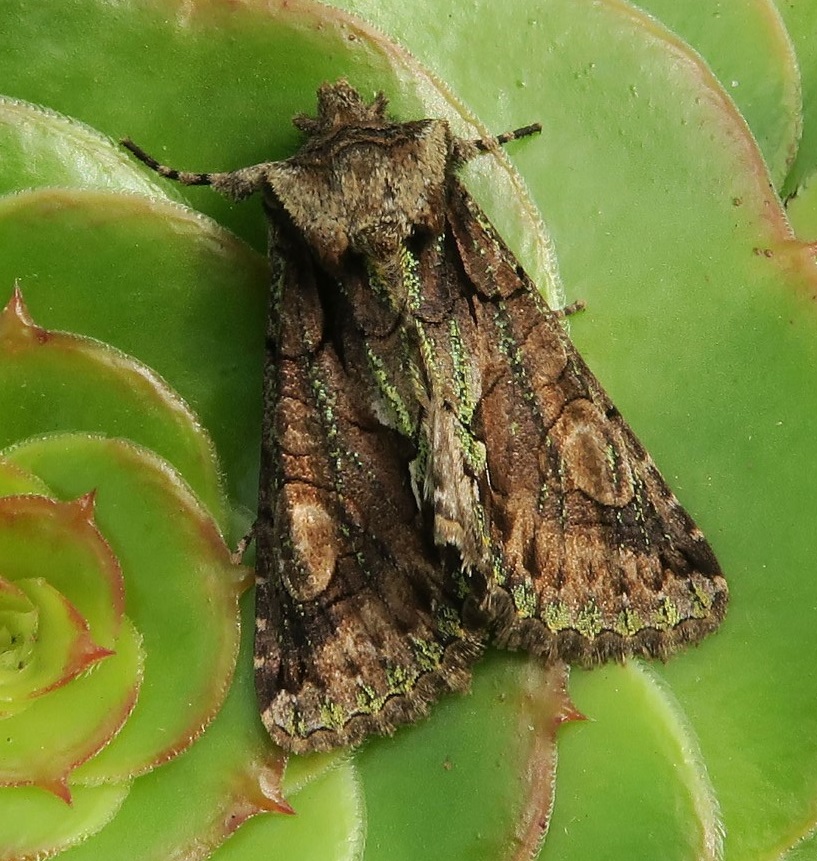 Green-brindled Crescent
Green-brindled Crescent
Quite a few moths active at this time of year naturally have the colours of autumn leaves and one such is the Beaded Chestnut. This is another common moth said to have severely declined in recent years, although there were three in the trap. The larvae feed on a variety of common grassland ‘weeds’, of which there are a lot in our neighbourhood, so not a surprise to see this characteristic autumn moth.
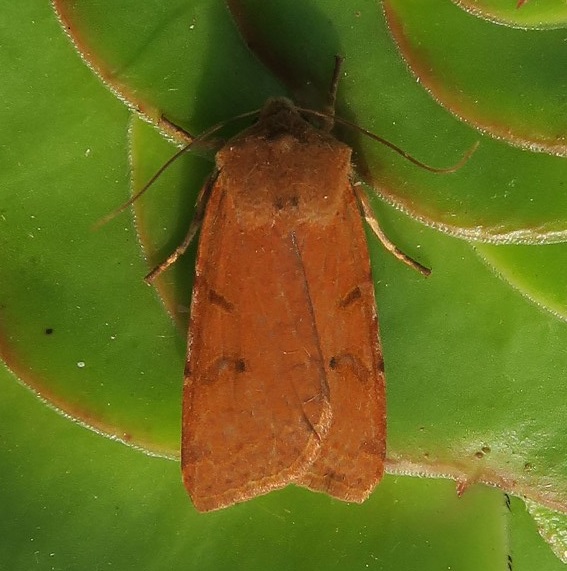 Beaded Chestnut
Beaded Chestnut
The Quakers (moths) are named with reference to the modest clothing historically worn by Quakers. Some might call them drab, but I think, like many apparently plain moths, they have a subtle beauty. There are two groups of moths with the vernacular name of Quakers, most of which are springtime flyers, but the Red-line Quaker (together with its close relative the Yellow-line Quaker) are active late into the year.
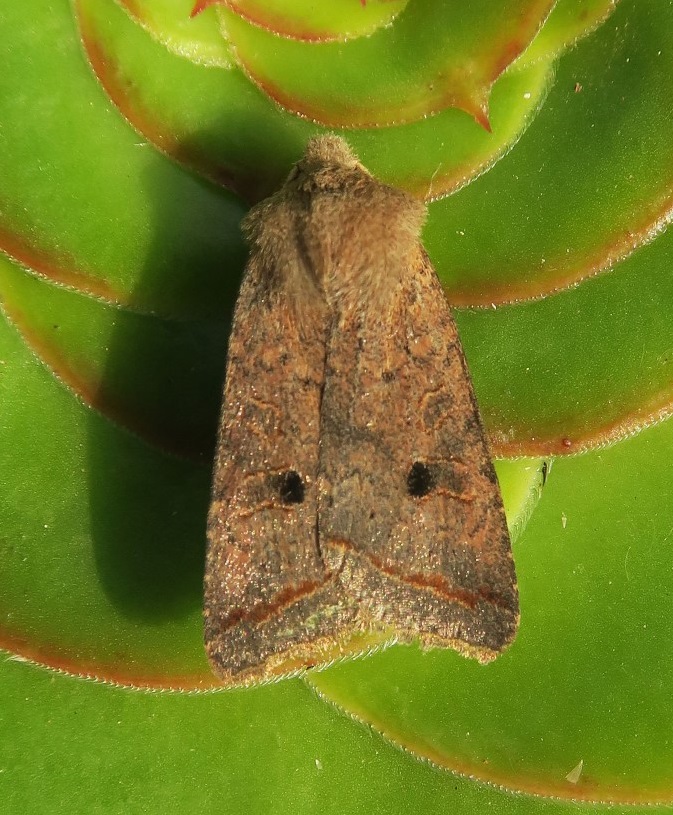
We can expect the life-cycles and flight periods of moths to be strongly affected by climate change and the more extreme weather patterns we are experiencing – always remembering that the emergence of the adult depends on the conditions the larvae have experienced over a whole year, or longer.
The full list (15 moths of 10 species) is: Beaded Chestnut (x3), Black Rustic (x2), Common Marbled Carpet, Green-brindled Crescent, Grey Shoulder-knot, Lesser Yellow Underwing (x2), Lunar Underwing, Merveille du Jour, Red-line Quaker (x2) and Shark (well outside flight season?).
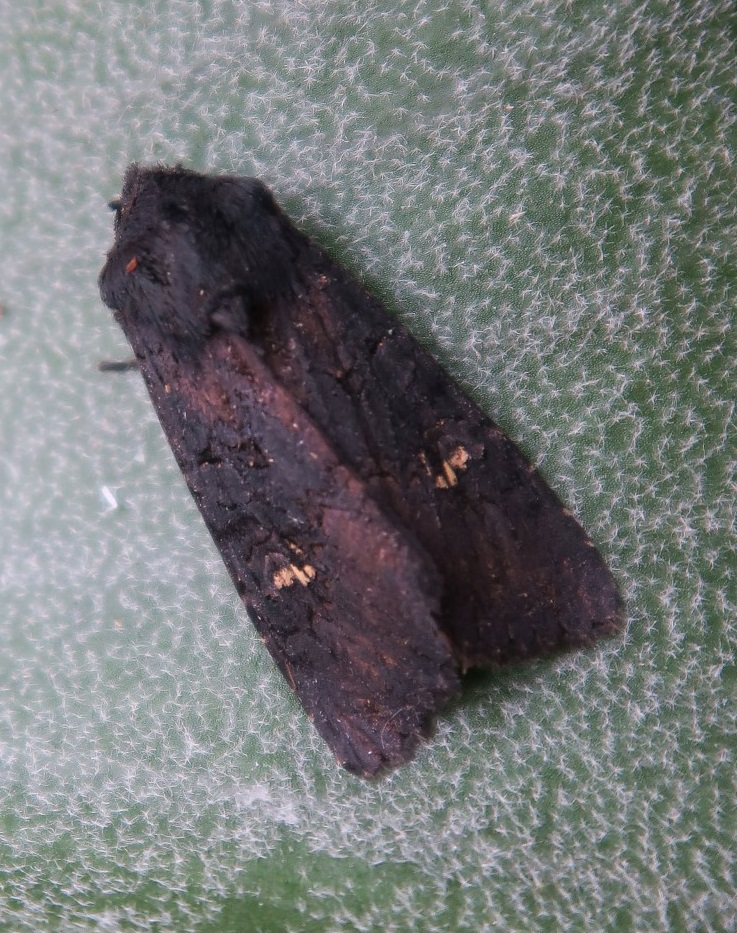
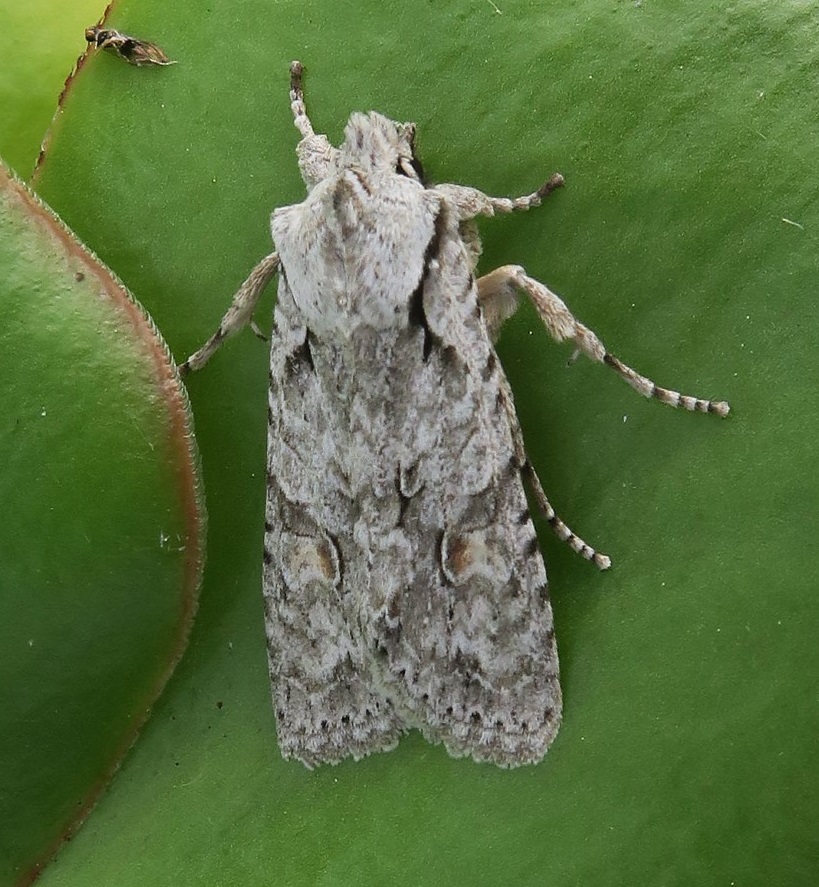 Black Rustic and Grey Shoulder-knot
Black Rustic and Grey Shoulder-knot
Moth Trapping, North Curry Garden, 14 September 2020
Despite a warm, still night, the results of 14 September were slightly disappointing. The most obvious feature was the proportion of Lunar Underwing – virtually a third of the total. As it happened, the first I started to identify was a rather worn specimen so it took some time to id itbefore I cottoned on, but from then on Lunar Underwing accounted for most of the lbjs in the trap. Although variable in colour, it is a perfectly distinctive moth once you get your eye in.
Another nice moth that came to the trap is the Chinese Character. I have previously referred to moths which display bright yellow or red and black markings, widely used throughout the insect world to signal toxicity, and those non-toxic moths which mimic those that are. Another form of mimicry is well shown by this tiny, and deliberately inconspicuous moth, which is not at all uncommon. The Chinese Character (Cilix glaucata) is only about a centimetre long when at rest, holding its wings up like a sort of hood, and looks exactly like a bird dropping – perhaps more so in reality than demonstrated in the photo below.
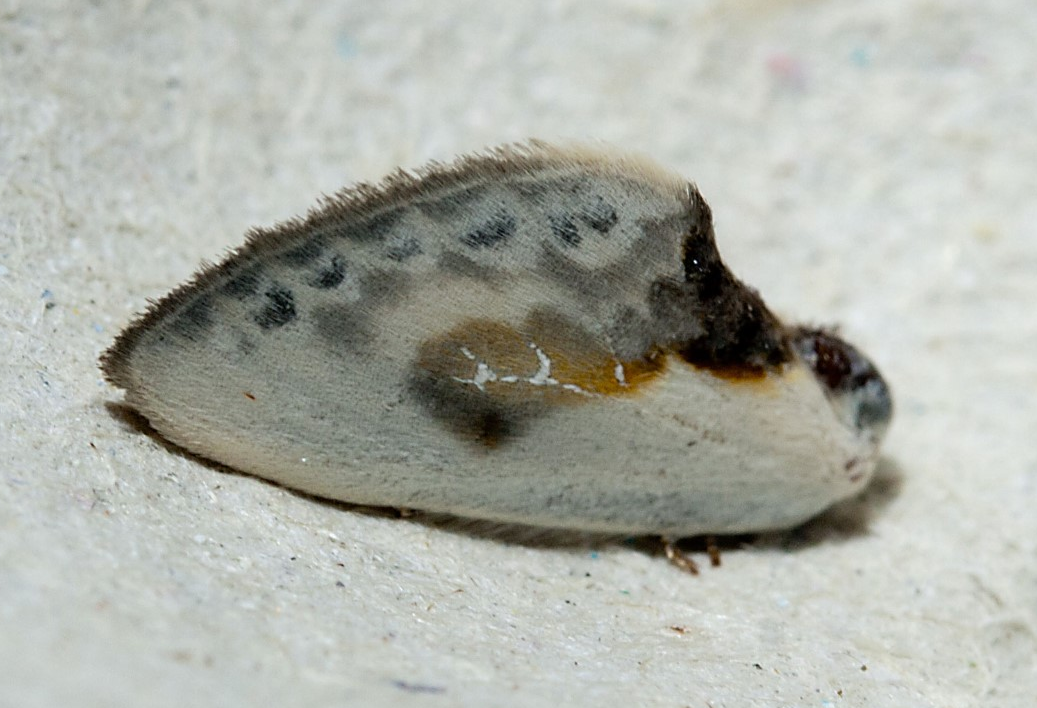 Chinese Character
Chinese Character
But looked at closely, it is really rather a beautiful moth, finely marked and textured – the Chinese bit of its name could just as easily stand for the finest Chinese porcelain – although it is the markings on the wing which are sometimes suggestive of a Chinese ideogram. It is regularly attracted to light and its larvae feed on a variety of common hedgerow trees.
The full list (29 moths of 13spp) for 14 September is: Brimstone, Chinese Character, Common Wainscot (x2), Dusky Thorn (x2), Green Carpet, Large Yellow Underwing (x3), Light Emerald, Lunar Underwing (x9), Oak Hook-tip, Ruby Tiger, Setaceous Hebrew Character (x2), Snout and Square-spot Rustic (x4) .
There are currently a lot of Silver Y around in the daytime, but there was an absence of immigrants in the trap.
Moth Trapping, North Curry Garden, 31 August 2020
Some visitors to the trap on 31 August included three seasonal moths in very fine condition. The first is August Thorn – or possibly, September Thorn. Unfortunately, the month in the name is no guide to the identification of these very similar moths, both of which fly in the late summer/early autumn, but I’m fairly certain the first moth is an August Thorn.
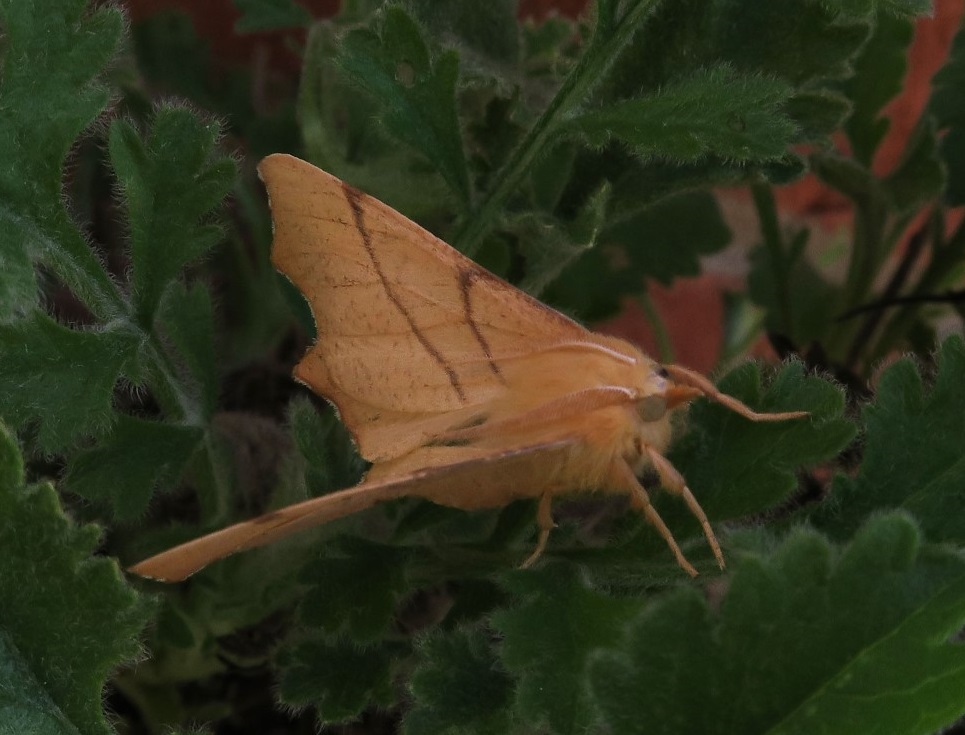 August Thorn
August Thorn
The next two pictures are Dusky Thorn; again, very similar but distinguished by a darker marking on the wing. All the Thorns are characterised by their rather unusual resting posture with the wings held up at an angle reminiscent of a butterfly. Both these individuals are males with splendid antennae.
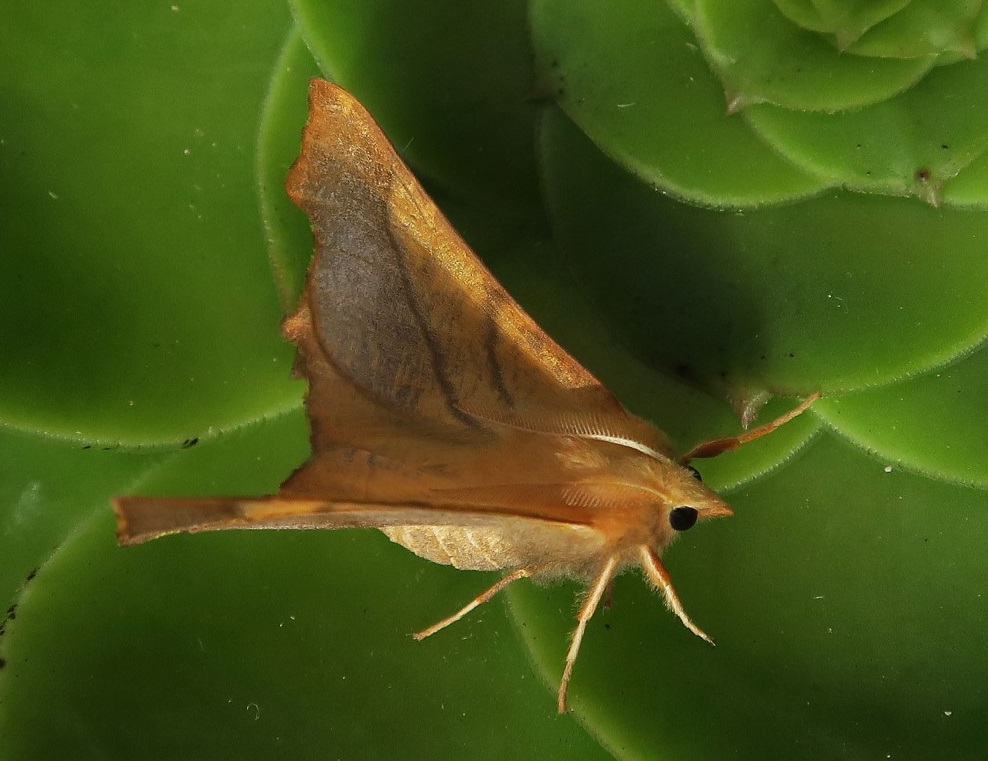
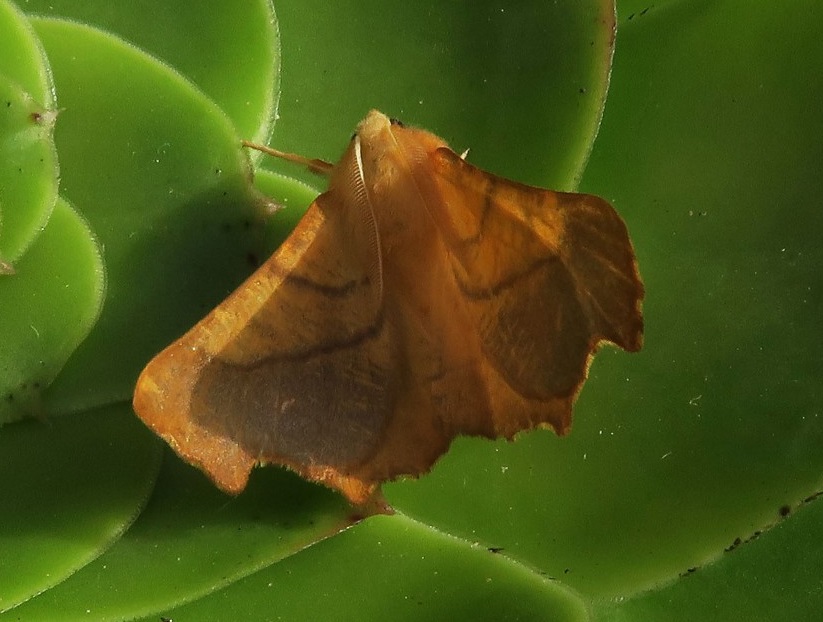
Dusky Thorn
The fourth is Light Emerald – strictly speaking not a true Emerald, although there cannot be strict rules for vernacular names. But all the other Emeralds are a different family (and a brighter green) and the Light Emerald is actually the same family as the Thorns. Anyway, whatever its name, a lovely moth and like the Thorns, in very good condition.
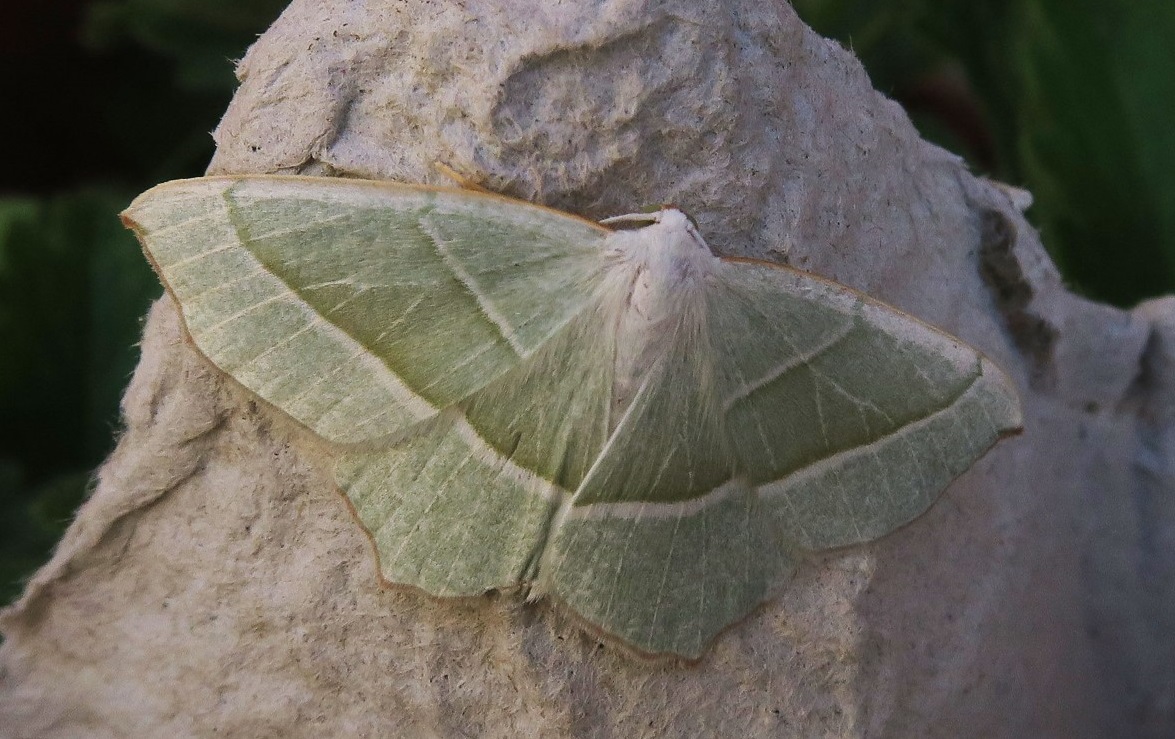 Light Emerald
Light Emerald
I don’t know if it’s my imagination, but a number of moths and butterflies seem large and fine this year. We’re used to speaking of good and bad butterfly and moth years based on the adults we see flying, but need to remember that what matters most is how the larvae fared, usually for the previous year or more, and that while we may grow nectaring flowers to be helpful for the adults (or at least those which actually feed) and more especially to increase our chances of seeing them, it is the supply of food plants for the larvae which is critical. And as many of these are commonly regarded as weeds, we have a typical human inconsistency of carefully growing certain flowers to attract the adult while ruthlessly eliminating the plants on which their feeding stages depend. We have been encouraged to allow some nettle patches but I wonder when our tolerance will extend to Docks, which are very important food plants for many moth caterpillars!
The full list (45 moths of 15 spp) for 31 August is: August Thorn, Brimstone, Common Wainscot (x14), Dusky Brocade? (x2), Dusky Thorn, Flounced Rustic (x2), Large Yellow Underwing (x6), Lesser Broad-bordered Yellow Underwing, Light Emerald (x2), Orange Swift, Rosy Rustic, Rustic, Setaceous Hebrew Character (x7), Siver Y (x3) and Small Square-spot (x2).
I have queried the Dusky Brocade as Brocades can be problematic to identify and Dark Brocade was another possibility. Nutmeg is a similar moth, but lacks the strong ‘W’ at the end of the wing.
Moth Trapping, North Curry Garden, 16 August 2020
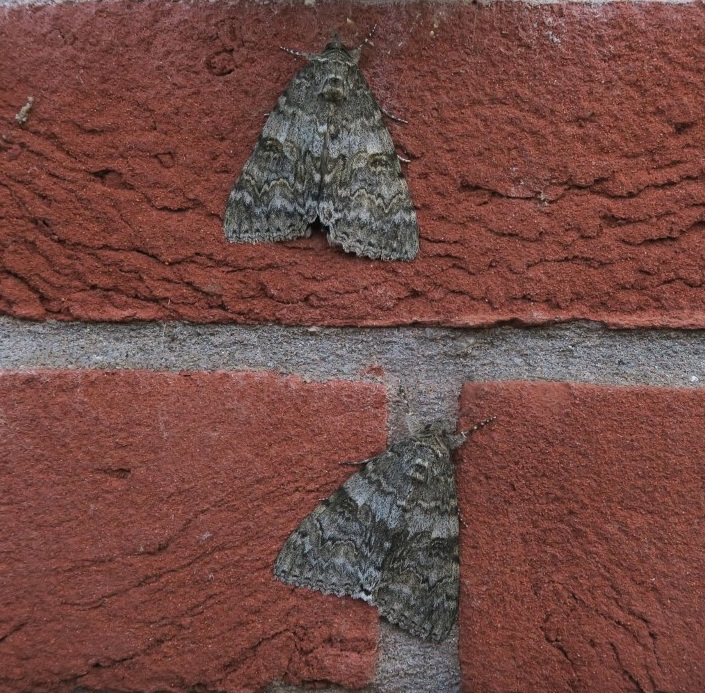
A fine pair of Red Underwing settled on our house wall last night, Sunday 16 August.
This large moth is not rare and can sometimes be seen by day, either nectaring or resting, and when it exposes its red and black hindwing, its identity is obvious. Its food plants include willows and poplars, so you would expect it about here.
This is one of numerous butterflies and moths which display a red or yellow and black warning signal to would-be predators. These colours are intended to signal that the insect is toxic and distasteful. The more insects which display them, the more the message is learnt and understood by predators, so they mimic each other and the signal becomes very widespread – known as Mullerian mimicry.
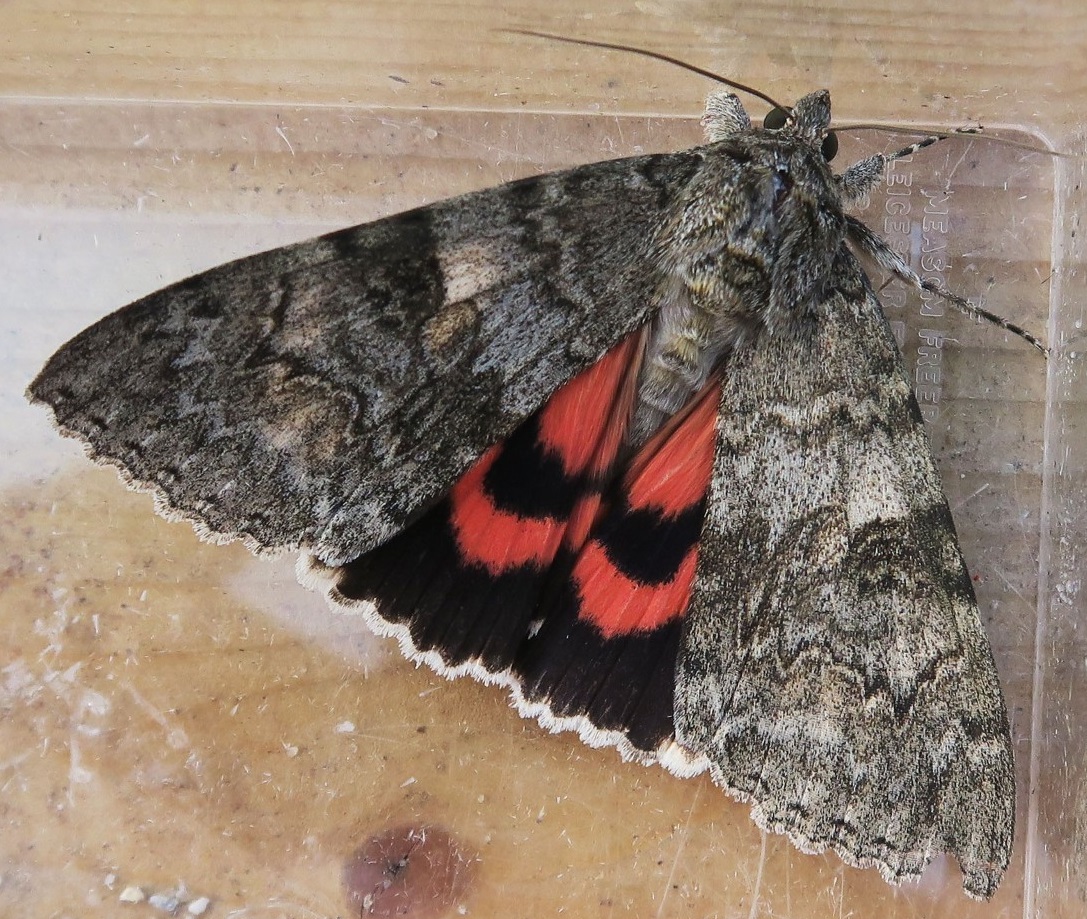
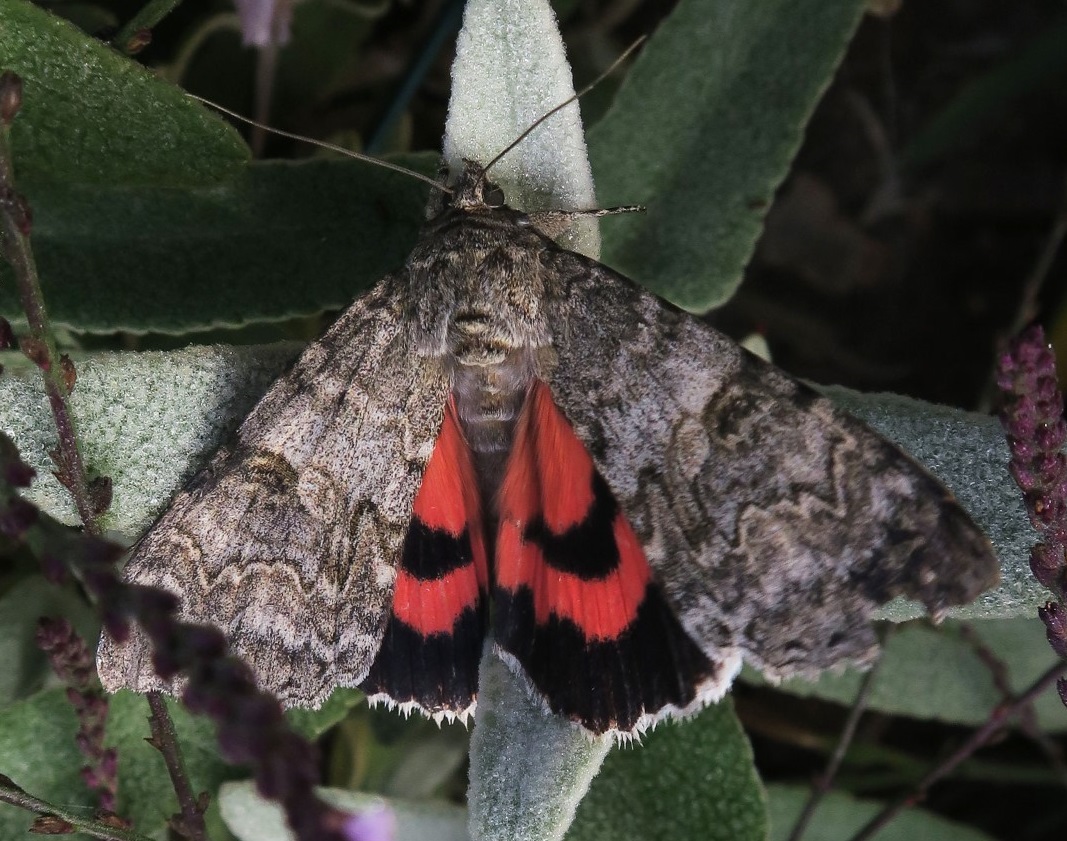
This system only works, of course, if the majority are actually distasteful: otherwise the system would lose its potency. In fact, some non-toxic, tasty insects do mimic toxic, nasty ones, without going to the trouble of making toxins – known as Batesian mimicry. So there is a limit to this ‘free-loading’ behaviour which would become self-defeating if too common.
This was first realised and described by the naturalist Henry Walter Bates, who explored and collected in the Amazon with his companion Alfred Russel Wallace. Both were outstanding naturalists and explorers and Wallace arrived at an understanding of evolution through natural selection while working in Borneo.
Wallace wrote to Charles Darwin – who he regarded as a senior naturalist likely (and broad-minded enough) to be understanding of his ideas – not knowing that Darwin had been maturing the same theory for many years but never published. This led to a joint presentation to the Linnaean Society of a summary Darwin had prepared for his closest friends some years previously and Wallace’s letter.
This was the first public announcement of evolution by natural selection but it went virtually unnoticed. It was not until Darwin published On the Origin of Species in 1859 that its importance began to dawn on people.
Silver Y is another day-flying moth in evidence at the moment. If you see a medium-sized grey job behaving like a butterfly on your flowers, it is likely to be a Silver Y. The silver mark which gives it its name is clearly visible on the forewings, but can only be seen when the moth is still– which it rarely is – when nectaring it beats it wings very fast. Silver Y is an immigrant which (at the moment at least) cannot sustain its life-cycle over our winter.
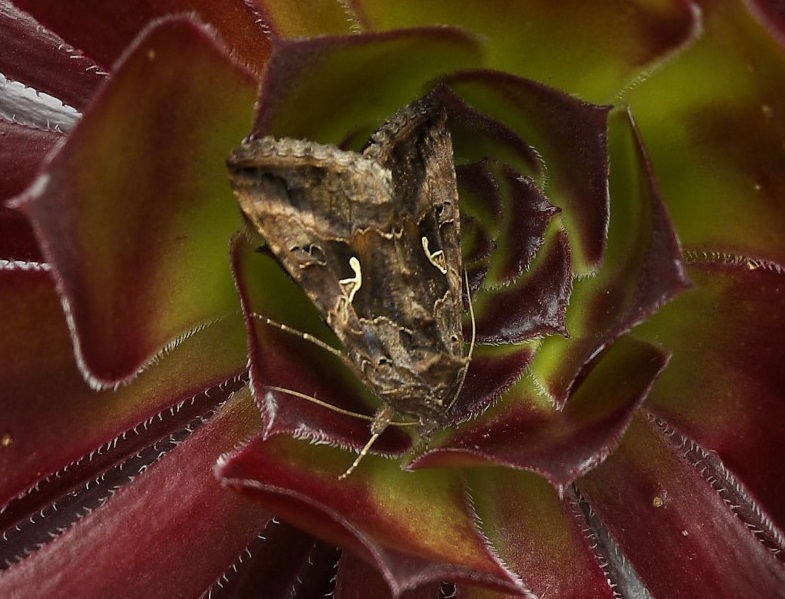 Silver Y showing the marks that give it its name
Silver Y showing the marks that give it its name
Moth Trapping, North Curry Garden, 2 August 2020
The highlight of the night was undoubtedly the number of Jersey Tiger. I had similar numbers in August last year. The most recent edition of Townsend and Waring’s Concise Guide to the Moths of Great Britain and Ireland still describes Jersey Tiger as ‘local’ (and also an immigrant) but clearly there is a well-established population here. The Somerset Moth Recorder said he had similar records last year. Altogether, North Curry seems good for Tiger moths, although I am still waiting for Garden Tiger.
At least one of the Jersey Tigers was the rarer form with the yellow underwing.
Although there is nothing rare or even unusual about them, three species were new to me: Latticed Heath; Shaded Broad-bar and Straw Underwing. This will simply be down to location and habitat, or simply the vagaries of mothing.
The forewings of Straw Underwing are Brocade-like and, as it was new to me, I was puzzling over it until I thought to look at the hind wing. It is useful to bear this in mind if you have what you think might be a Brocade of sorts.
The full list (85 moths of 32 spp.) was: Blood-vein, Brimstone (>5), Cloaked Minor (x2), Common Carpet (x2), Common Footman (x3), Common Rustic (x5), Common Wainscot (x5), Drinker (M), Dusky Thorn (x3), Elephant Hawkmoth, Flame Shoulder (x2), Garden Carpet, Iron Prominent, Jersey Tiger (>13), Latticed Heath, Lesser Broad-bordered Yellow Underwing (>11), Lime-speck Pug, Lychnis, Magpie (x2), Marbled Green, Oak/Northern Eggar (F) (x2), Pale Prominent, Pebble Prominent, Ruby Tiger (x2), Rustic (x3 incl. poss. Vine’s Rustic), Shaded Broad-bar, Shuttle-shaped Dart (x5), Spectacle, Straw Underwing (x2), Willow Beauty (x4) and Yellow-tail (x2).
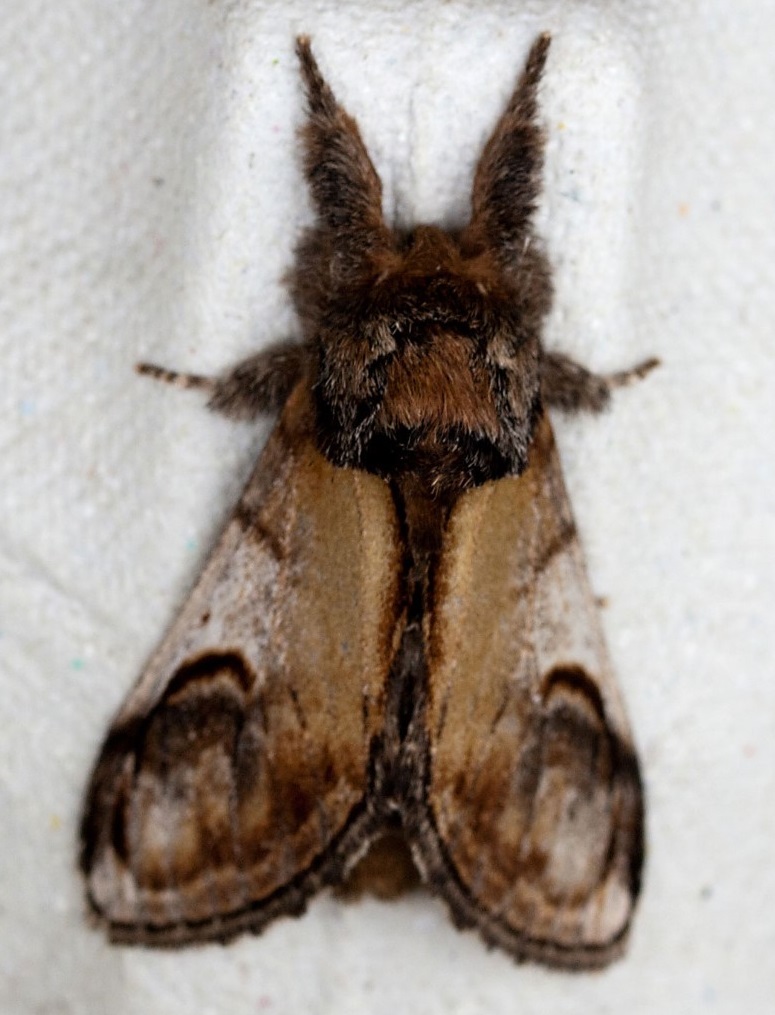
Pebble Prominent
Moth Trapping, North Curry Garden, 25 July 2020
Despite a spell of poor weather, I put the trap out on Saturday night, 25 July, just to see if the rain showers had tempted any moths out, though it was not a full night’s trapping as I closed the trap down at 2 am. Nevertheless, I caught some interesting and varied moths, including Common Footman (quite a number, not counted), Common Rustic (x2), Dark-barred Twin-spot Carpet, Dingy Footman, Drinker (M), Jersey Tiger, Knot Grass, Lesser Broad-bordered Yellow Underwing, Nutmeg (x3), Pale Prominent, Pebble Prominent, Riband Wave, Ruby Tiger (x4, one nearly black) and Willow Beauty (14 species).
The Dingy Footman is quite a distinctive moth, much broader and more curved than the Common Footman. The Lesser Broad-bodied Yellow Underwing was very fresh and showed well the pale green collar which helps identification. The Nutmegs were pristine specimens. The Ruby Tigers are obviously out in force now, and one I had was virtually a velvety black, but bright red underneath of course.
The male Drinker Moth has enormous and splendid antennae. Many male moths have big feathery antennae to discern the female pheromone, of course, but this male Drinker has super-sized antennae. The photo below was snapped in a hurry before it flew off. A moth which has been cold overnight will vibrate for a minute or two to warm itself up and get its muscles working before flying off. This moth is doing just that, which is why the wings are blurred.
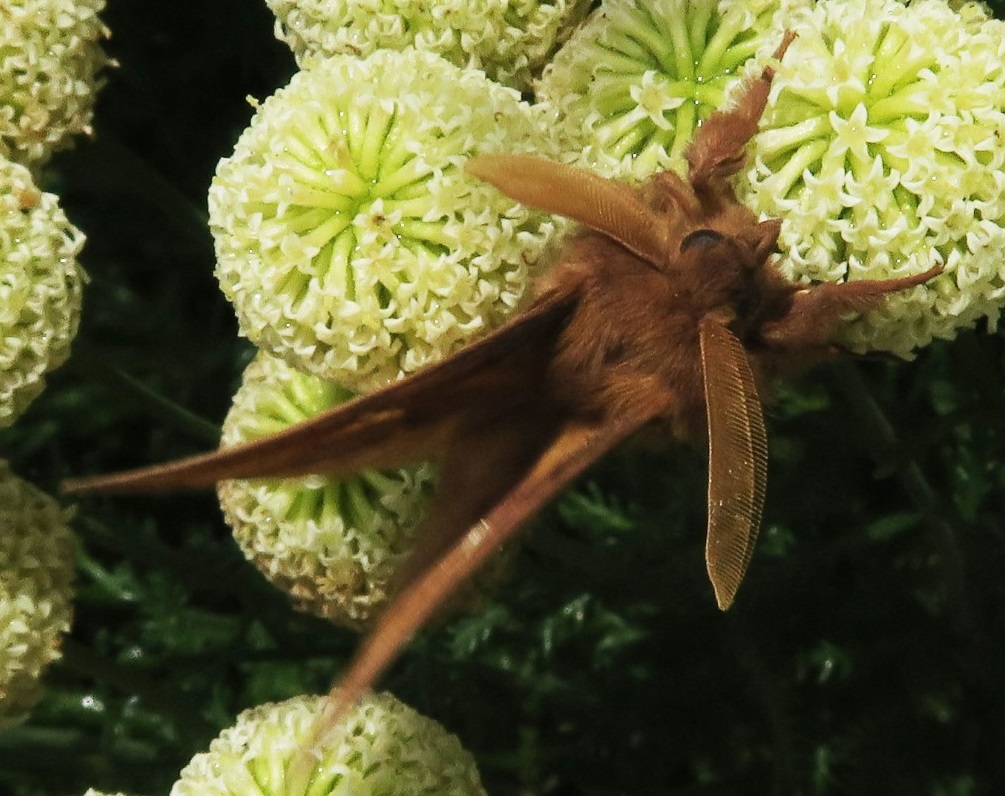 Male Drinker moth, showing fine antennae
Male Drinker moth, showing fine antennae
The Pale Prominent is shown below. Cryptic scarcely describes this moth which when at rest looks exactly like a scrap of thin bark or other debris. If it feels threatened, it will flatten itself and become remarkably thin, keel over on its side and feign death. Like this, it certainly doesn’t look like anything worth eating, and I almost missed it when I was checking the trap, mistaking it at first for a scrap of rubbish.
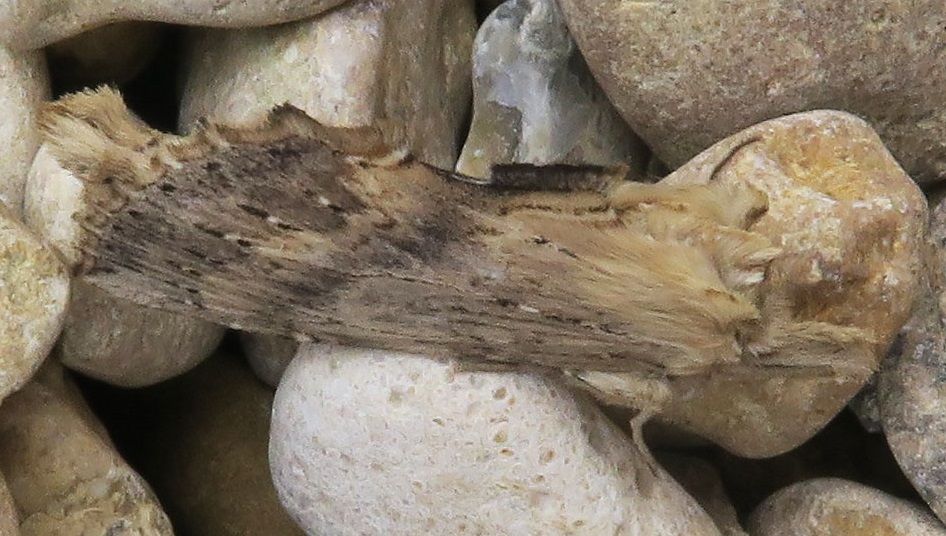 Pale Prominent against gravel (its head to the right)
Pale Prominent against gravel (its head to the right)
Moth Trapping, North Curry Garden, 11 July 2020
A respectable tally for July on the first relatively wind-free night we have had for some time. Allowing for the numerous Common Footmen, Rustics and Heart & Dart, there were about 50 moths of 20 species, including Barred Straw, Buff Arches, Buff Ermine (M & F), Common Footman (very many), Common Rustic, Dark Arches (x3), Elephant Hawkmoth, Heart & Dart, Large Yellow Underwing, Mottled Rustic (prob.), Nut-tree Tussock, Pale Mottled Willow?, Riband Wave, Ruby Tiger, Rustic/Uncertain, Scalloped Oak (x2), September Thorn (prob), Yellow-tail, Shark, Willow Beauty (prob., very worn).
Some pictures from the night include a Yellow-tail, which is obvious in this picture but not when the tail is hidden, as it normally is when the moth is not irritated.
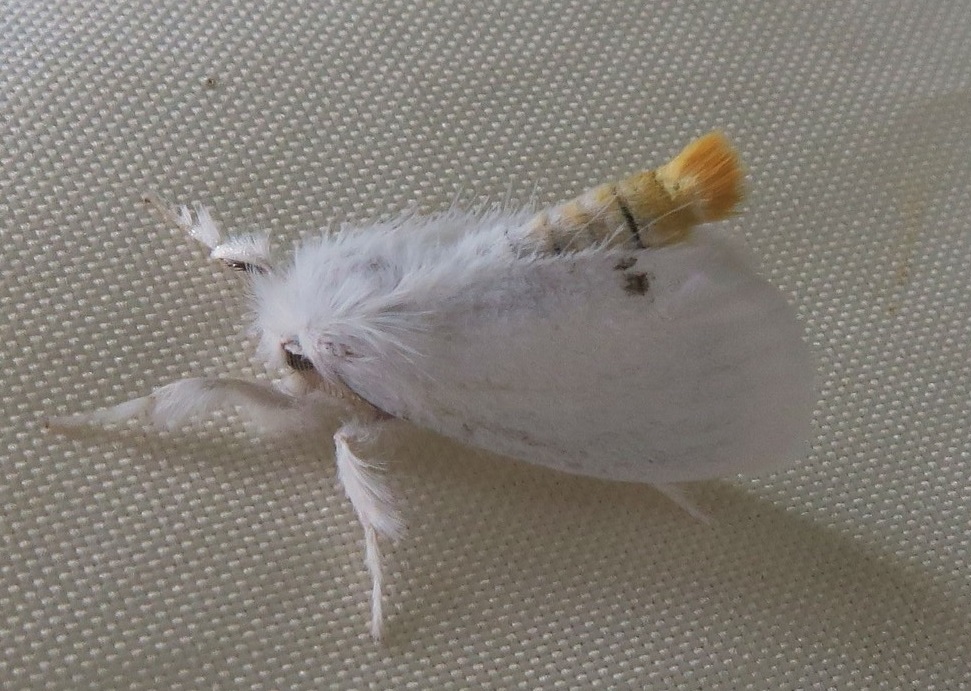 Yellow-tail showing tail
Yellow-tail showing tail
The yellow hairs are themselves an irritant and the female (the photo is a male) mixes them with her eggs when she lays them. There is a close relative – the Brown-tail – which is virtually identical but with, obviously, brown hairs. These are very irritating and can be carried in the air, which is not usually a problem except in exceptional years when the Brown-tail has a population surge. The caterpillars live communally in large webs which can completely envelop their food plant, normally a hedgerow tree or shrub. When this happens, they are very noticeable and can make people, and particularly local authorities, extremely anxious as they try to ‘close’ hedges, egged on by the tabloids. But it is worth remembering that a number of caterpillars have irritant hairs as a defence against predators which they incorporate into both their eggs and pupae.
The next picture is a Buff Ermine, a member of the same family of largely furry and stocky moths, including Tiger Moths. This is the male, which is buff; the female has a pure white background with similar markings.
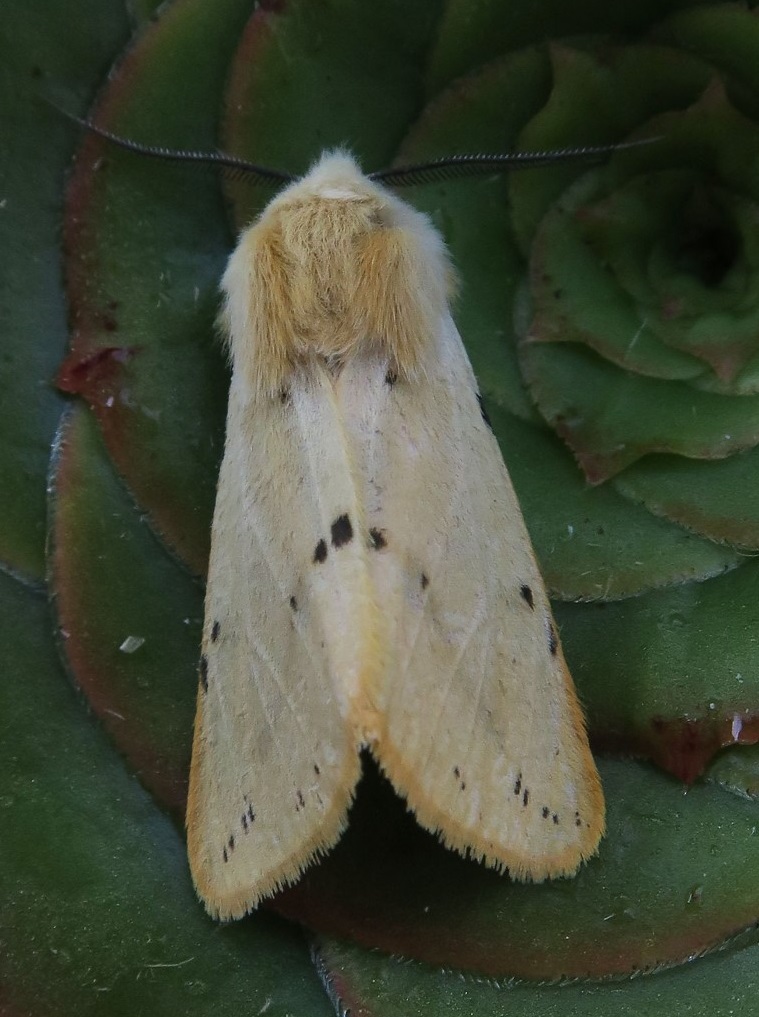 Buff Ermine male
Buff Ermine male
Another fine moth is the Scalloped Oak.
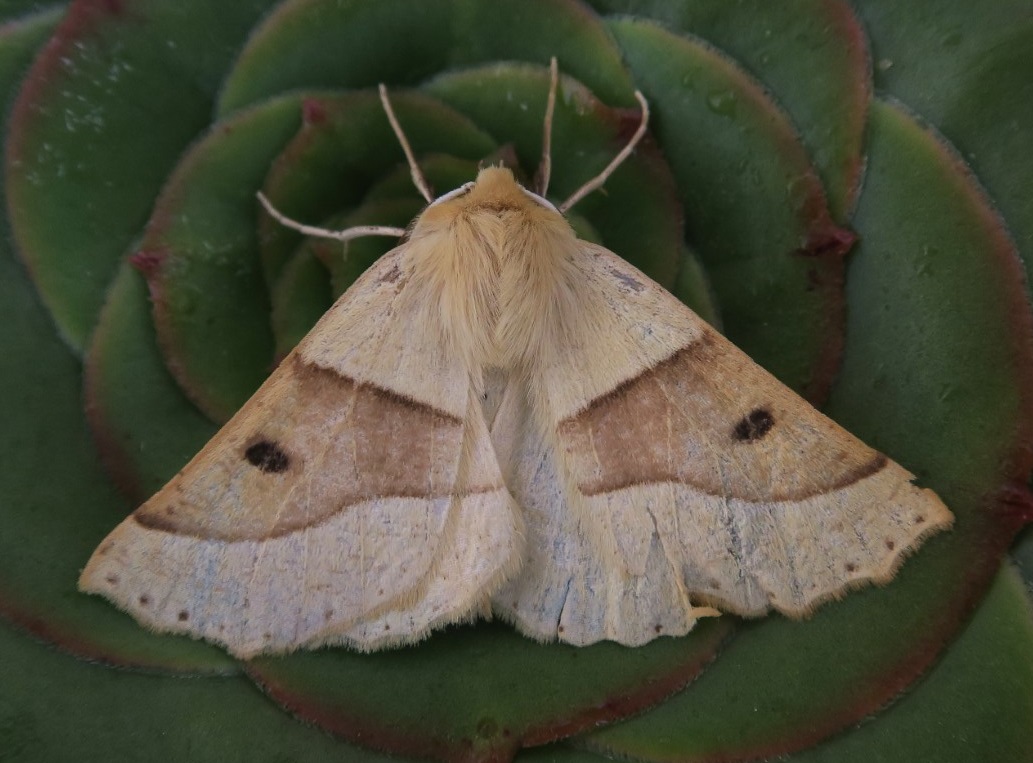 Scalloped Oak
Scalloped Oak
The next two moths are so common they are often neglected. The Riband Wave is known to every moth trapper. It is a very variable summer (and sometimes autumn) moth, but the basic pattern of lines is always consistently present and helps distinguish it from the many other Waves, which can be a rather difficult group to identify.
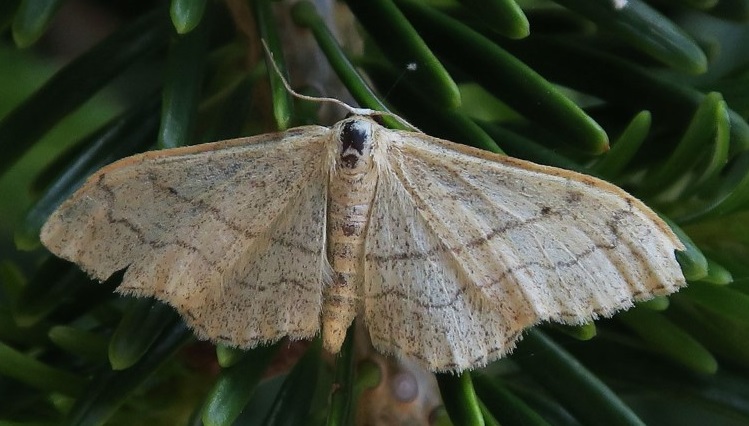 Riband Wave
Riband Wave
The Common Footman is particularly abundant at the moment: it made up about half of the total moths which were trapped last night, and there will have been many more that were attracted to the light but not trapped. As with the Waves, there are a number of Footman species which look superficially similar, but all rather smart, if sombre, as befits a good footman.
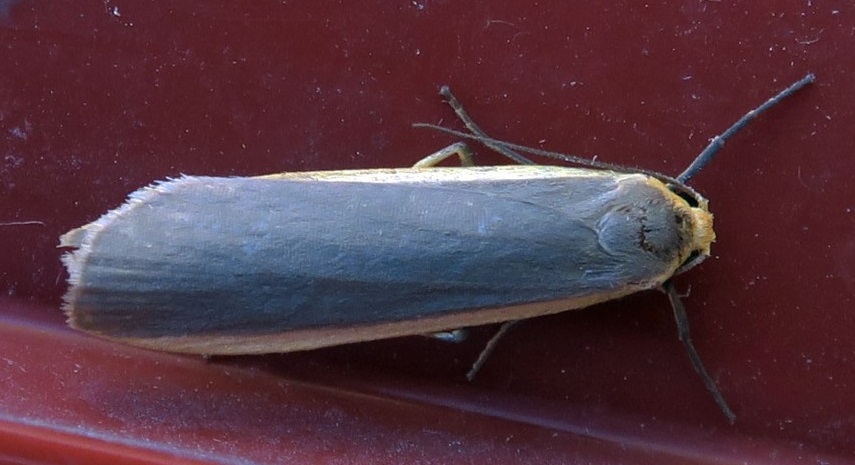 Common Footman
Common Footman
Moth Trapping, North Curry Garden, 23 June 2020
I put the trap out in my garden on Tuesday night 23 June and trapped 33 moths of 21 spp. The full list was: Barred Straw, Brimstone, Broad-barred White, Brussels Lace (m, very dark), Buff Ermine (x4), Buff Footman? (very clear and strong orange margin), Common Footman, Common Rustic, Dark Arches (x6), Elephant Hawkmoth (x2), Heart & Dart (x5), Large Yellow Underwing (x2 trapped, but more blundering about), Leopard Moth, Minor, Mottled Rustic?, Orange Moth (x2 m), Poplar Hawkmoth, Puss Moth, Small Elephant Hawkmoth, Snout and Willow Beauty.
The Poplar Hawkmoth is a fine moth. For some reason, I never find a tatty, worn one: they always seem to be fresh.
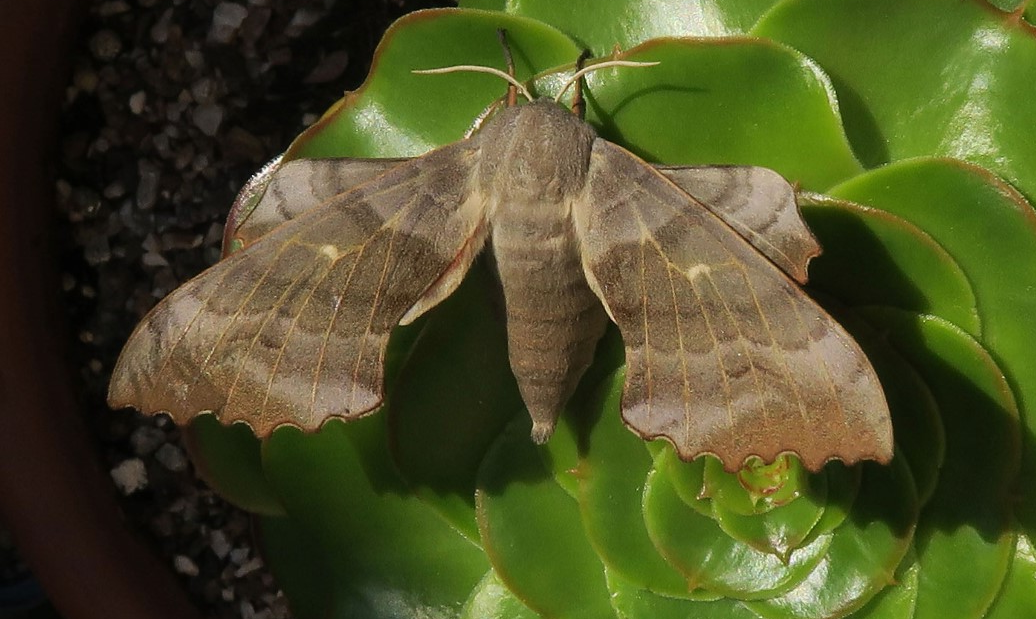 Poplar Hawkmoth
Poplar Hawkmoth
The Leopard Moth is a common moth but the first time I have seen it. It is one of a family of moths of which the adults cannot feed and the larvae are tunnellers. So, three years as a caterpillar inside a willow tree, and a week or so flying around hungry looking for a mate!
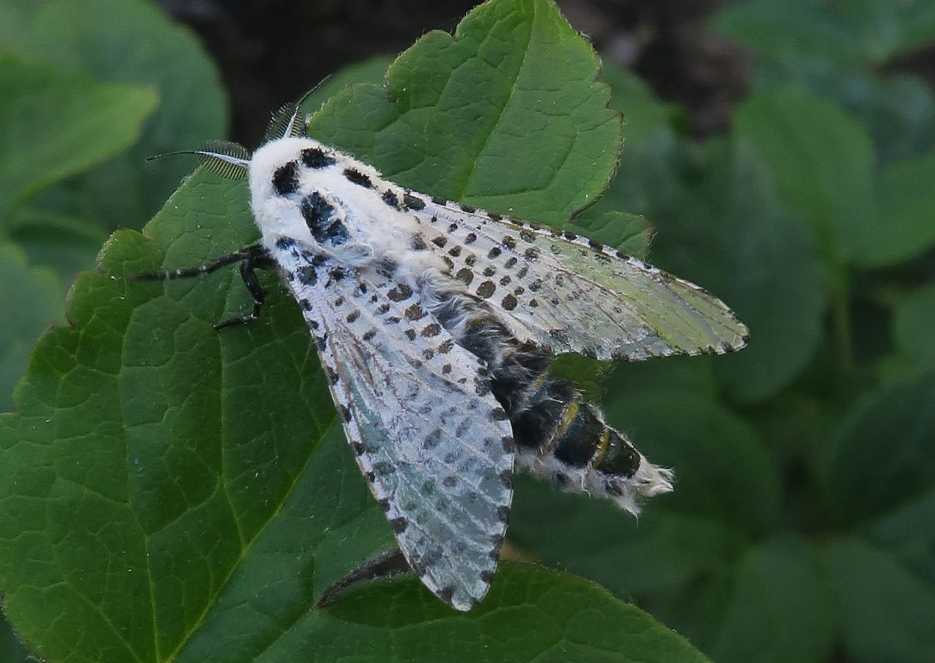 Leopard Moth
Leopard Moth
Orange Moth (so named for obvious reasons), again not rare, but local and another first for me. With two in one night, there must be a breeding population nearby. In contrast to the Poplar Hawkmoth, this is an extremely flighty moth, and the photo is of the slightly less tatty of the two.
 Orange Moth
Orange Moth
Moth Trapping, North Curry Garden, 27 May 2020
With the year moving on and an exceptional spell of warm and, above all, calmer weather, the moth count is increasing. On the night of Wednesday 27 May Stephen had 20 spp., 35 moths in all (as always, not including micro-moths or pugs, unless the latter are very easy!). This is not a high count but a good average for this time of year.
Moth numbers at traps can be very unpredictable and inconsistent. The full list was: Barred Straw (x2), Brimstone, Buff-tip, Common Carpet (x2), Common Marbled Carpet, Common Swift, Common Wainscot (x2), Cream-spot Tiger, Elephant Hawkmoth, Garden Carpet, Green Carpet (f), Heart and Dart (x6), Light Emerald, Lychnis, Marbled Minor, Pale Tussock (x2m), Puss Moth, Treble Lines (x5), White Ermine (x2m), Willow Beauty (x2) (plus Small Magpie, a micro-moth).
One interesting moth was the Light Emerald - strictly speaking not a ‘true’ Emerald in the sense that it is a different family from all the other Emeralds, which are stronger green. But green is an unusual colour for moths and the Light Emerald is nice to see, although common, with a larva which feeds on a wide variety of broad-leaved trees and shrubs.
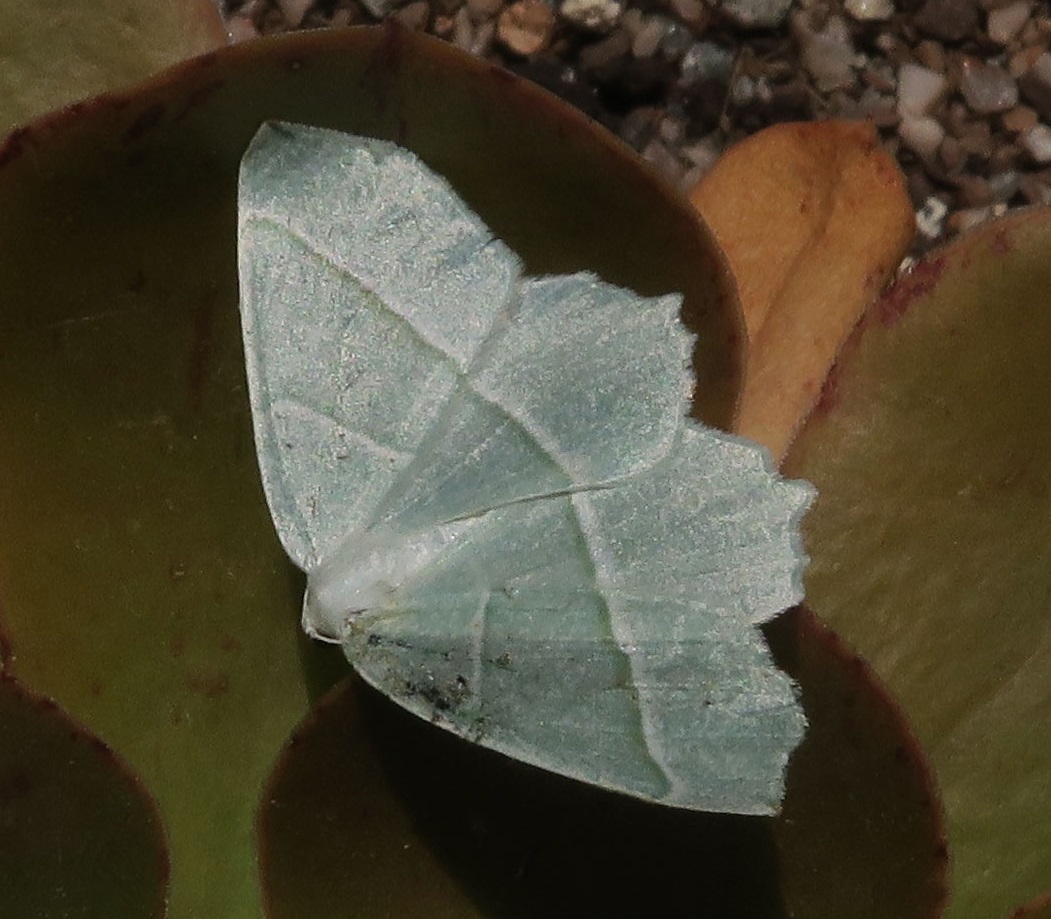 Light Emerald
Light Emerald
And, by way of contrast, a Lychnis, which initially looks a bit of a plain brown moth but has quite a distinctive ‘x’ pattern on its resting wings.
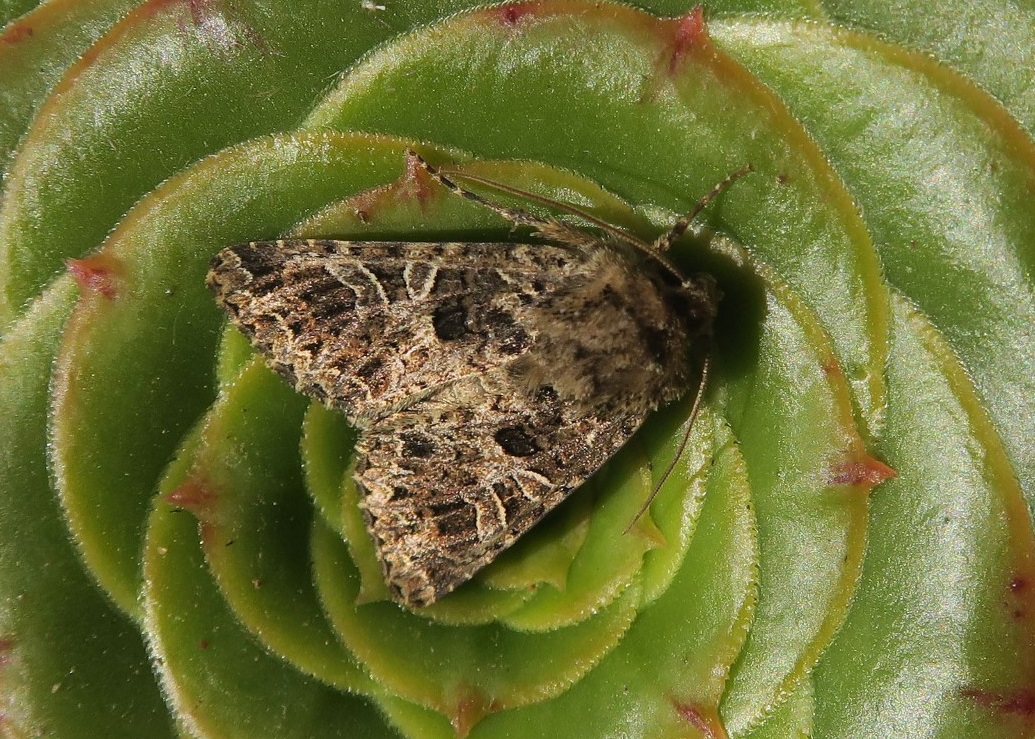 Lychnis
Lychnis
Another Puss Moth turned up and laid eggs - which look to be fertile so Stephen will try to rear them for the unusual and spectacular caterpillar.
Moth Trapping, North Curry Garden, 20 May 2020
Stephen put the trap out in his garden on Wednesday 20 May with good results. Honours were shared between three Cream-spot Tigers, a Puss Moth and a Buff-tip. The three Cream-spot Tigers were caught in quick succession when they settled on the backing sheet while Stephen was checking the trap at 10.30pm. This might indicate that there is a good population locally.
Quite a few moths are attracted by the light of a moth trap, but do not necessarily enter the trap. On a pleasant summer night, it is worth staying up and picking moths off the sheet as they arrive. Indeed, on a good night it might be worth simply shining a bright light on a white sheet and seeing what turns up.
Another nice moth was Puss Moth. It has the most spectacular larva, which a recent article in British Wildlife suggests is a snake mimic - a geologically ancient fear of snakes being genetically in-built in almost all animals. The food plant is willow so it may be common locally.
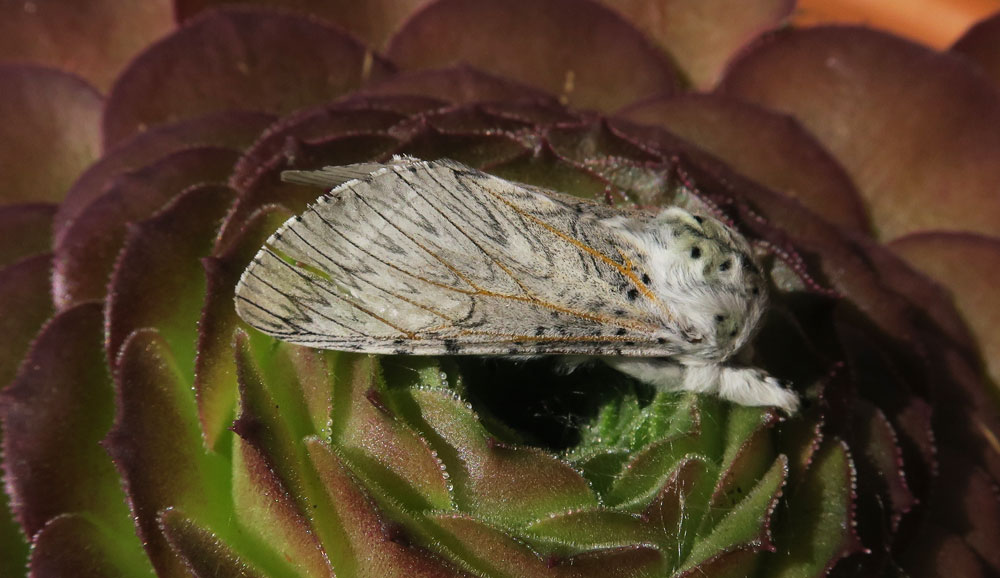 Puss Moth
Puss Moth
The third moth, the Buff-tip, is an astonishing mimic of a broken twig.
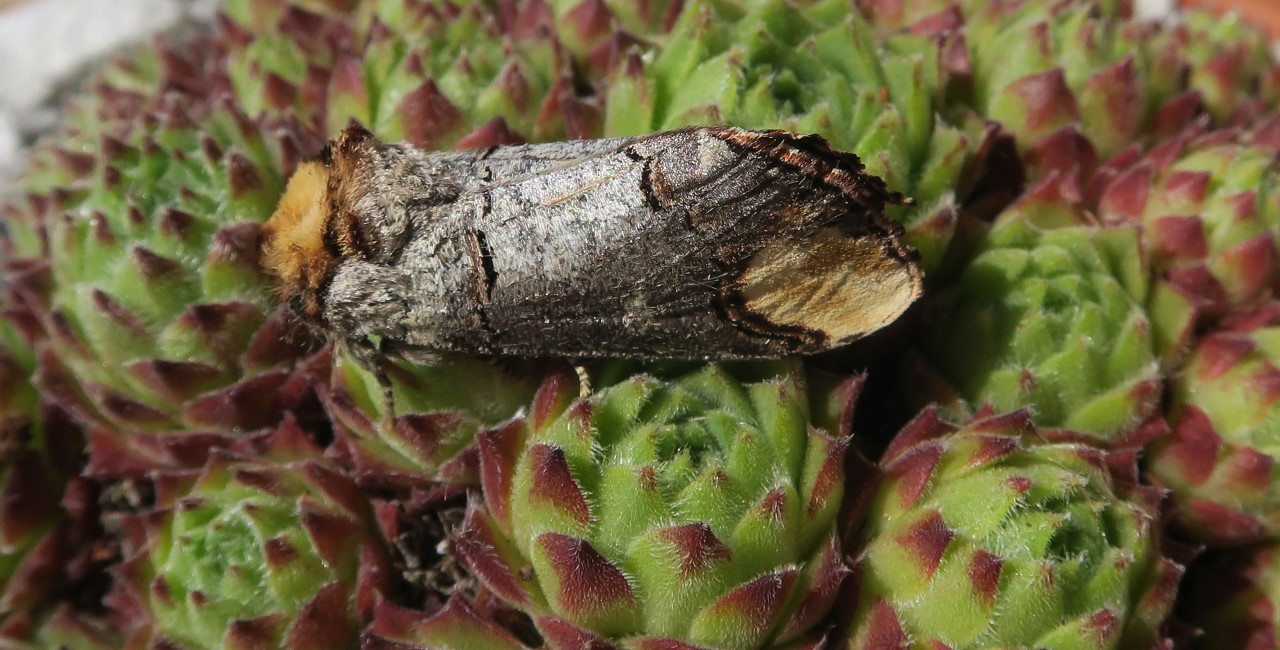 Buff-tip
Buff-tip
Altogether, there were 24 moths of 14 species, quite a respectable total for this time of year. The full list was: Buff-tip, Cream-spot Tiger (x3), Garden Carpet, Heart & Dart (x5), Hebrew Character, Knot Grass, Lychnis, Muslin Moth (m), Pale Tussock (m & f), Puss Moth, Shuttle-shaped Dart, Treble Lines (x4), White Ermine (m), Yellow-barred Brindle.
Moth Trapping, North Curry Garden, 9 May 2020
Stephen put the trap out on Saturday 9 May in his garden as a still, warm night was forecast, resulting in a catch that was diverse, if not numerous (11 moths of 11 species): Brimstone, Broken-barred Carpet, Common Marbled Carpet, Cream-spot Tiger, Dark-barred Twin-spot Carpet, Heart and Dart, Hebrew Character, Pebble Prominent, Shuttle-shaped Dart (F), Streamer and Treble Lines.
Stephen was particularly pleased to attract the Cream-spot Tiger, which was placidly sheltering behind the backing sheet. While it is not rare (it is classed as ‘local’), he has no record of seeing it before in the UK, so it was a nice find. Like all Tigers, it is on the flamboyant side due to its typical warning colouration.
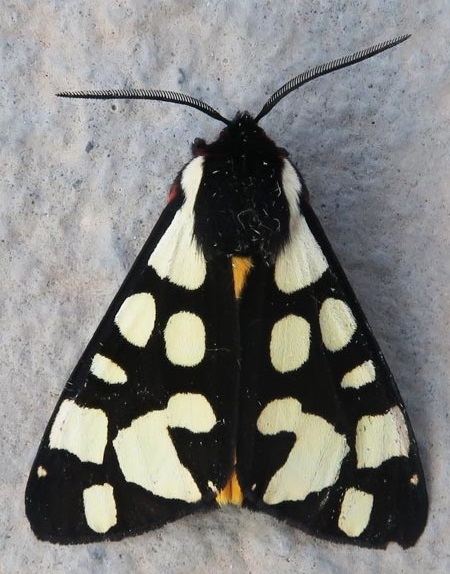
Cream-spot Tiger at rest
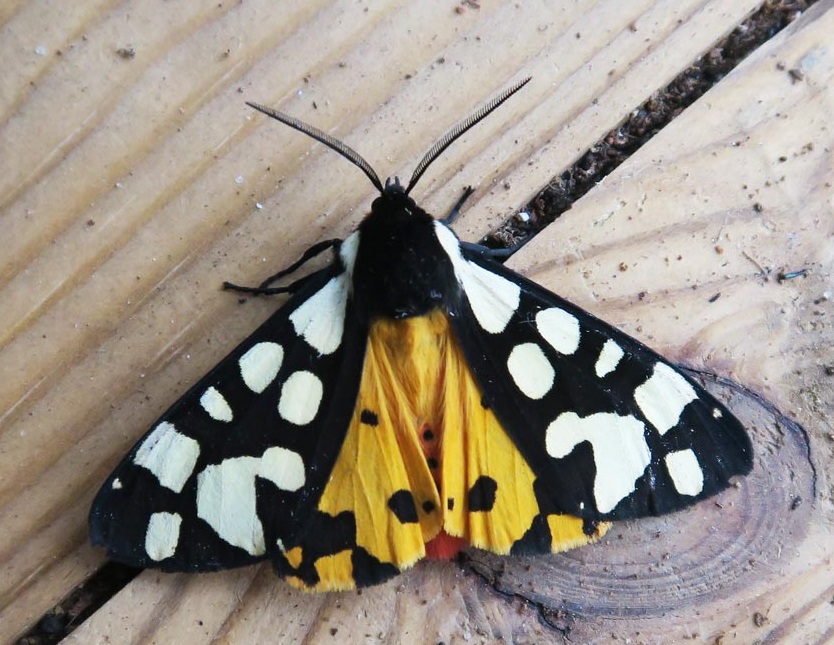 Cream-spot Tiger flashing a warning with its yellow and black underwing
Cream-spot Tiger flashing a warning with its yellow and black underwing
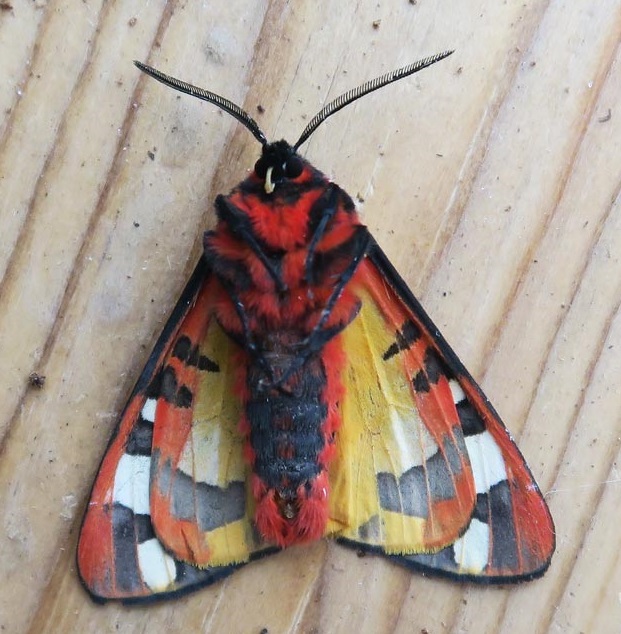 Cream-spot Tiger ‘playing dead’ (its second line of defence) and showing its gaudy underside
Cream-spot Tiger ‘playing dead’ (its second line of defence) and showing its gaudy underside
The Cream-spot Tiger is a moth which will rest quite visibly during the day, relying on its warning colouration to deter predators, so it worth keeping an eye open at the base of hedgerows.
Another Tiger which will rest in plain view during the day, and might at first glance be confused with the Cream-spot, is the Jersey Tiger which has been seen at the woodland and may be seen in gardens in summer.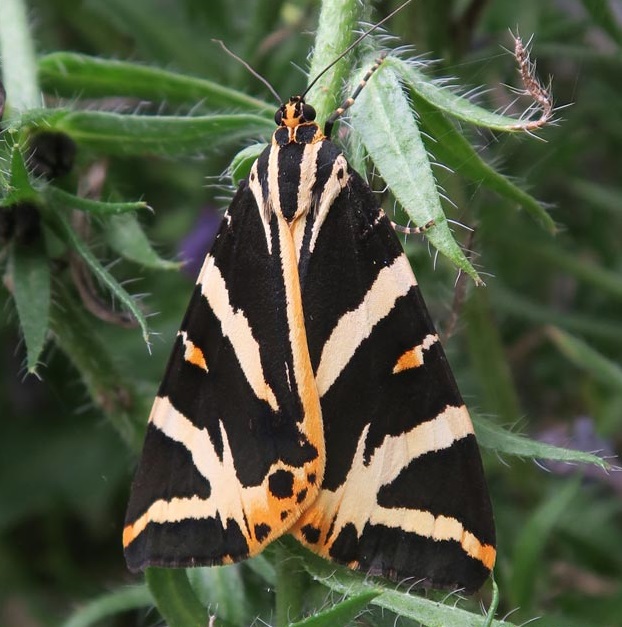 Jersey Tiger at rest during the day
Jersey Tiger at rest during the day
Moth Trapping, North Curry Garden, 24 April 2020
Stephen put the trap out in his garden again and trapped 5 moths of 5 species, including two moths characteristic for this time of year: the Muslin Moth (below left) and the Pale Tussock (below right ). Both are males as you can see from their fine antennae.
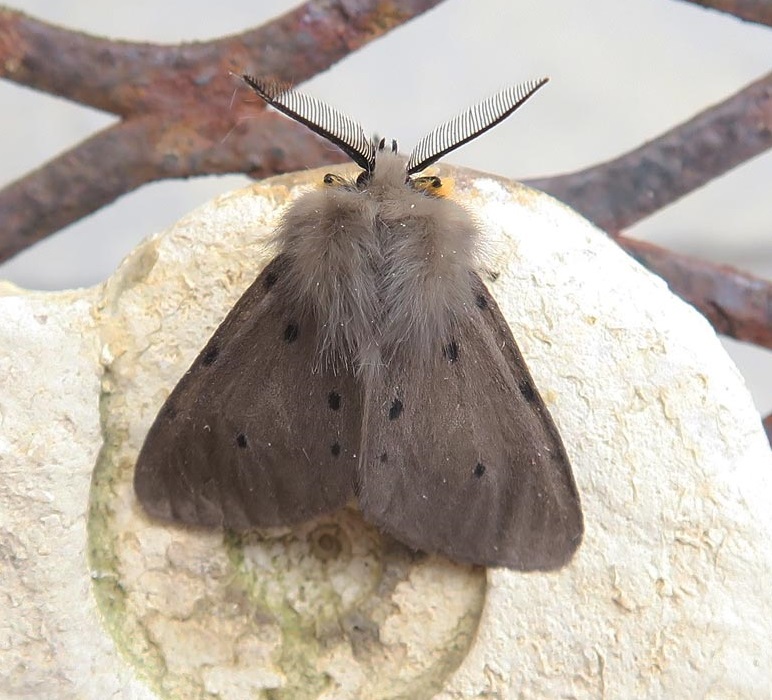
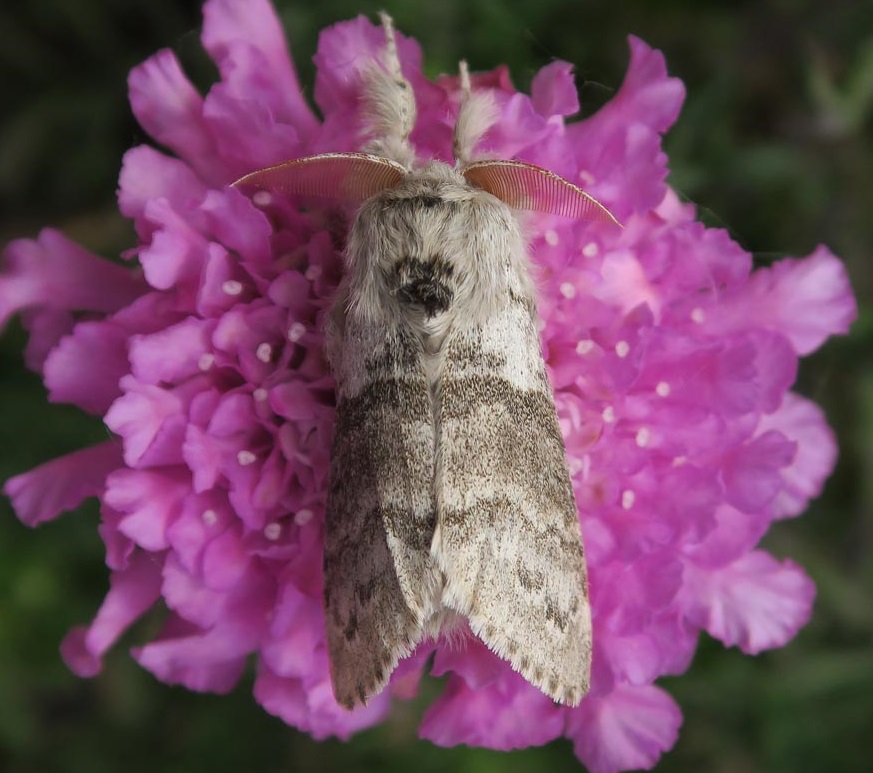
The female Muslin Moth has the same markings, but a totally different, white, ground colour. The Pale Tussock is showing his characteristic resting posture with furry forefeet pushed forward. Both species are often very placid moths which, if attracted to light and not disturbed, will rest like that for long periods.
Moth Trapping, North Curry Garden, 2 April 2020
Stephen put the moth trap out on 2 April in his garden for the first time since the autumn (conditions over the winter had been so wet and, above all, windy as to make it not worthwhile). Conditions were far from ideal and there was just one moth in the trap: a Hebrew Character, one of the early spring moths and a common one, but new to our list simply because of the time of year. The name derives from the apparent resemblance of its wing marking to a character in the Hebrew alphabet.
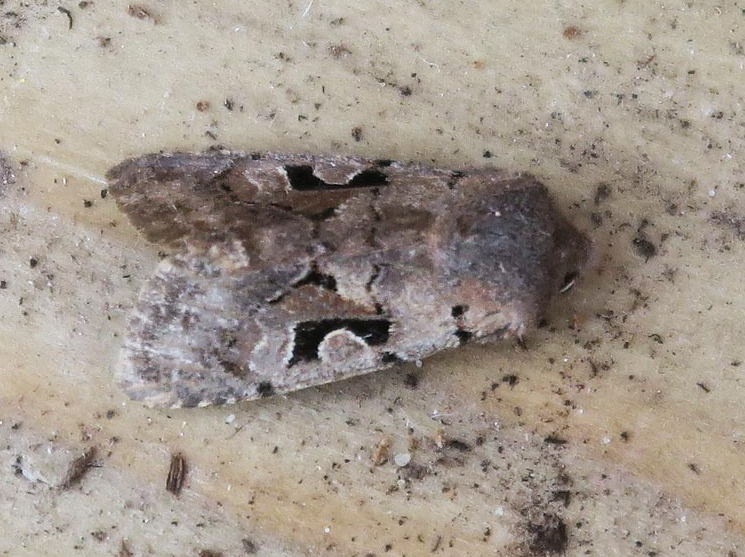 Hebrew Character
Hebrew Character
Later in the day, Stephen noticed another common spring moth, Common Quaker, which was probably attracted to the light but not trapped. Its name refers to the very plain, not to say drab, appearance of this moth, reminiscent of sombre Quaker dress.
Mothing, February 2020
We had intended to continue setting the moth trap throughout the winter at the Community Woodland, but incessant rain and wind prevented this. Nevertheless, Stephen encountered his first ‘proper’ moth of the year in his greenhouse on 29 February, the very attractive Angle Shades. This is a moth which has been recorded in every month of the year, probably with two broods and some immigrants, but this one was pristine and very early.
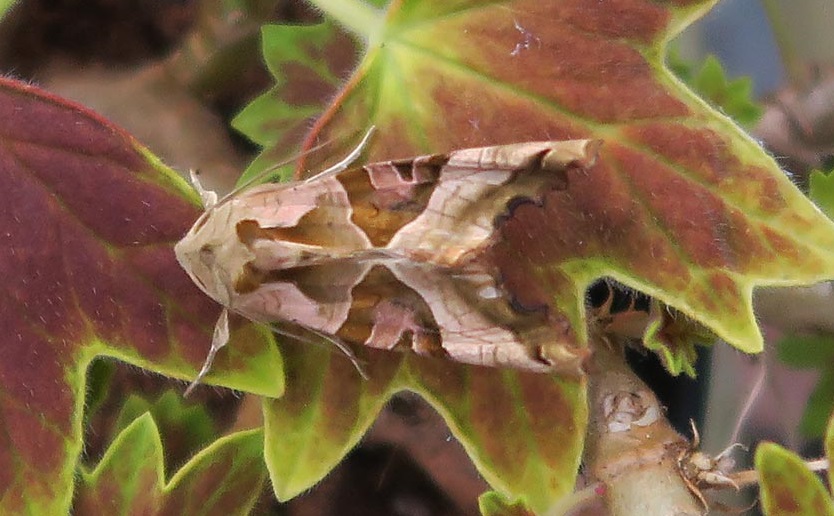 Angle Shades
Angle Shades
Moth trapping at the Community Woodland, 27 September 2019 (National Moth Night)
Text and photos by Stephen Locke
This was a quiet but worthwhile trapping and our contribution to National Moth Night at a time of inauspicious weather. We were grateful to the Met Office for the accuracy of their forecast which allowed us to choose the one reasonable evening of the three designated as Moth Nights. The wind died down and it was a clear night, chilly rather than cold (about 12 deg). Warmer and overcast would have probably encouraged more moths.
Nevertheless, among the small number attracted, we had several characteristic and distinctive autumn moths, including Sallow, Barred Sallow and, in the same family, Lunar Underwing, of which we had at least half-a-dozen specimens.
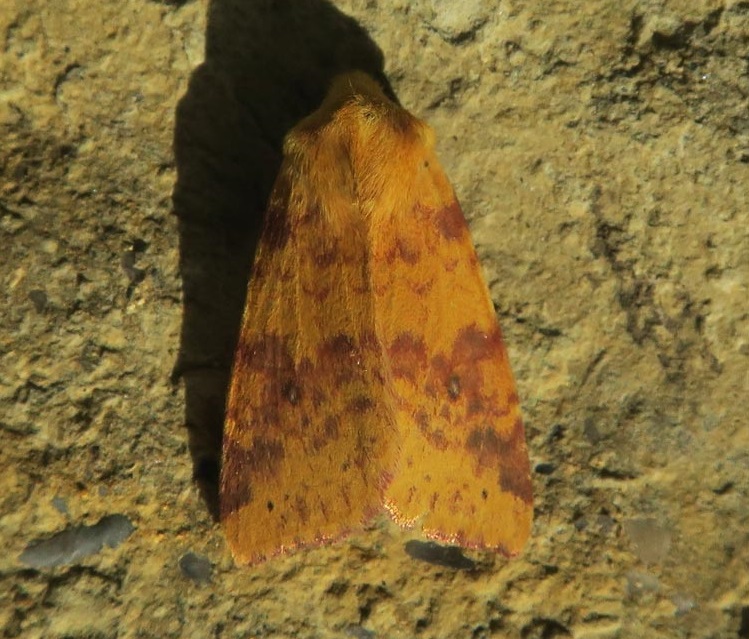
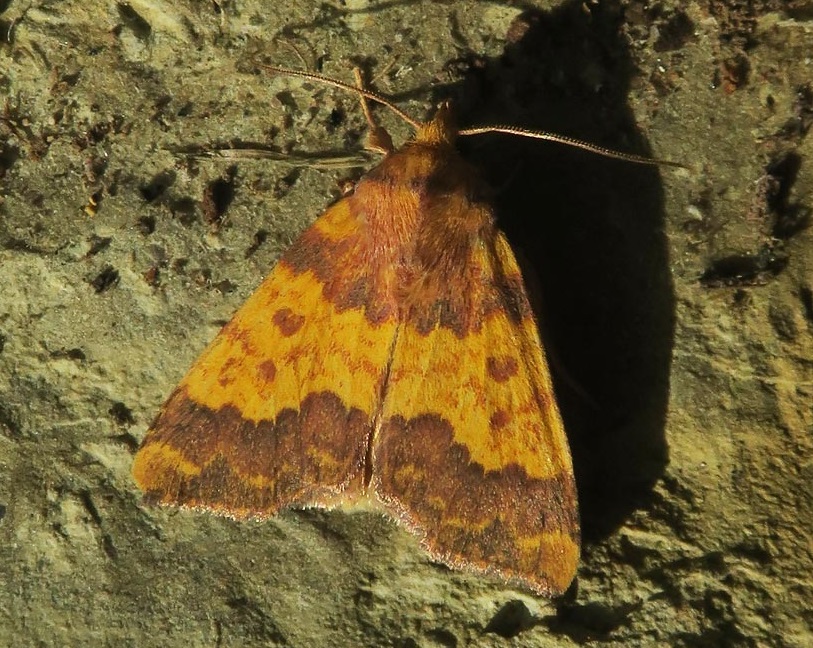 Sallow (left) and Barred Sallow (right)
Sallow (left) and Barred Sallow (right)
These join the Centre-barred Sallow which we had at the Community Woodland on 8 September (see below). All of them are moths of grassland, scrub, hedgerows and broad-leaved woodland and are autumn flyers, so they are just what you would expect.
Setaceous Hebrew Character, a very common and distinctive moth, was the most numerous moth of the night, although it was followed closely by the Lunar Underwing.
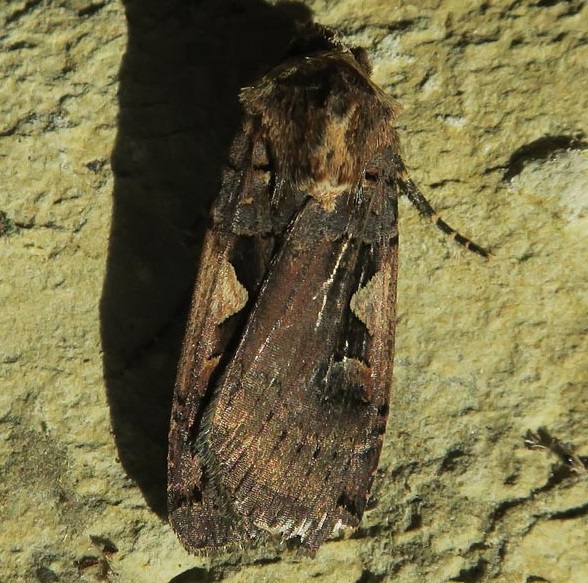
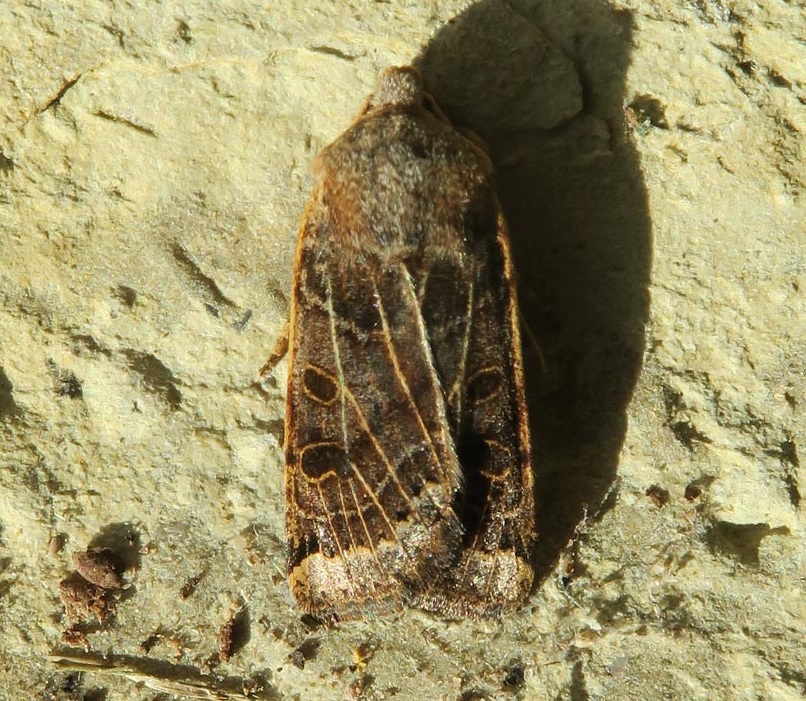 Setaceous Hebrew Character (left) and Lunar Underwing (right)
Setaceous Hebrew Character (left) and Lunar Underwing (right)
The full list was: Barred Sallow, Garden Carpet, Lunar Underwing, Sallow, Setaceous Hebrew Character and a Beauty (prob. Willow Beauty but too worn for confident id) (6 spp.), along with several very worn and unidentifiable LBJs.
Moth trapping at the Community Woodland, 8 September 2019
Text and photos by Stephen Locke
We ran the trap between 8.15 and 10.30 pm, with most activity occurring between 9 and 10 pm, but the results were rather sparse with just nine species recorded. The strong, three-quarter moon in a largely clear sky may have been a factor. Moonlight is often said to reduce catches, but since results often seem inconsistent it is not really possible to say.
The list that follows, however, does include two colourful and characteristic autumnal moths: Canary-shouldered Thorn and Centre-barred Sallow. The Canary-shouldered Thorn is aptly named, and all the common species of Thorn have now been recorded at the Community Woodland.
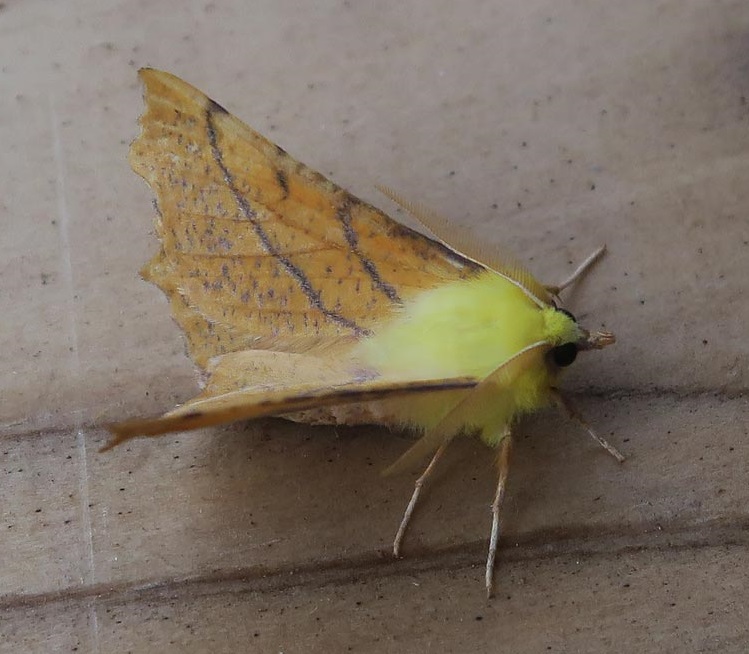 Canary-shouldered Thorn
Canary-shouldered Thorn
The larvae of the Centre-barred Sallow, despite its name, feed on the unopened buds of mature ash; those of the Canary-shouldered Thorn on a variety of trees.
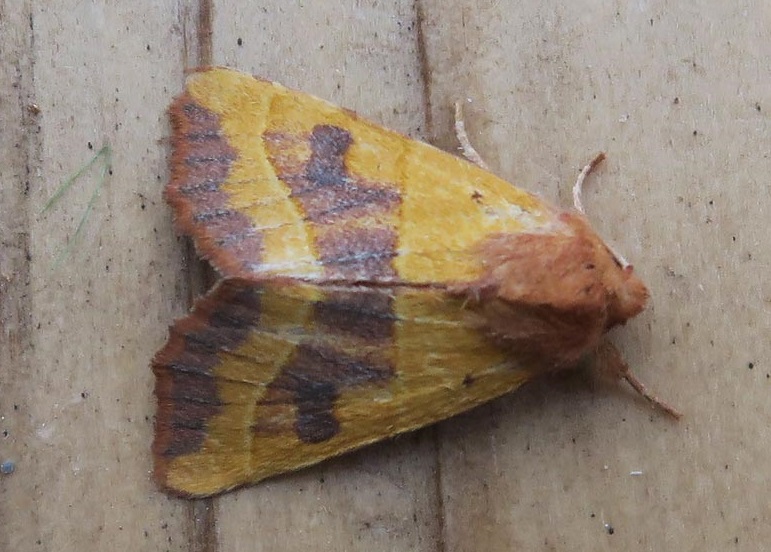 Centre-barred Sallow
Centre-barred Sallow
The full list of moths seen is: Brimstone, Canary-shouldered Thorn, Centre-barred Sallow, Common Wainscot, Dusky Thorn, Grey Chi, Large Yellow Underwing, Setaceous Hebrew Character (the name of this very common moth refers to the wing markings resembling a Hebrew letter), Square-spot Rustic (probably the most abundant moth of the night and a real LBJ!) (9 spp)
Moth trapping in a Queen Square garden, 24 August 2019
Text and photos by Stephen Locke
This session in a central North Curry garden produced a very good variety of moths. We ran the trap between 8.30 and 11.30 pm, with most activity being between about 9.15 and 11.00 pm, but there was plenty going on when we packed up.
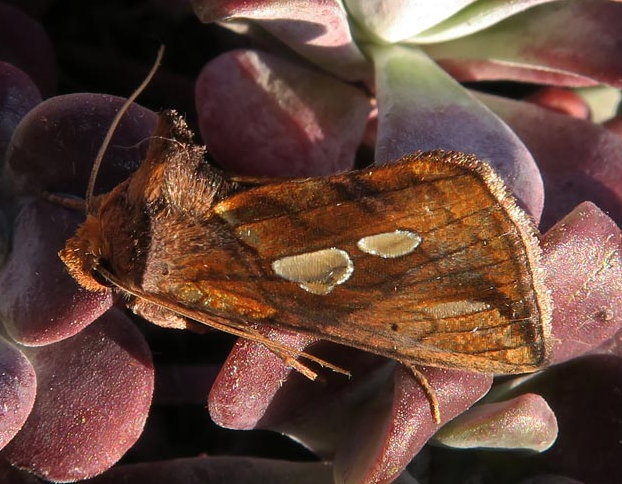
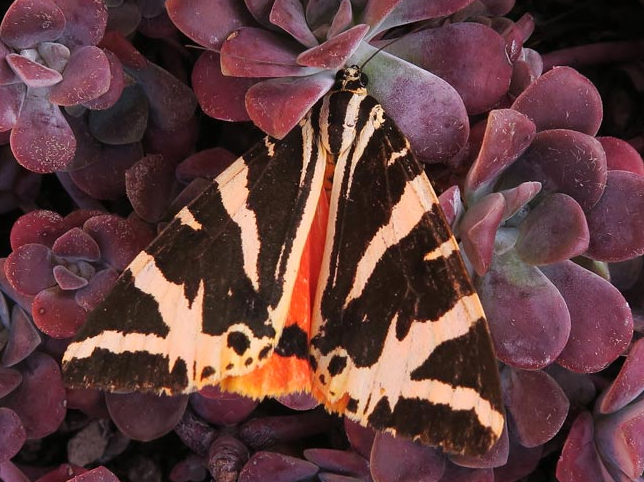 Gold Spot (left) and Jersey Tiger (right)
Gold Spot (left) and Jersey Tiger (right)
The list of moths seen is: August Thorn, Blood Vein, Brimstone (many), Chinese Character (looks like a conventional moth with its wings open - small, white with black markings - but an excellent mimic of a bird-dropping when at rest), Common Carpet, Common Footman (many), Common (or Dark) Marbled Carpet, Common Rustic, Common Wainscot (many), Dog’s Tooth, Flame Shoulder, Gold Spot, Green Carpet (fresh - they lose their green colour as they age), Jersey Tiger, Large Yellow Underwing (many), Lesser Broad-bordered Yellow Underwing (many), Light Emerald, Orange Swift, Poplar Hawkmoth (a truly noble moth), Rustic, Setaceous Hebrew Character, Silver Y (an immigrant and a common day-flier), Small Blood-vein, Square-spot Rustic, Vestal (another immigrant and a nice moth to find), Willow Beauty, Yellow Shell (27 spp).
The note ‘many’ simply records those which were particularly numerous.
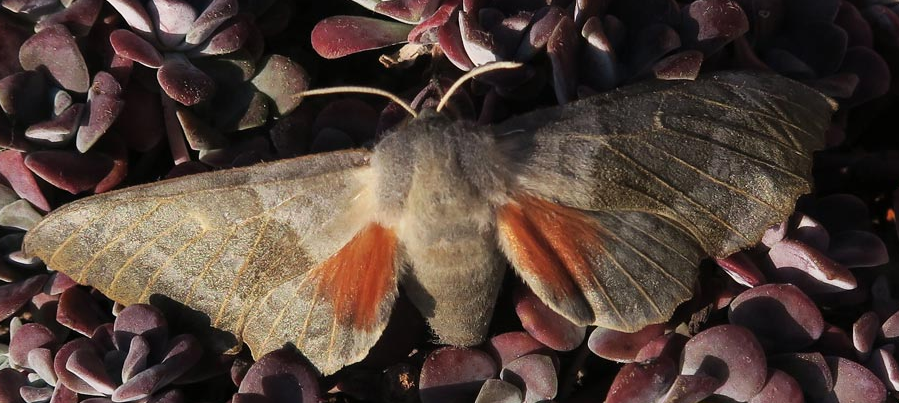 Poplar Hawkmoth
Poplar Hawkmoth
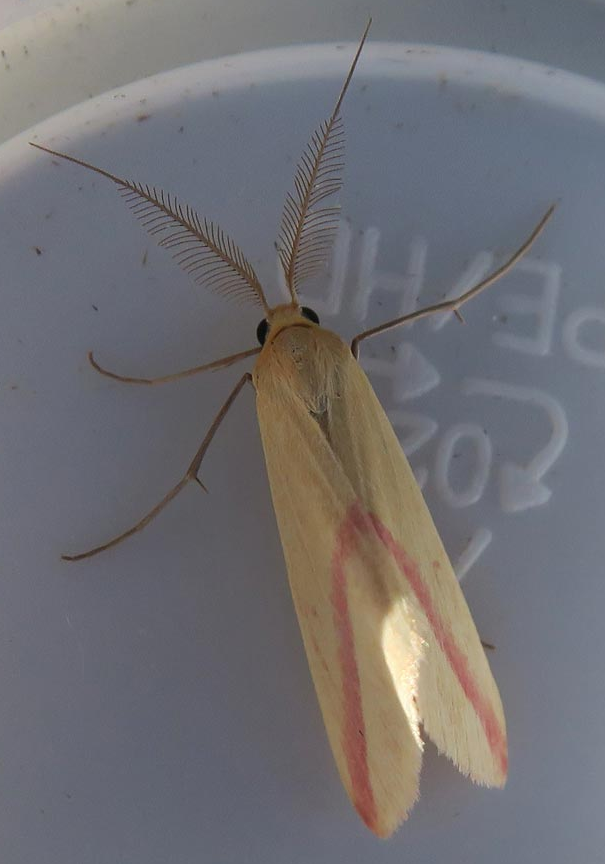 Vestal
Vestal
It is extraordinary to think of the delicate Vestal migrating from Europe.
Moth trapping at the Community Woodland, 3 August 2019
Text and photos by Stephen Locke
The moth trap was set up in the south-east corner of the woodland just off the path near the bird feeders. We ran the trap from 9.30pm to midnight.
The list of moths seen is: Brimstone, Common Carpet, Common Footman, Common Wainscot, Drinker, Flame, Jersey Tiger, Large Yellow Underwing, Lesser Broad-bordered Yellow Underwing, Lesser Yellow Underwing, Magpie, Oak/Northern Eggar (female), Orange Swift (male), Rosy Footman, Ruby Tiger (x7 in trap - more were seen but not trapped), Scorched Carpet, Shaded Broad-bar, Square-spot Rustic (18 spp.).
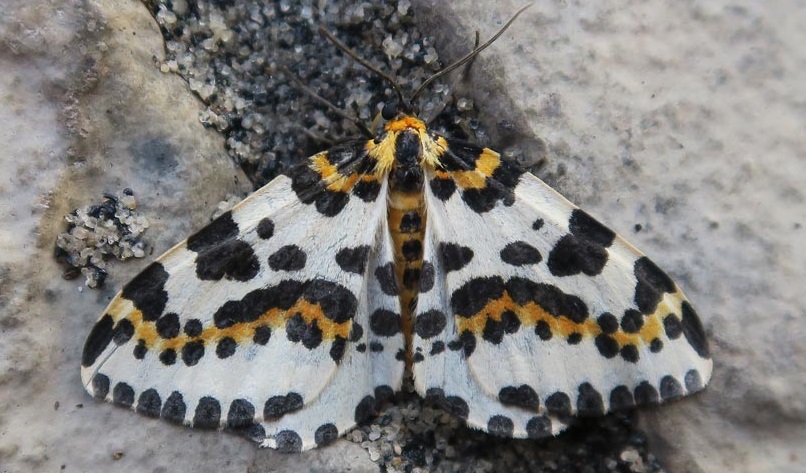 Magpie
Magpie
The ‘big moth’ of the night was Oak/Northern Eggar. The naming of this moth is complex and confusing. Northern Eggars are not confined to the north of Britain and for our purposes can be considered forms of the same species. There are differences in the larval life cycle related to what stage the larva over-winters and in colouration of the adult moth (the guide gives the darker colouration as Northern Eggar). But, whatever the name, it is a fine moth.
 1.jpg?timestamp=1565180568517) Oak/Northern Eggar (female)
Oak/Northern Eggar (female)
Numbers of Ruby Tiger continue high. The larva of the Orange Swift lives underground on the roots of vegetation.
.jpg?timestamp=1565180665524) Orange Swift (male)
Orange Swift (male)
Moth trapping at the Community Woodland, 25 July 2019
Text and photos by Stephen Locke
The moth trap was set up just off the path at the front of the orchard at the far end of the woodland. We ran the trap from 9.30 to midnight.
The list of moths seen is: Broad-bordered Yellow Underwing, Cloaked Minor (f. bicoloria), Clouded Border, Common Carpet, Common Footman (very numerous), Common Rustic, Common Wainscot (numerous), Drinker (several), Dusky Sallow, Early Thorn, Elephant Hawkmoth, Heart & Dart, Ingrailed Clay (prob.), Jersey Tiger, Large Yellow Underwing, Lesser Broad-bodied Yellow Underwing, Lesser Yellow Underwing, Mocha, Purple Bar, Rosy Footman, Ruby Tiger (very numerous - we may have seen approaching 50 - there were a dozen in the trap), Scorched Carpet, Sharp-angled Peacock, Small Fan-footed Wave, Willow Beauty (25 spp.).
 Ruby Tiger
Ruby Tiger
The moth of the night was Ruby Tiger for sheer numbers, but probably the most interesting moth was a Mocha, classed as nationally scarce B, the third highest category of rarity. The Mocha is very distinctive and so the identification unambiguous. Although a small moth, it has exquisite markings, and its occurrence at the woodland is exactly right both in general and in habitat.
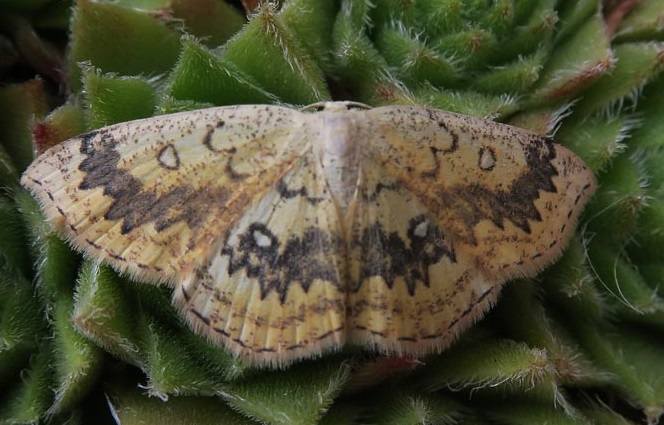 Mocha
Mocha
Moth trapping at the Community Woodland, 16 July 2019
Text and photos by Stephen Locke
The moth trap was set up in the south-east corner of the woodland just off the path near the bird feeders. We ran the trap for about two hours from 9.30 to 11.30 pm.
Many species of moth came to the light, but it was surprising that few species were caught in the trap during this time. Those caught were 6 Drinkers and a Common Footman, but the full list of moths seen in the two hours of trapping was: Broad-bordered Yellow Underwing, Common Footman, Common Wainscot, Coronet, Drinker (x>9), Elephant Hawkmoth, Lappet, Oak Hooktip, Riband Wave, Rosy Footman, Satin Wave, Scorched Carpet, Sharp-angled Peacock and Swallow-tailed Moth.
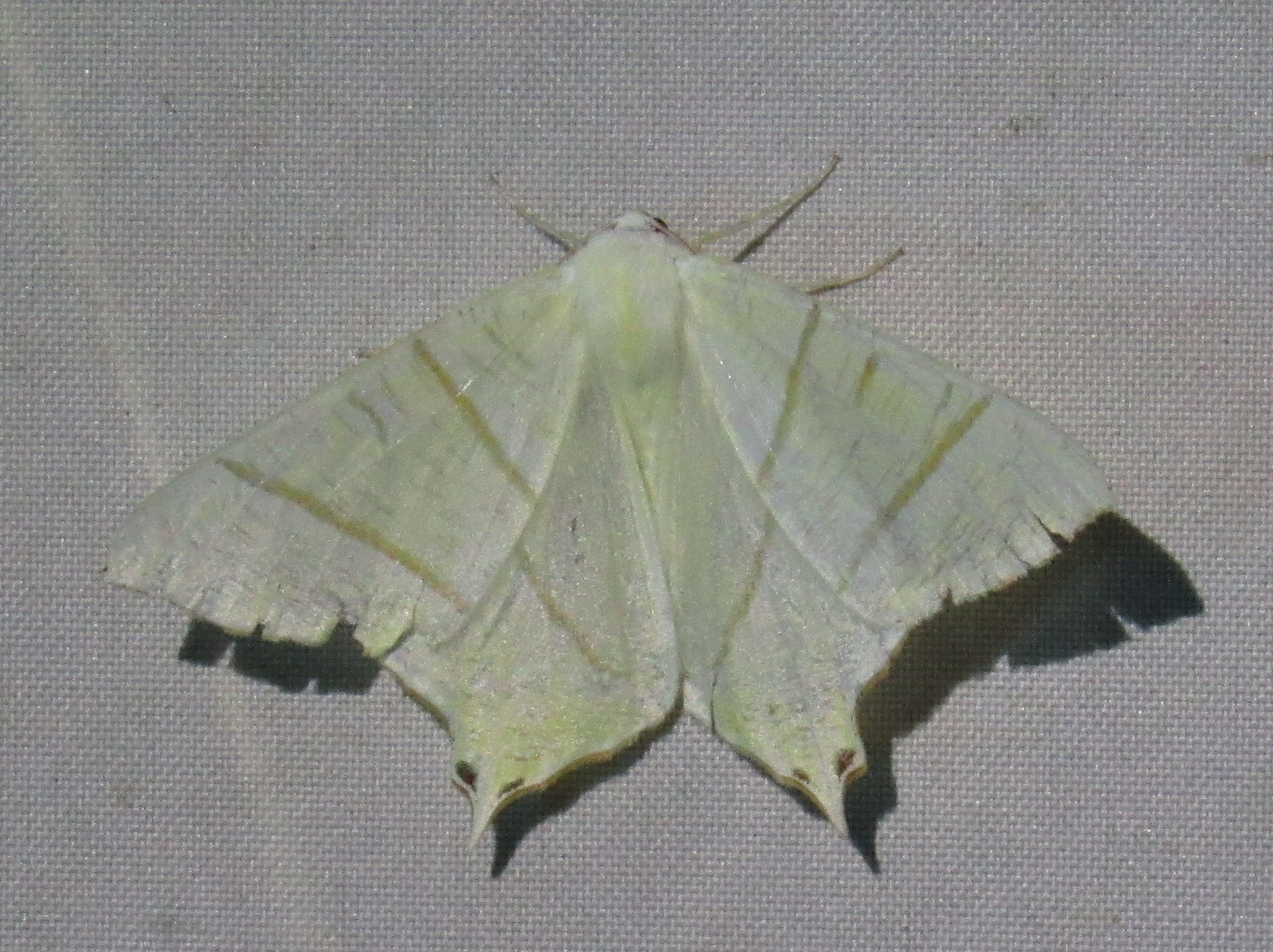 Swallow-tailed moth
Swallow-tailed moth
We also saw micro-moths but did not record them. The Lappet proved to be a female and laid eggs overnight.
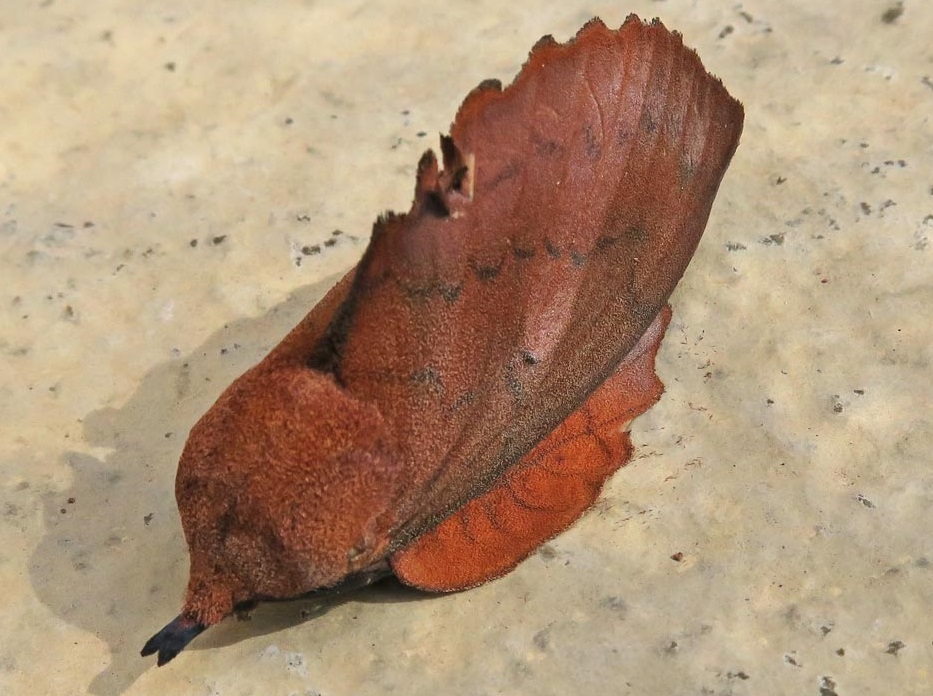
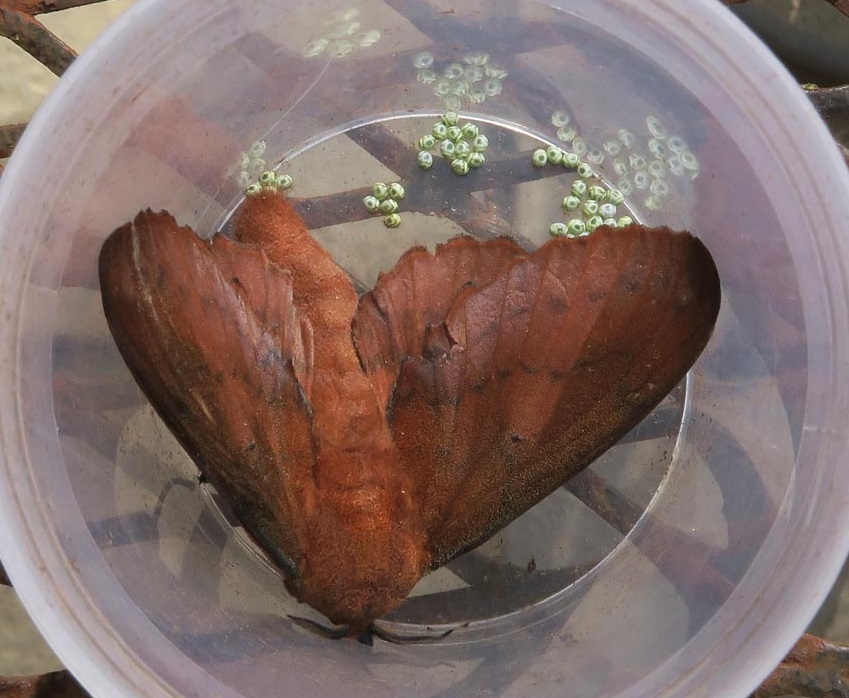
Lappet moth
Our results can possibly be explained by the fact that moths fly at different times of the night as well as different times of the year, and we might have trapped more moths had we trapped for longer. Some of the more common moths we might have expected are perhaps late flyers at this time of year. It is also possible that our torches distracted the moths from the trap as we saw a good variety while we were at the woodland.
The number of Drinkers was a surprising result. Their larvae feed on tall, coarse grasses and rushes and they prefer damp areas so the woodland is presumably a good area for them.
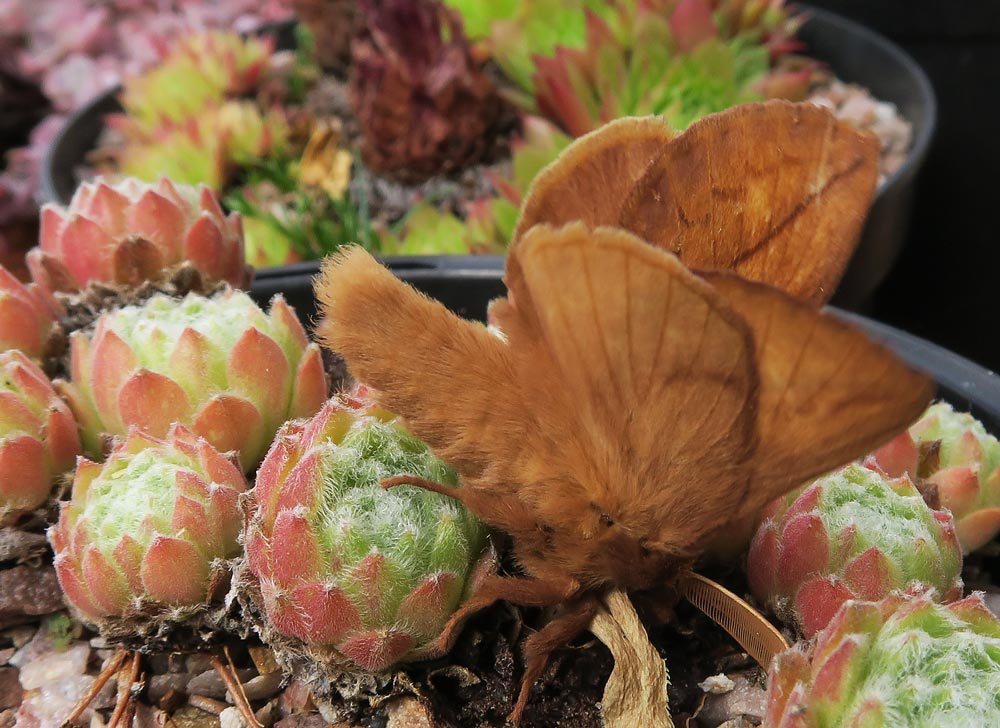 Drinker moth
Drinker moth
MOTH TRAP
Thanks to our award from the National Lottery Community Fund, we have been able to buy a moth trap so that we can discover which moths are visiting the Community Woodland and other areas of the village.
The group is very grateful to Stephen Locke for researching the most suitable moth trap for our needs and for obtaining a Skinner trap which is lightweight and portable and comes with a rechargeable lithium battery so that we can use it in places such as the woodland without a source of power. We set it up with a white backing sheet behind it as moths will come to rest on the sheet as well as fly into the trap and can be inspected if the trap is attended or if they are still resting there in the morning.
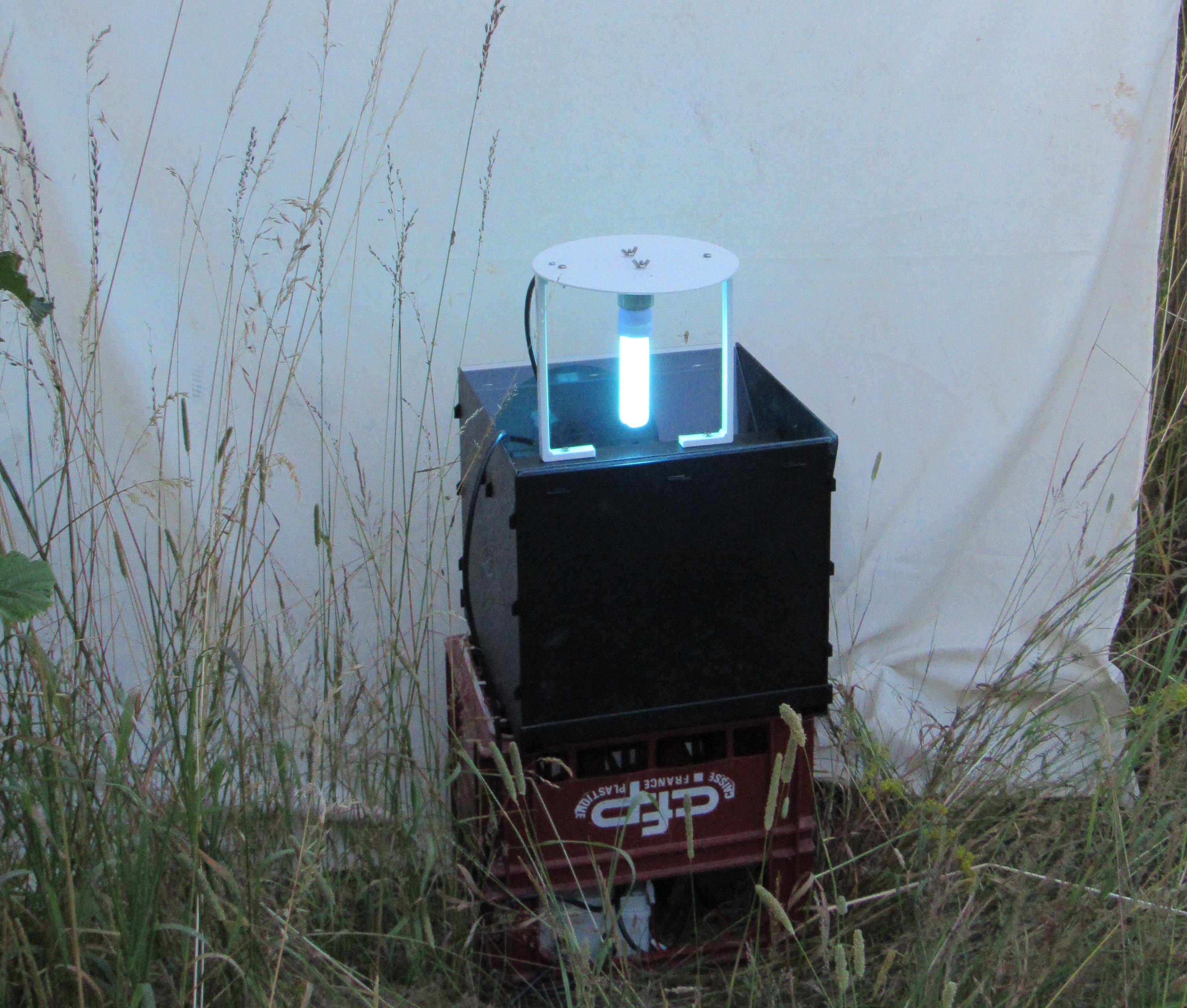
Skinner moth trap in situ with battery beneath it and backing sheet behind
We are planning to trap at the Community Woodland on a regular basis and at different times in order to ascertain the full range of species throughout the year.
MOTH LIST
The cumulative list of macro moths recorded in North Curry since July 2019:
Alder Moth, Angle Shades, August Thorn, Barred Hook-tip, Barred Sallow, Barred Straw, Beaded Chestnut, Beautiful Brocade, Beautiful Hook-tip, Black Rustic, Blood-vein, Blue-bordered Carpet, Bright-line Bright-eye, Brimstone, Brindled Beauty, Broad-barred White, Broad-bordered Yellow Underwing, Broken-barred Carpet, Brussels Lace, Buff Arches, Buff Ermine, Buff Footman? (very clear and strong orange margin), Buff-tip, Burnished Brass, Campion, Canary-shouldered Thorn, Centre-barred Sallow, Chinese Character, Cloaked Minor (f. bicoloria), Clouded Border, Clouded Silver, Common Carpet, Common Emerald, Common Footman, Common Quaker, Common (or Dark) Marbled Carpet, Common Rustic, Common Swift, Common Wainscot, Common White Wave, Copper Underwing, Coronet, Cream-spot Tiger, Currant Pug, Dark Arches, Dark-barred Twin-spot Carpet, Dark Brocade, Dark Chestnut (prob.), Dark Sword-grass, December Moth, Dingy Footman, Dog’s Tooth, Dot Moth, Dotted Chestnut, Drinker, Dusky Brocade?, Dusky Sallow, Dusky Thorn, Early Grey, Early Thorn, Elephant Hawkmoth, Eyed Hawkmoth, Feathered Thorn, Figure of Eighty, Flame, Flame Shoulder, Flounced Rustic, Foxglove Pug, Garden Carpet, Garden Tiger, Gold Spot, Green-brindled Crescent, Green Carpet, Green Pug, Grey Chi, Grey Dagger, Grey Shoulder-knot, Heart and Club, Heart and Dart, Hebrew Character, Ingrailed Clay (prob.), Iron Prominent, Jersey Tiger, July Belle, Knot Grass, Lappet, Large Yellow Underwing, Latticed Heath, Leopard Moth, Lesser Broad-bordered Yellow Underwing, Lesser Cream Wave, Lesser Yellow Underwing, Light Emerald, Lime-speck Pug, Lunar Underwing, Lychnis, Magpie, Maiden’s Blush, Marbled Green, Marbled Minor, Merveille du Jour, Middle-barred Minor, Miller, Mocha, Mottled Rustic (prob.), Mottled Umber, Muslin Moth, Nutmeg, Nut-tree Tussock, Oak/Northern Eggar, Oak Hook-tip, Orange Moth (m), Orange Swift, Pale Mottled Willow, Pale Prominent, Pale Tussock, Pebble Prominent, Peppered Moth, Poplar Hawkmoth, Privet Hawkmoth, Purple Bar, Puss Moth, Red-line Quaker, Red Underwing, Riband Wave, Rosy Footman, Rosy Rustic, Ruby Tiger, Rustic, Sallow, Satin Wave, Scalloped Oak, Scarlet Tiger, Scorched Carpet, September Thorn, Setaceous Hebrew Character, Shaded Broad-bar, Shark, Sharp-angled Peacock, Shoulder-striped Wainscot, Shuttle-shaped Dart, Silver-ground Carpet, Silver Y, Six-spot Burnet, Six-striped Rustic, Small Blood-vein, Small Dusty Wave, Small Eggar, Small Elephant Hawkmoth, Small Fan-footed Wave, Small Square-spot, Small Yellow Wave, Snout, Spectacle, Spruce Carpet, Square-spot Rustic, Straw Dot, Straw Underwing, Streamer, Swallow-tailed Moth, Treble Brown Spot, Treble Lines, Uncertain, Vestal, Vine’s Rustic, Waved Umber, White Ermine, Willow Beauty, Yellow-barred Brindle, Yellow Shell, Yellow-tail (176 spp.)
In addition, recorded micro moths: Apple Ermine, Light Brown Apple Moth, Mother of Pearl, Small Magpie, Water Veneer (5 spp).